

Uncover the Best Time to Visit Tahiti (Pros & Cons Per Month)
“I’m going to Tahiti!” It’s a phrase that everyone hopes to say at least once in their lifetime (hopefully more!) Oddly enough, it can be a little confusing because although ‘Tahiti’ can refer to the entire destination of multiple neighboring islands, it is only 1 of 118 islands that make up the 5 distinct island groups of French Polynesia.
Geography lesson aside, one of the top things to consider when visiting this tropical destination is the best time to visit Tahiti. Honestly? Anytime at all!
Ok, ok, there’s a little more to it than that, of course. But, if you’re not picky and just want to get yourself there to enjoy the crystal clear turquoise lagoons and overwater bungalows, then it’s just a matter of booking a ticket.
However, for those that may be a bit more discerning, there are better times and worse times to go depending on your goals and desires for your adventure.
Don’t leave home without: Lonely Planet Tahiti & French Polynesia Travel Guide
Discover the Best Time to Visit Tahiti
Table of Contents
First things first! Taking a vacation of any kind is an investment of your hard-earned money and the last thing you want is to risk a disruption or cancellation that ends with you losing that investment. This is one of the reasons we never leave home without travel insurance.
This is especially important if you’re planning a trip to Tahiti during the rainy season. Strong Pacific storms can crop up really fast causing trip delays, cancellations, or if you’re already there, the need to leave sooner than you planned.
There are a lot of options out there for insurance, but we use and stand by Allianz Travel Insurance . Full disclosure, we receive financial compensation as ambassadors for their company.

That said, we’ve been purchasing plans through them for the past 7 years and they have never let us down. Canceled flights, delayed flights, lost luggage, rental car damage, and a global pandemic, they’ve been there for us.
When people are standing at the counter fighting with the airlines over hotels or new flights, we don’t stress anymore because we know that we will be reimbursed for any out-of-pocket expenses caused by the delay.
We always renew their AllTrips Premier annual plan that covers all of our trips over a 12-month period. If you take more than 2 trips a year, it’s worth considering an annual plan.
For single trips, we recommend looking at their OneTrip Prime or OneTrip Premier plans.
Dry Season in Tahiti
Despite the overall air and sea temperatures only ever fluctuating by a minimal few degrees, there are two distinct seasons in Tahiti: wet and dry (with minimal shoulder seasons on either side.
The dry season is between June and October.
Despite its name though, just because the dry season gets less rain than its counterpart, does not necessarily mean it gets no rain. Keep this in mind as you plan your trip – there’s a reason why a place like Tahiti stays so lush and green year-round!
June in Tahiti

June marks the beginning of winter for Tahiti. That means the tradewinds begin to blow, bringing a calm wind across the islands that gently banish what remains of the oppressive humidity of summer. Wind-dependent sports become super popular around this time.
Average Temperature (high/low): 84F/70.2F
Average Rainfall: 2.4 inches
Pros of visiting in June:
- Overall temperatures and rainfall drop significantly; air quality will be near its best
- Perfect time to try out kitesurfing or charter a sailboat
- If it does rain, it’s usually a quick affair
Cons of visiting in June:
- High season rates make everything more expensive
- Summer crowds from around the world begin to arrive
- For those who were hoping for an adult-exclusive vacay – there can be lots of children out with their families
July in Tahiti

Just like for those accustomed to the Northern Hemisphere’s seasons, it’s actually the middle of summer for most of the foreign countries that frequently have patrons going to French Polynesia. As such, tourist density becomes quite heavy during July.
This will be the priciest, most busy month to visit. It is best advised to avoid this month if you can. Especially if you’re planning a special event of any kind or are looking for a quiet vacation.
Average Temperature (high/low): 82.9F/69.4F
Pros of visiting in July:
- Sunshine is a commodity that is not in short supply
- If you’re lucky, you may see whales out past the barrier reefs
- The underwater citizens of Tahiti’s lagoons tend to be their most abundant
Cons of Visiting in July:
- Everyone and their uncle will be swimming at the local beaches
- The first choice for accommodations and rental equipment is hard to come by
August in Tahiti

If you want to be in Tahiti in what is arguably the most popular month, you’ll need to plan and book your adventure sometimes a year in advance. August is the peak of the high season.
We generally advise people to consider shoulder season travel to avoid crowds and high prices. I think these days we could also say to keep your sanity.
Average Temperature (high/low): 82.8F/68.9F
Average Rainfall: 1.9 inches
Pros of visiting in August:
- Humpback whales migrate to Tahitian waters in earnest, which makes viewing them an easy and wonderful spectacle
- The weather is as perfect as you can get in the South Pacific
- Rain is practically nonexistent
Cons of visiting in August:
- You won’t have anything to yourself near the water
- Everything is at its most expensive
- There can be many families with children out and about
September in Tahiti
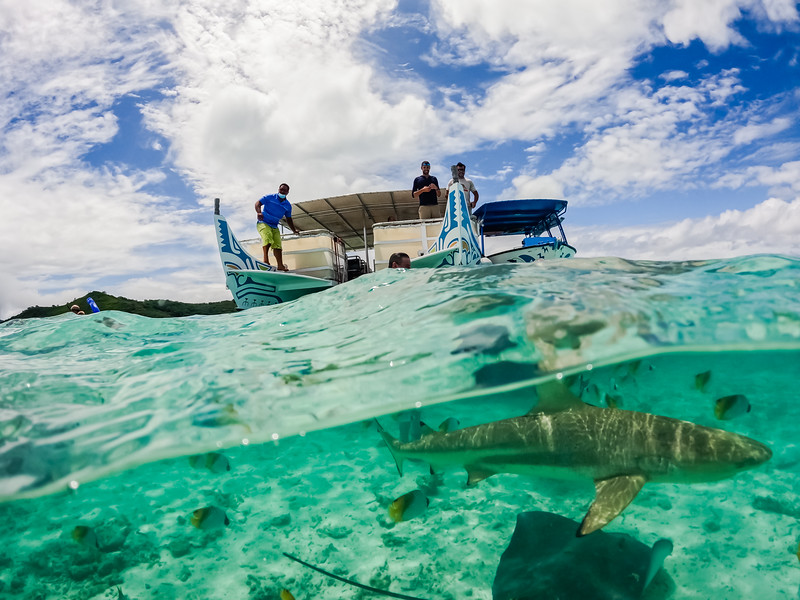
September shares many similarities to August, with perhaps fewer other people that you’ll need to fight tooth-and-claw for rooms, tours, restaurants, and space. It can be a nice alternative to full shoulder season and your chances of fewer rain storms are good.
Average Temperature (high/low): 83.5F/69.8F
Average Rainfall: 1.8 inches
Pros of visiting in September:
- At times, the weather can be even better than August’s
- Accommodation is a little easier to come by compared to previous months.
Cons of visiting in September:
- It’s still the high season, with all its expectations
- Plane flight costs will remain high
If you take one thing away from this Tahiti post book a Private Arrival Transfer: Papeete Airport to Hotel or Cruise Port or a Shared Departure Transfer: Hotel or Cruise Port to Tahiti International Airport
October in Tahiti

October is the final month of the dry season! This means it’s also still peak season, though it’s beginning to not be and you can luck out on some cheaper rates near the end of the month.
It’s also you last chance to catch the more reliably dry weather, as the average rainfall doubles from October to November.
Average Temperature (high/low): 84.4F/71.4F
Average Rainfall: 3.6 inches
Pros of visiting in October:
- Consecutive bright, sunny days remain an abundant commodity
- As the month nears its end, the population of tourists begins to dwindle
Cons of visiting in October:
- Rainy days begin to noticeably increase in frequency towards the end of the month
Rainy Season in Tahiti
Opposite of the dry season is the rainy season which covers the months between November and April.
The rainy season will receive much more precipitation than the dry by a factor of almost 4 to 5 depending on the year. If you’re in search of clear skies, then you’ll want to think hard about visiting during the rainy season.
November in Tahiti

November marks the start of spring in the islands. With that comes some cheaper accommodation, thinning crowds, and relatively stable weather. That said, the average rainfall does double from October, especially as you get later in the month.
One thing to consider is that late November, coinciding with the USA Thanksgiving holiday week, is a high-season spike for Tahiti. Accommodation will be sold out well in advance, along with day tours, and be quite expensive. There will also be an influx of people, so keep that in mind.
Average Temperature (high/low): 85.1F/72.7F
Average Rainfall: 6.4 inches
Pros to visiting in November:
- Accommodation rates are strikingly lower post-peak season
- The Hawaiki Nui Va’a, a one-of-a-kind canoe race, takes place in November
- Most of the crowds have left by this time
Cons of visiting in November:
- Precipitation amount almost doubles from October
- Humidity begins to noticeably increase as well
- There will be some unusual crowds following the Hawaiki Nui Va’a
December in Tahiti

Rainfall doubles in volume yet again from the previous month, and often rivals January for the wettest month on the calendar. You’ve been warned!
That said, there is a beauty to visiting a place when few others do. If lounging in the sun isn’t your thing, this can be a beautiful time of year to scuba dive and take in the lush beauty of the islands.
Average Temperature (high/low): 85.6F/73.6F
Average Rainfall: 12.5 inches
Pros of visiting in December:
- Low season means low rates!
- All the rain brings some of the best flower blooms to Tahiti
- On the nice days you have, you’ll probably have them to yourself
Cons of visiting in December:
- Mosquitoes enmasse seemingly appear out of thin air
- Thick humidity can be a bit uncomfortable at times
- When it rains, it can be for days on end
January in Tahiti

January is often the rainiest month on the calendar throughout the year. And with it comes plenty of humidity and mosquitoes. Depending on the length of your trip, plan on the weather being a bit unpredictable.
Average Temperature (high/low): 86.5F/74.1F
Average Rainfall: 12.4 inches
Pros of visiting in January:
- Hot weather will make all water sports and activities much more enjoyable
- Being in the middle of the low season (summer) means great rates all around
- You’ll often have many popular spots all to yourself
Cons of visiting in January:
- It can rain for days on end
- Storms will ruin most attempts to be outside for extended periods of time
- Poor weather can make it colder than expected – bring a jacket!
Our recommended top resorts in Papeete, French Polynesia:
- Le Tahiti by Pearl Resorts
- Hilton Hotel Tahiti
- Te Moana Tahiti Resort
- Hotel Tahiti Nui
February in Tahiti

The second month of the year brings with it just a little less water pouring from the skies, the tiniest bit more heat, and another reason for most of the tourists to stay away.
That said, this is off season travel at its finest! You’ll grab some amazing deals both on air and hotels.
Average Temperature (high/low): 86.9F/74.3F
Average Rainfall: 9.2 inches
Pros of visiting in February:
- The deals of the off season keep coming, with discounts often available at premium resorts
- Plane flights can be their cheapest at this time
- When the sun shines, which it will often, you won’t be fighting for room in the lagoons
Cons of visiting in February:
- Skies can be covered with clouds, even when rain isn’t present
- The outer seas can get a bit choppy with storms passing by
- Humidity remains very high
Our recommended top resorts in Moorea:
- Hilton Moorea Lagoon Resort & Spa
- Sofitel Kia Ora Moorea Beach Resort
- Manava Beach Resort & Spa Moorea
- InterContinental Tahiti Resort & Spa
March in Tahiti
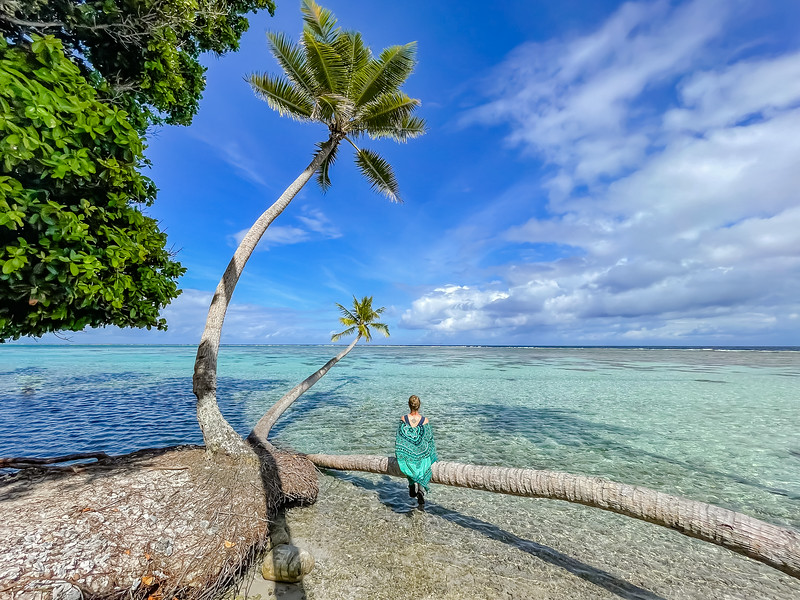
Though it’s the tail end of summer, it’s the hottest month of the year for Tahiti. Thankfully, the humidity begins to abate as we head into the first shoulder season of the year.
Average Temperature (high/low): 87.4F/74.3F
Average Rainfall: 7.7 inches
Pros of visiting in March:
- Tahiti’s lagoons are at their most warm and relaxing at this time
- You can score one of those overwater bungalows for super inexpensive.
Cons of visiting in March:
- The UV index will be strong – wear extra sunscreen and reapply frequently! You will burn very easily.
- Hot weather brings unpredictable storms that can hit randomly
Our recommended top resorts in Bora Bora:
- The St. Regis Bora Bora Resort
- Four Seasons Resort Bora Bora
- InterContinental Le Moana Bora Bora
- Conrad Bora Bora Nui
- Le Meridien Bora Bora
April in Tahiti

This is the beginning of the shoulder season just after summer; in between wet and dry seasons. April can be one of the best times to visit Tahiti overall!
Average Temperature (high/low): 87.1F/73.9F
Average Rainfall: 5.5 inches
Pros of visiting in April:
- Humidity and rainfall are much less than the summer
- Everything is still cheaper, while the weather reaches its ideal conditions
- Big crowds have yet to arrive
- Tahiti Pearl Regatta festivals begin
Cons of visiting in April:
- Heavy rainfall can still be expected at times
- You’ll be sharing spots with other shoulder season fanatics
Our recommended top resorts in the Society Islands:
- Ninamu Resort
- Le Taha’a by Pearl Resorts
May in Tahiti

May falls into the shoulder season as well, and it has many of the same reasons as to why it’s the best time to visit Tahiti. One could argue that it’s perhaps even better than April!
Average Temperature (high/low): 85.8F/72.5F
Pros of visiting in May:
- The weather is as close to the ideal dry season as possible without having the same crowds
- Depending on the year, the Tahiti Pearl Regatta may also begin around this time
- Humidity becomes practically nonexistent
Cons of visiting in May:
- Rain is uncommon, but if it does decide to pour it’ll likely be intense
This article is sponsored by Allianz Travel Insurance. As ambassadors we receive financial compensation. However, all opinions, stories, advice, and insane love for the Islands of Tahiti are 100% ours, as always.
You might also like:
- Ultimate Trip to Tahiti with Windstar Cruises
- 38 Beach Essentials: The Ultimate Beach Packing List
- How to Choose the Best Dry Bag for Your Next Adventure
- The Best Travel Towels for your Next Trip
Did you like this story? Share it!
Travel planning resources, about lina stock.
Lina is an award-winning photographer and writer that has been exploring the world since 2001. She has traveled to 100 countries on all 7 continents. Member: SATW, NATJA, ATTA, ITWA
Leave a Comment Cancel reply


- Big Island of Hawaii
- Cook Islands
- French Polynesia
- New Zealand
- Tahiti, Moorea, Bora Bora
- My Favorites
- My Specials
- Best honeymoon destinations
- Best time of year to visit Tahiti
- Best time of year to visit Fiji
- Best time of year to visit the Cook Islands
- Best time of year to visit St. Lucia
- Best time of year to visit Vietnam
- Best time of year to visit Thailand
- Best time of year to visit Bali
- Best time of year to visit New Zealand
- Best time of year to visit Australia
- Best time of year to visit the Seychelles
- Best time of year to visit the Maldives
- Best Jamaica all-inclusive resorts
- Best Fiji all-inclusive resorts
- Overwater bungalows
- Detailed visa requirements by country
- Tahiti, Bora Bora, and Moorea Destination Weddings
- Fiji Destination Weddings
- Best resorts in Tahiti, Bora Bora, and Moorea
- Best resorts in the Dominican Republic
- Best resorts in Fiji
- Best resorts in Jamaica
- Best resorts in Kenya
- Best resorts in New Zealand
- Best resorts in the Seychelles
- Hawaii - Maui
- Hawaii - Kauai
- Hawaii - Big Island
- Hawaii - Oahu
- Dominican Republic
- Puerto Rico
- St. Kitts and Nevis
- St. Maarten
- Turks and Caicos
- Virgin Islands - US
- Virgin Islands - British
- Bali & Indonesia
- Ask an Expert
Testimonials from Teresa's clients:
Best time of year to visit tahiti, moorea, and bora bora.
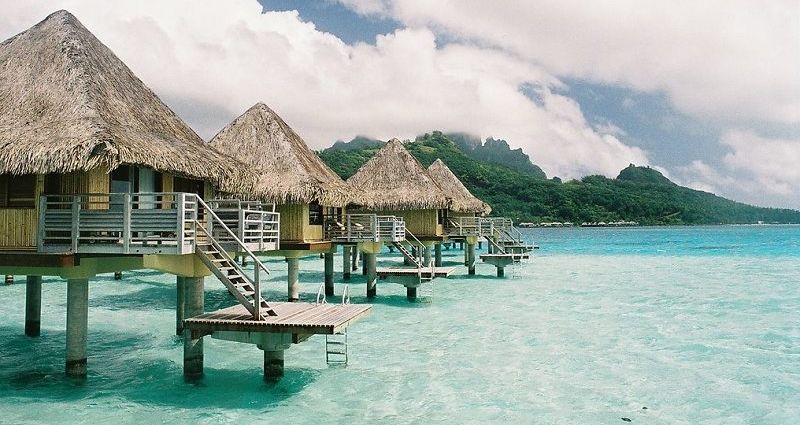
- Compare islands
- Expert's tips
- Travel specials
- See all resorts in French Polynesia
- Temperature by month
- Precipitation by month
- High/low season air & hotel prices
- Overwater vs. beach vs. garden bungalows
- Scuba diving & snorkeling
- Things to see & do
- Polynesian shows
- Map of all resorts & islands
Tahiti Vacation Planning
Which islands should we visit in french polynesia.
Having been to Tahiti Nui, Bora Bora, and Moorea myself, I'd say that it's not just about the resorts, or even the islands themselves. You need to consider how you're going to get there from the main international airport in Papeete, on the main island of Tahiti Nui. Bora Bora, Le Taha'a, and the Tuamoto Atolls are going to require a plane flight, which adds significantly to your cost AND to the travel time. Moorea, on the other hand, is close enough that you can hop on a ferry boat from Papeete right after your plane lands, and be at your resort within about an hour, and at very little expense. And while the main island of Tahiti Nui has some nice resorts, the scenery and the resorts themselves generally don't really compare to Moorea, Bora Bora, etc. Most people stay on the main island at most a night or two, then head to one of the outer islands.
Tahiti Nui : 4 resorts ; very few overwater bungalows; shopping , food carts , Paul Gauguin Museum .
Bora Bora : 10 resorts , iconic views of Mount Otemanu , wide range of styles of accommodations, tons of overwater bungalows, privacy, luxury.
Moorea : 8 resorts , overwater bungalows, good range of accommodations from moderate to luxury, family-friendly, dolphins , golf , ATV tours , zip lines , swimming with sharks and sting rays , tons of activities on land and water, easy to get to.
Tuamotu Atolls : 4 resorts , moderate accommodations, a bucket-list quality scuba diving destination , remote and secluded.
Other islands : 6 resorts including Le Taha'a and The Brando , ranging from economy to ultra-luxury accommodations; overwater bungalows, privacy and seclusion.
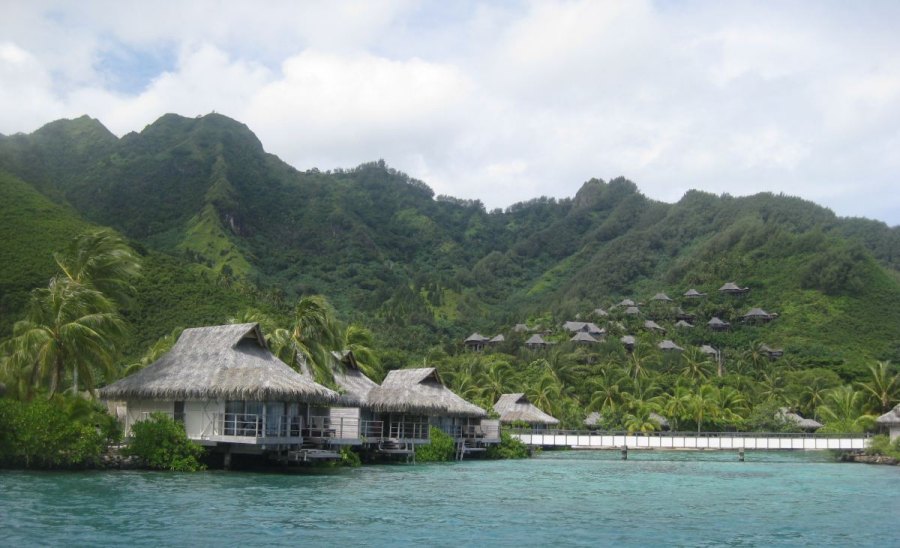
If you're trying to decide where to stay, we've got over 600 high-resolution photos, about 50 videos, and even some virtual tours. Or talk to one of our Tahiti experts, who know the islands and the resorts like the back of their hand :-).
Click here to see all resorts in French Polynesia.

Expert's Tips:
I've personally visited almost every resort on Tahiti Nui, Moorea, and Bora Bora, and seen all of the room categories, so that I have a first-hand understanding of the differences between them, as this helps match resorts to each of our clients. While I certainly have my own favorites, I believe that the notion of a "best" resort in Tahiti is a silly marketing ploy: best FOR WHOM? It depends so much on what the client likes.
- Interior style: some are very Polynesian, some have a very classic feel with antique furniture, some are opulent/luxurious with exotic woods and marble, some feel very modern and chic
- The grounds: some are totally flat, others have interesting hills and jungle bits, some feel very open, and others you wander through twisting paths in the jungle (one of them has a spa set in the middle of a lily pond!)
- Pools: some are more elaborate than others, with creative shapes, different views, etc.; some of the bungalows even have private plunge pools
- Dining: I never had a bad meal in French Polynesia--not even a mediocre one, but some resorts have a more expansive menu than others
- Condition: the photos from the hotels will always make the hotel looks its best--some of them have seen some wear and tear since the pictures were taken, so it's helpful to talk to someone who's seen the properties recently
- Location: you can snorkel from the deck of your overwater bungalow at any of the resorts--the difference is what you'll see underwater, as there's a radical difference in what's on the bottom near the bungalows from one property to the next
- Views: on Bora Bora, you'll get views of the spectacular Mount Otemanu from every resort--but, not necessarily every bungalow, as there are a few resorts on the main island (Otemanu is behind you then), and one resort with bungalows on the opposite side of the motu, facing west, away from Otemanu. On Moorea, you're not generally going to get views of the mountains from your bungalow, but you will on the walk back to the shore. And Huahine and Le Taha'a are their own little worlds.
See our complete list of travel specials for Tahiti, Moorea, Bora Bora, and the Tuamoto Atolls.
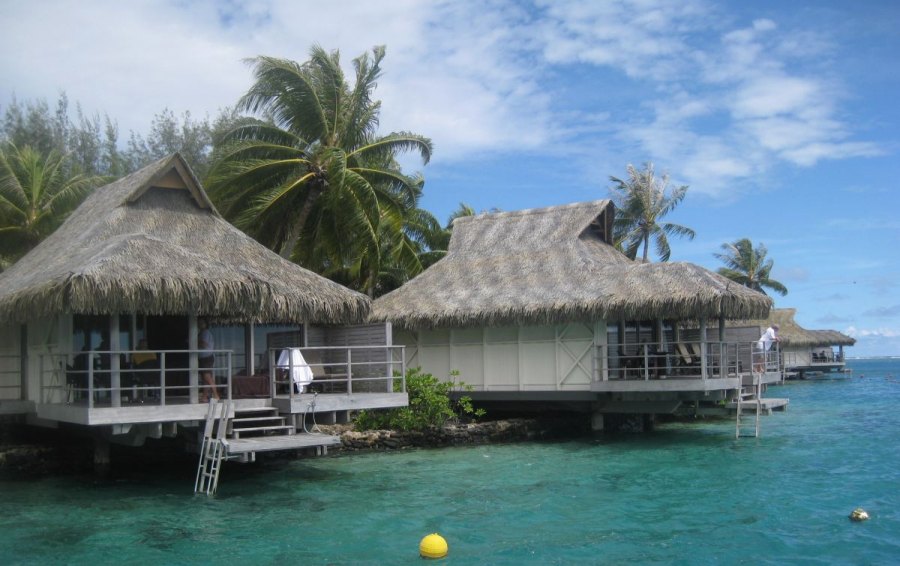
Tahiti Weather: High Season vs. Low Season
During the high season, temperatures are milder and there are fewer rain showers with less humidity, and better visibility for divers. However, there are two or three times as many tourists per resort – thus increasing demand for sightseeing activities and prices for lodging and events.
Throughout the slower months, the costs are lower and there is less competition for spots on popular tours. Additionally, just because it’s off season it doesn’t mean the sun completely disappears! Tahiti still receives warming rays, although consecutive days of rain are possible.
Tahiti Weather: Average temperatures
The annual average temperature in Tahiti is 80 degrees Fahrenheit, or 27 degrees Celsius. Closer to the equator, the Tuamotu Atolls and the Marquesas Islands have slightly warmer temperatures than Tahiti, Moorea and Bora Bora.
During the high season, or winter, temperatures range from 70-82 degrees Fahrenheit, while in the low season, summer, temperatures vary from 70-85 degrees Fahrenheit. December and January average 12 inches of rain a month, however, Tahiti receives more hours of sun than Hawaii during the comparable humid season. Less than three inches of rain fall per month from June through September.
Tahiti Weather: Average precipitation

Tahiti Weather: Storms in French Polynesia
The humid season in Tahiti is from November to April. Occasionally, strong storms do develop. There actually ARE NO hurricanes in Tahiti (or anywhere in the South Pacific ). That's not as good news as you might think--it's because they're not called hurricanes in that region, they're called cyclones :-). But there is good news: cyclones are rare, with the last powerful one occurring in 1982. You can get some pretty dramatic heavy rainfall however--during the humid season, it will often rain hard enough at night to wake you up.
High and Low Season Prices in Tahiti
The overall high season in French Polynesia extends from May 1 to October 31, although some resorts change their prices starting April 1. The low season covers November 1 to April 30.
Tahiti wholesalers--and the resorts themselves--are very active when it comes to special offers, discounts, extra inclusions, etc., and so these kinds of deals are changing all the time. Most websites aren't able to keep those specials up to date--there's just too many of them, and they're changing and expiring all the time. At Visual Itineraries, we track the offers from the major wholesalers daily , and our specialists have tools that show them all the available offers and discounts for a particular property instantly.
Typical airfares from LAX
Airfares vary by season, but also day of week, and are definitely affected by holidays. The chart above shows the typical minimum and maximum fares for a economy class ticket from Los Angeles (LAX) to Papeete (PPT), by month.

Overwater bungalow, or garden bungalow, or beach bungalow?
The garden and beach bungalows are typically going to be less of a trek from the main points in the resort.
- 4 nights in Moorea + 3 nights in Bora Bora
- 3 nights in Moorea + 3 nights in Bora Bora + 3 nights in the Tuamotu Atolls
Often, people will combine these with 1 night in Papeete, so you have a chance to see Marche Papeete, Les Roulottes, explore the town, shop for pearls, etc.
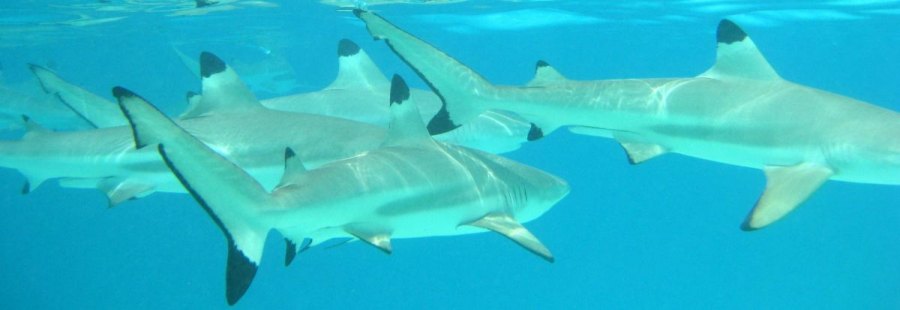
Water temperature, scuba diving and surfing in Tahiti
You'll find a terrific, detailed description of dive sites on the various islands in our friend and world super-traveler David Stanley's Tahiti guidebook (now in its 7th edition). Surfing is most abundant in Tahiti and Moorea and up-and-coming in Huahine. May is a popular surfing month, due to the Billabong Pro competition at Teahupoo in Tahiti.
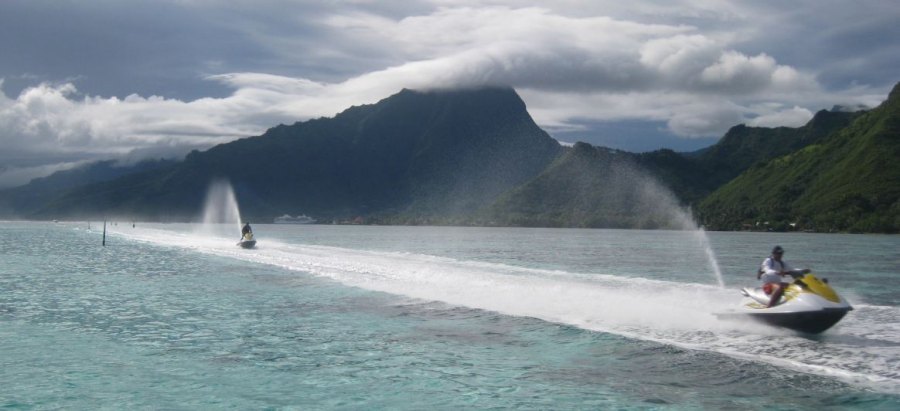
Things to see and do in Tahiti
Heiva is a month-long cultural celebration that comes from the Tahitian word for festival (hei = to assemble, va = community places). Given the various different activities and parties that stretch for the month of July, Heiva is a good enough reason in itself to visit Tahiti during the summer season! There is plenty to see and do, from the traditional dance and music performances, singing competitions, colorful dinners, and sports competitions (like javelin throwing, stone lifting, coconut tree climbing, and outrigger canoe racing).
Heiva has evolved over the years from its rich history--Tahiti's traditional dance, Ori Tahiti , was once central to Polynesian culture, but these centuries-old festivities were banned by 19th century Christian missionaries for being too sensual and erotic. In 1819, recent Christian convert King Pomare II officially forbade the practice; dancing became a clandestine activity in danger of being lost as both an art form and a key to Tahiti's past. But the festivities returned in 1881 as a result of France's victory over its long struggles with England and Protestant missionaries; the Polynesians adopted France's Bastille Day (July 14; the French equivalent of America's Independence Day) and had the opportunity to revive some of its dancing in celebration. Ori Tahiti finally saw a greater comeback in 1956 when a Papeete high school teacher, Madeleine Moua, led the true comeback of the traditional dance by forming the dance troupe Heiva Tahiti. Now, Ori Tahiti has resumed its rightful, vibrant place in French Polynesian culture, and the entire month of July is used for Heiva and its celebration of this history.
Fire Dancers
- We'll talk with you to find out what you're looking for, what you like/don't like, etc.
- We'll use our first-hand knowledge of the destination to pick out a handful of resorts we think you'd like
- We'll create a custom mini website for you, with photos, videos, maps, etc. of the resorts we are recommending
- We'll follow up with you to help you make your decision
- We'll go to work with our suppliers to get you the best deal available on what you've decided on.
Map of all Resorts in French Polynesia
Best Time To Visit Tahiti (Beautiful Weather and Island Activities)
Find out the best times to visit Tahiti for ideal weather and exciting island activities. Plan your trip during peak seasons for a memorable getaway.

For the perfect balance of romantic and relaxing, there’s no better place to travel to than Tahiti. This beautiful destination attracts around 300,000 tourists each year. If you want to plan a perfect island getaway, you may be wondering when the best time to visit Tahiti is.
Winter in Tahiti is from June through September, and this is one of the best time frames to book a trip. August usually gets the least rainy days, making it one of the most enjoyable months to visit. The winter months can be the most comfortable in Tahiti because you won't have to deal with the humidity.
If you’re ready to see beaches with black sand or dance under a Tahitian waterfall, you’ve come to the right page. Today, we’re going to talk about the best times to book a trip to Tahiti. We’re also going to break down some of the best year-round attractions. Keep reading to find out what they are.

When You Should Not Go To Tahiti?
The worst month to book a trip to Tahiti is in December. December is the rainiest month in Tahiti and it can be more humid.
Part of the fun of traveling to Tahiti is seeing its natural attractions and spending the day on the beach. It’s always disappointing for tourists if they are limited to indoor activities.
There’s another reason you might want to avoid Tahiti in December. A lot of people book island vacations around the holidays causing the resorts to fill up fast. The cost of flying and accommodations are a lot higher around the Christmas season as well.
What Is The Cheapest Month To Go To Tahiti?
February is the cheapest month to book a trip to Tahiti. This is perfect for travelers that live in a snowy part of the world and need a break from the freezing cold.
Most hotels and resorts have cheaper rates from November through April in Tahiti. There are family-friendly accommodations for as low as $77 per night.
The cheapest month to book the flight is in February, especially if you search for flights at least 4 weeks ahead of time (earlier is better for finding discounts). It is possible to find a round trip for under $650.
Best Time To Visit Tahiti: Monthly Breakdown
There’s no wrong time to visit Tahiti. You can plan an enjoyable trip any time of the year, but it helps to know what the island has to offer while you’re there. Let’s take a look at what makes each month great for traveling to Tahiti.
January: Best Month To Learn About Tahiti Culture

January is another humid and wet month in Tahiti, so there’s a good chance you may see a couple of rainy days during your stay . That doesn’t mean your trip to Tahiti is ruined, instead, it’s the perfect time to experience more of this island’s culture.
Tahiti has a very compelling art culture, with authentic dances, music, and art pieces. There are also a lot of artifacts exclusive to this island that draw people into the museum.
- Manua Exquisite Tahitian Art
- Museum of Tahiti and the Islands
- James Norman Hall Home
February: Best Month For A Romantic Getaway

If you’re planning a romantic getaway to Tahiti for Valentine’s day, one of the best ways to make your stay even more magical is by renting an over-water bungalow to stay in. The best places to find these accommodations are at the Tahiti La Ora Beach Resort and the Intercontinental Tahiti Resort and Spa.
The setting of these bungalows adds to the romantic atmosphere, as you can enjoy the sunset or sunrise from your own private area.
Another thing that adds to the beauty of this stay is that you can have things delivered to your bungalow by canoe. You can surprise your significant other with a Tahiti breakfast, flowers, or a gift.
- Day trip to a private moto islet
- Dinner and wine at Le Lotus
- Tahiti’s Spa Deep Nature
March: Best Month For Hiking

March is a considerably warm month, but there are mountainous areas of Tahiti where the heat isn’t as extreme. This is a great month for hiking along with one of the mountains because it’s not as wet as the previous months were.
Once your reach the peak of these mountains, you’ll be treated to memorizing views of the island. It’s also a great time of year to explore the nature trails.
- Papenoo Valley
- Hitiaa Lava Tubes
- Mount Aorai
April: Best Month For Exploring Lagoons

Tahiti has some of the most memorizing lagoons in the world. April is one of the best months to explore these areas because the month is filled with many hot sunny days.
You can enjoy the day relaxing by the lagoon and enjoying the view, or you can go on a snorkeling tour where you can see tropical fish and whales. It’s also a great time to visit waterfalls and blowholes.
- Tahiti Lagoon Paradise Tours
- Arahoho Blowhole
- Topatari Falls
May: Best Month For Great Weather

May is one of the nicest months for weather in Tahiti because it’s when the humid season has come to an end. There is less rain and many sunny beautiful days where you can enjoy your trip outdoors exploring the island and its attractions.
There are many beaches in Tahiti, some with black sand and others with white sand. We recommend May as one of the best months
to enjoy them because you won’t run into the busy tourist season.
- Lafayette Beach (black sand)
- Temae Beach (white sand)
- Authentic Moana Lagoon Excursion
June: Best Month For Visiting Tourist Attractions

Credit: Wikimedia Commons
One of the best months to enjoy the tourist attractions in Tahiti is in June. This is because the Tahiti winter season has started, giving you ideal weather conditions, but you don’t have to deal with the crowds from peak tourist season.
Whether you want to go on a day trip excursion or visit the local markets, this is one of the top months to do tourist activities.
- Aremiti Ferry
- Maraa Grotto cave
- Harrison W Smith Botanical Garden
- Tahiti Lagoonarium
Related Read: Do You Need A Passport To Go To Guam?
July: Best Month For Stargazing

Credit: Shutterstock
A highlight of visiting Tahiti is the night sky. Tourists love to spend the night sitting by the beach stargazing. The pollution level is very low on the island, allowing nothing to block the vision of the sky.
Since July is part of the dry season, there are more nights with clear skies, allowing tourists to spot the constellations of the Polynesian sky.
- Matira Beach
- Mahana Park
- Point Venus
Related Read: Best Time to Visit French Polynesia
August: Best Month For Snorkeling

One of the most exciting tourist activities in Tahiti is snorkeling. August provides the perfect weather conditions to spend the day discovering what’s in the ocean.
There are many great snorkeling tours with professionals that will take you out and show you what to do. Keep in mind, that this is the peak month of tourist season so you may need to arrange a tour ticket ahead of time.
- Sea Scooter Snorkel Tour
- Nautical Excursion and Aquatic Adventures in the Blue Lagoon of Paea
- Moorea Fishing Adventures
September: Best Month to Avoid Crowds While Sightseeing

September is a great month for a Tahitian vacation because you will still get the best of the weather while avoiding large crowds.
You will have a better opportunity to enjoy tourist attractions without having to spend more money on a private tour. This is also a great time to visit the natural attractions and take time to enjoy them.
- Whale watching tours
- French food at local restaurants
- Half-day or day cruises
October: Best Month To Enjoy Traditions

October in Tahiti hosts several traditional festivals and events. One of the most popular is Reva I Eimeo Nui, which is a truck tour featuring many traditional foods and ukulele players.
The International Graffiti Art Festival is also in October with many original displays to view.
- Watch stone-throwing competitions
- Enjoy Tahitian music
- Try local food
November: Best Month To Experience Off-Season

Rates around Tahiti begin to drop in November as tourist season ends and Tahitian summer begins. While November is more humid, it’s not as bad as the months to come.
This makes it an ideal time to take advantage of discounts on accommodation and popular tourist activities.
- Hawaiki Nui canoe races
- International Tattoo Festival
December: Best Month To Enjoy a Tropical Holiday
Of course, Christmas is different without cold weather and snow, but there’s something extra magical about Christmas in Tahiti.

Sections of the island are decorated to keep travelers in the holiday spirit. You may even get greeted by live carolers while you’re out and about in the shops.
- Visit gift shops
- Enjoy cakes for your Christmas feast
- Enjoy traditional Tahitian Christmas decor
Related Read: Best Time to Visit Bora Bora
When is the Best Time To Travel To Tahiti With Kids?

Tahiti is a family-friendly destination with fun to be had for people of all ages. The best months to travel to Tahiti with the family are when the kids are out of school in July or August.
We recommend this time because the weather is ideal for outdoor activities and you will be more likely to meet other families with kids at the resort.
73 Basic Dutch Phrases for Your Next Trip to Netherlands 🇳🇱
Learn essential Dutch phrases for a smooth trip to the Netherlands. Perfect for travelers looking to connect with locals and enrich their experience.
Win a $500 Flight!
Embark on the adventure of a lifetime! Enter our Dream Journey Sweepstakes for a chance to win a $500 travel voucher, redeemable with any major US airline. Whether it's sandy beaches, bustling cities, or tranquil mountains, your dream destination is just an email away!*
You may also like...

Best Time to Visit Lithuania for Seasonal Adventures & Local Festivals
Planning a trip to Lithuania and wondering when's the best time to go? You're in the right place. Lithuania, with its stunning landscapes and rich history, offers a unique experience no matter the season. But, if you're looking to make the most of your visit, timing is key.

Best Time to Visit Hungary: Seasonal Secrets for an Authentic Experience
Deciding when to visit Hungary can be tricky, but don't worry, we've got you covered. This beautiful country shines in every season, but knowing the best time to go can make your trip even more special.

Best Time to Visit Estonia: Discover a Winter Wonderland Like a Local
Deciding when to visit Estonia? You're in for a treat, no matter the season. But if you're looking for the best experience, timing is key. This Baltic gem offers something unique with each season, from white winters to sunny summers.

Best Time to Visit Armenia: Winter Wonderland & Cultural Fests Unveiled
Deciding when to visit Armenia? You're in for a treat! This hidden gem has got it all - from cool, snowy winters to warm, sunny summers. But to get the best out of your trip, timing is key. Let's dive into when's the perfect moment to pack your bags for Armenia.

Best Time to Visit Havana: Seasonal Guide for Cultural Festivities
Planning your dream trip to Havana? You're probably wondering when's the best time to pack your bags and go. Well, you're in luck because we've got the inside scoop to help you make the perfect choice.

Best Time to Visit Oaxaca: Uncover Seasonal Secrets & Local Celebrations
Deciding when to visit Oaxaca? It's all about finding the perfect balance. You want great weather, fewer crowds, and lots to do, right? Well, you're in luck because Oaxaca has got it all, but timing is key.
The travel site inspired by travelers and locals alike. Find amazing destinations, unique trip ideas, the best hotels, and most comfortable resorts.

- Austral Islands
- Marquesas Islands
- Easter Island
Best time to visit Tahiti: Choose your dates!
What is the best time to visit Tahiti? The Queen Island of French Polynesia can be visited at any time of the year. Its tropical climate guarantees warm temperatures between 25 and 32°C and the water temperature remains constant. Tahiti has a dry season and a wet season. Depending on the period, the price of a trip to Tahiti may decrease or increase.
November to April: Not the Best Time to Visit Tahiti
Expect frequent rain showers.
The southern summer is characterized by heavy and long rain showers. This period starts in mid-November and has a peak of rainfall in January . Despite some sunny spells, it can also rain all day. Tahiti is a high island with the highest mountain ranges in the archipelago. The peaks usually catch the clouds and when it is not raining, the sky often remains cloudy. Nevertheless, there will always be something to do when it rains in Tahiti .
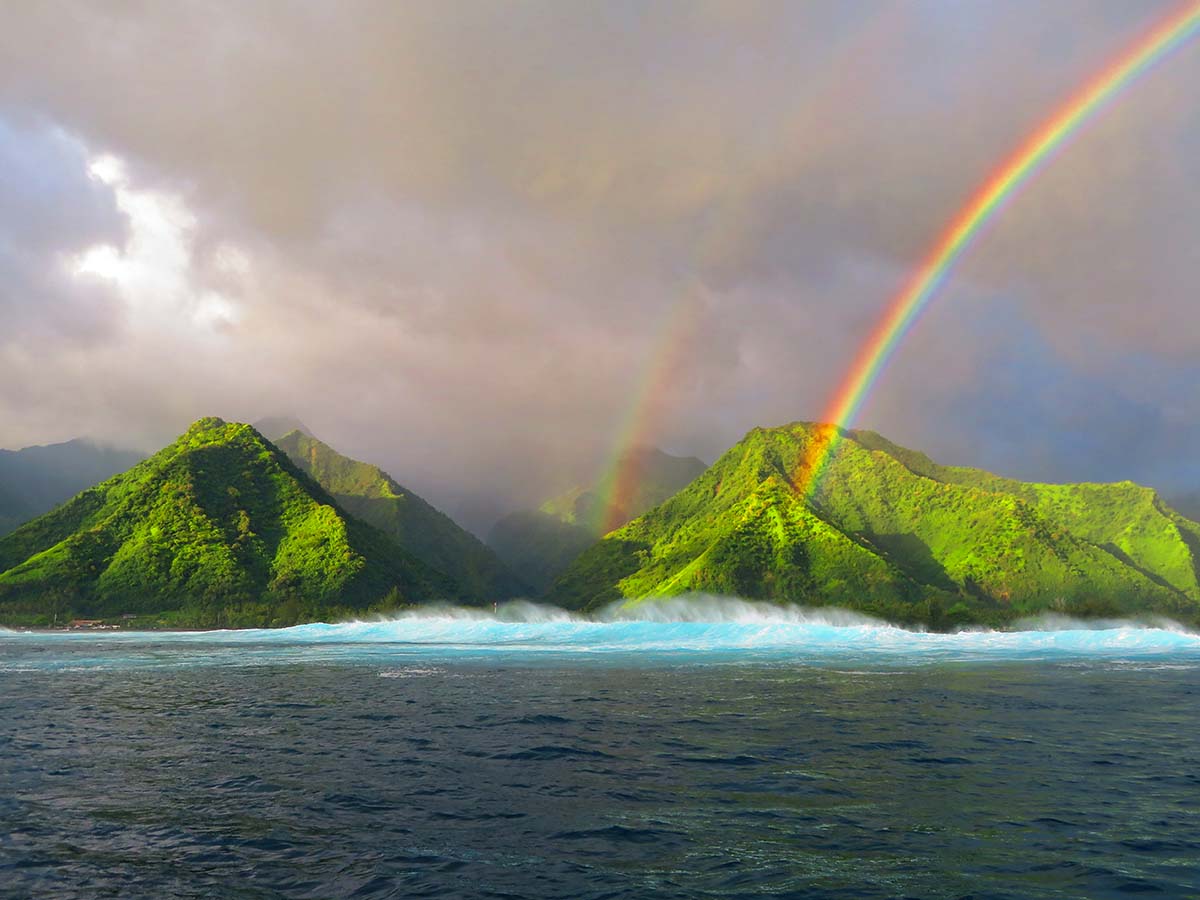
Less sun, more humidity and constant heat make December through March a time to avoid on a first trip to Tahiti. On the other hand, scuba divers will be able to observe aquatic fauna unique to this period and professional surfers will enjoy impressive waves.
A Cheap Period
With the exception of the holiday season, the wet season stands out for its significantly reduced prices . You will notice it in the transportation and accommodation costs. Indeed, flights to Tahiti are more affordable and luxury hotels offer interesting discounts. For example, the price of bungalow rooms can be cut in half.
The cultural life in Tahiti does not stop. Some local festivities can be discovered at the House of Culture in Papeete. At the end of November, Polynesian dance enthusiasts should not miss the annual Hura Tapairu competition at the Grand Théâtre. An interesting fusion between tradition and modernity. Other visitors will attend the International Oceanian Documentary Film Festival in February each year.
May to June: An Advantageous In-Between Time
Going to tahiti when the sun returns.
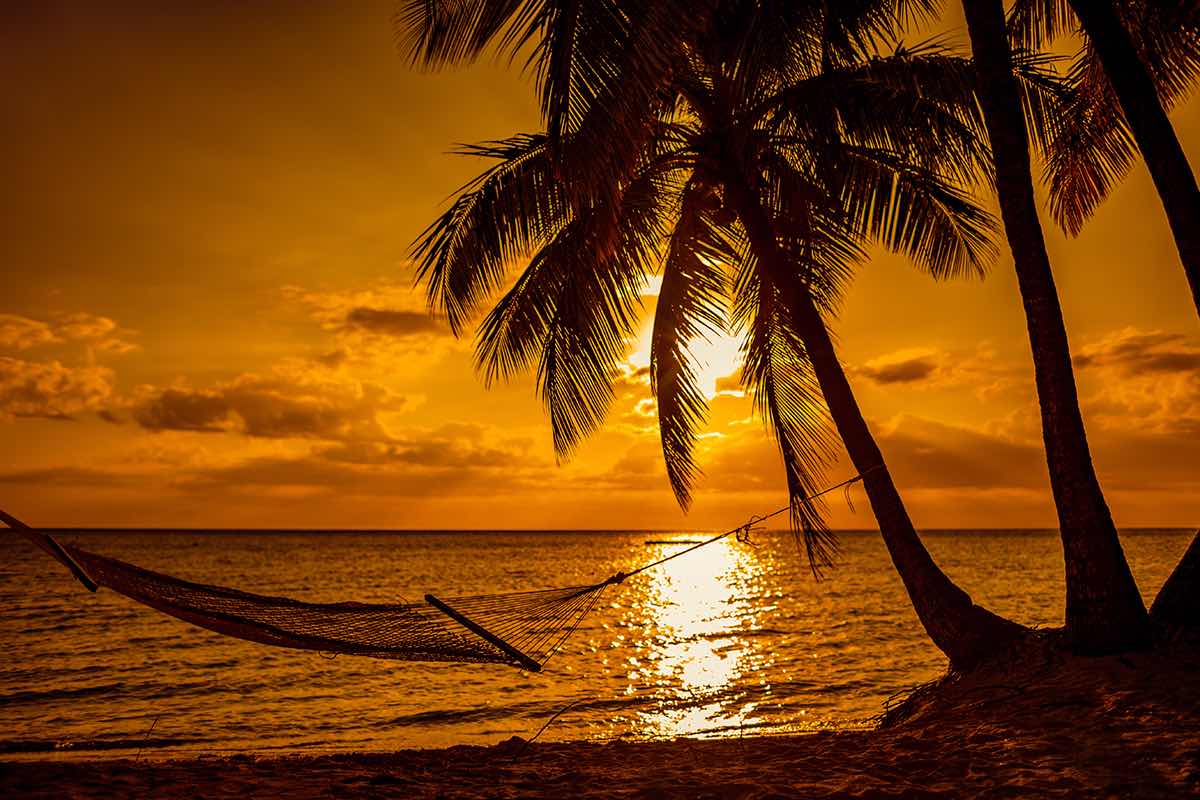
From May on, the weather conditions are constantly improving. The sunshine rate is very satisfactory, temperatures are more pleasant and humidity is no longer a major problem. In addition, you will still benefit from low airfares . Above all, you will benefit from a large availability of hotels in Tahiti . Indeed, the tourist season has just begun and the occupancy rate is not yet prohibitive.
Local Cultural Life Takes Off
The return of the good weather sees many festivities organized in Papeete and Tahiti. The most important event will be the Heiva of the schools (Taupiti ana’e). A little later, the Heiva Rima’i craft fair pays tribute to Polynesian know-how and local producers. This beautiful month of June ends with the Autonomy Day , a popular and festive event with concerts and street entertainment.
July to August: The Best Time to Visit Tahiti
Great conditions for perfection.
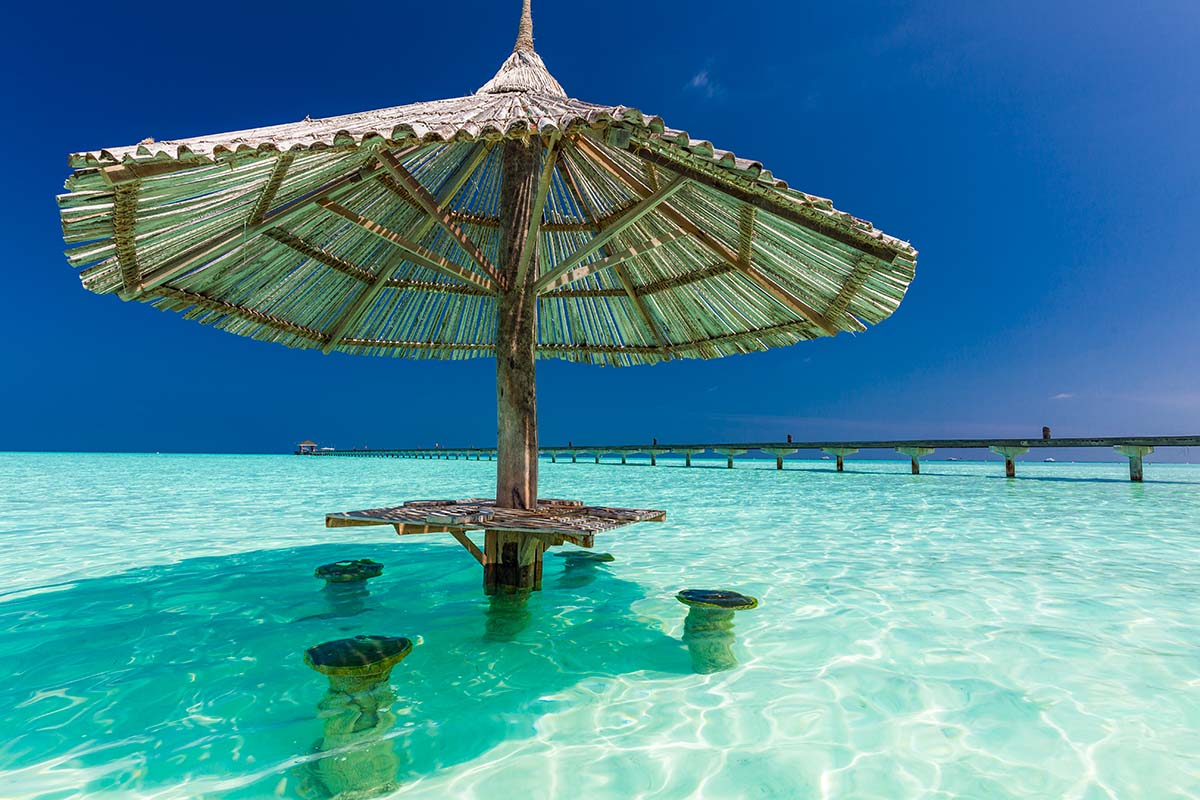
July and August are the best time to go to Tahiti . The sunshine is optimal and the humidity is at its lowest. The dry season is also the ideal time for hiking in Tahiti and visiting the volcanic caves. Indeed, these activities would be cancelled in case of rain the day before. By choosing this period to come to Tahiti, you will put all the chances on your side and enjoy your stay.
The local cultural life reaches its peak. In July, the Heiva i Tahiti dance festival is held. This is an opportunity to discover the Polynesian myth and the Tahitian Vahine . The second cultural event not to be missed is held at the Arahurahu marae . Until the beginning of August, traditional performances take place on a historical site emblematic of Polynesian civilization. Finally, at the end of August, the Tahiti Pro international competition is held on Tahiti Iti, where the world’s greatest surfing champions ride the Wave of Teahupoo .
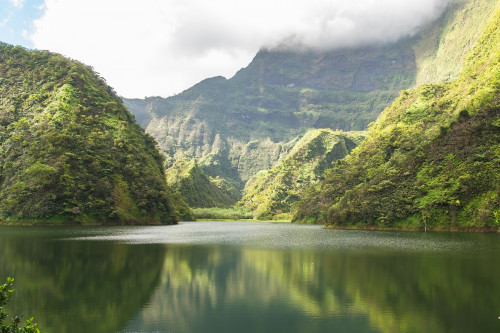
Papenoo Day Tour in 4×4 on Tahiti
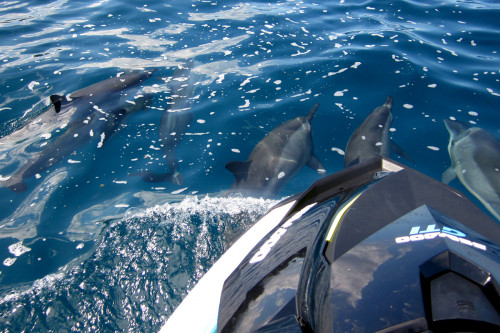
Jet Ski Tour in Tahiti
What are the disadvantages of leaving in july and august.
July and August are a school vacation period for both travelers from Northern Hemisphere countries and residents of French Polynesia. As a result, there are more people, less privacy and less availability for activities and in mid-range hotels. In other words, it is imperative to make reservations well in advance, especially for quality establishments.
Another consequence of the influx of visitors is that airfares are rising sharply. Finding a flight to Tahiti at an affordable price is becoming complicated. This trend is explained by the many expatriates returning to France during this period. International tickets are more expensive and limited in number. This has an impact on domestic flights between the islands of French Polynesia.
September to October: Tahiti Becomes Quiet Again
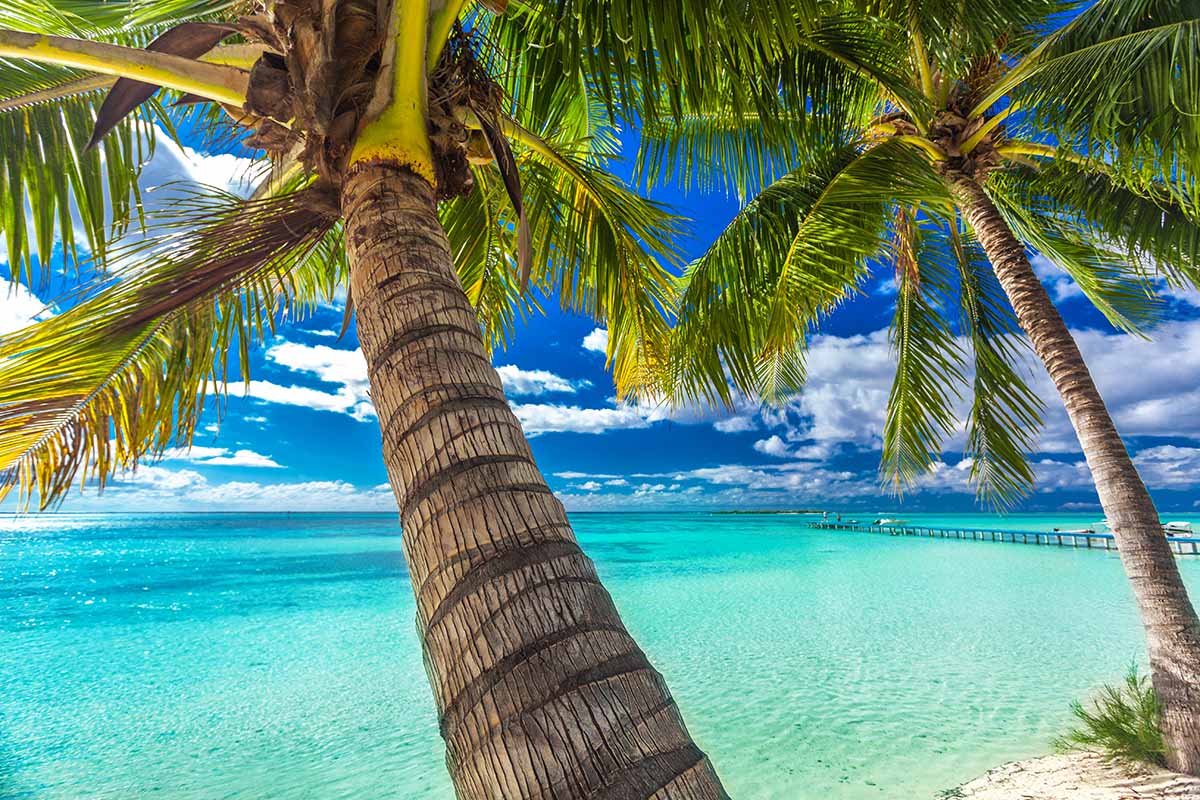
Until mid-October, rainfall remains relatively low and the sun is always shining. You will enjoy the tranquility of Tahiti’s beaches and the serenity of the mountain ranges. Divers will also be able to admire the migration of humpback whales off Tahiti . The phenomenon occurs from July to November and promises unforgettable memories.
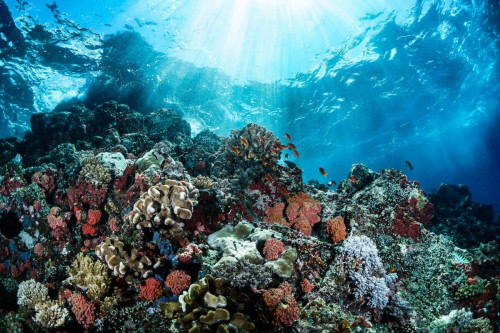
Half-Day Snorkeling Tour in Tahiti
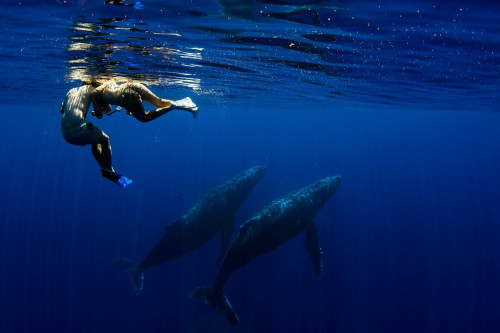
Whale Watching Half-Day Tour in Tahiti
Above all, there are far fewer people. School vacations end in August in French Polynesia and international visitors are scarce from early September. As a result, airfares are going down and the hotel offer is now more accessible. Cultural life is becoming more authentic, less grandiloquent. Music, singing or ukulele festivals gather more locals than tourists. It is a very different atmosphere.
September and October are the golden months . The conditions are there to guarantee a quality stay, quiet and sunny, with more affordable prices. More precisely, we recommend the period from mid-September to mid-October to go to Tahiti.
Choose Your Itinerary in French Polynesia
The dry season from May to October is the best time to go to Tahiti. Plan your itinerary to the South Pacific islands. And why not consider a cruise to Tahiti as well? The trip is just beginning. Contact us to start planning your trip to French Polynesia.
Share This Story, Choose Your Platform!
Related posts.
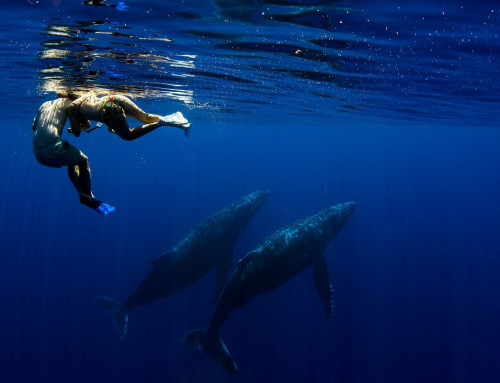
Whale watching in Tahiti: A must-see excursion

Papeete market: Visit the heart of Tahiti
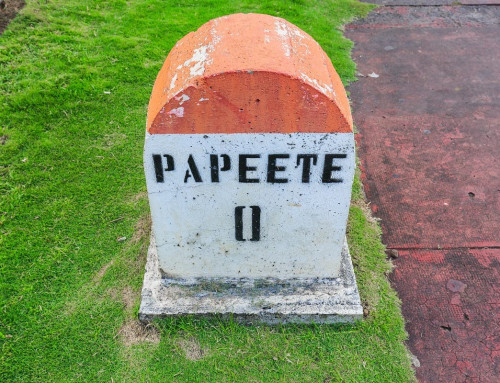
Papeete guide: Explore the capital of French Polynesia
Leave a comment cancel reply.
Save my name, email, and website in this browser for the next time I comment.

What You Need to Know About Tahiti
M Swiet Productions/Getty Images
If a trip to Tahiti and the islands of French Polynesia is on your travel radar, chances are you'll be heading there with someone special .
Nature seems to have custom-made these dreamy South Pacific islands for two. The scenery is spectacular, the water is crystal-clear, and those thatched-roof overwater bungalows rank among the planet's sexiest places to sleep.
And yet families will also find a trip to Tahiti to be a sun-filled (albeit pricey ) playground, as some resorts and islands have begun to cater to parents and children. Here's some facts about what you need to know as you begin planning your visit.
The 118 islands of French Polynesia (an autonomous nation with ties to France) are located in the middle of the South Pacific , about eight hours by air from Los Angeles and midway between Hawaii and Fiji .
Spread over two million square miles, they are divided into several groups. Tahiti, the largest island and home to the capital city, Papeete , is part of the most-visited group, the Society Islands, which also includes Moorea and Bora Bora .
More far-flung are the tiny coral atolls of the Tuamotu Islands, such as Fakarava and Tikehau, and the dramatic Marquesas Islands. Tourists rarely visit two additional groups, the Austral Islands and the Gambier Islands.
Tahiti is a tropical destination with abundant sunshine, year-round air and water temperatures of about 80 degrees, and two main seasons, summer and winter. The ideal time to visit is during the clear, dry winter months of May to October. Yet even during the more humid summer months of November to April, showers are mainly sporadic (typically late-afternoon and overnight) and there's usually plenty of sunshine.
Getting There
Los Angeles International Airport (LAX) is the gateway to French Polynesia. The islands' official carrier, Air Tahiti Nui offers daily non-stops to Papeete's Faa'a Airport (PPT), while Air France, Air New Zealand, and Qantas fly several times a week. You can also fly to Papeete nonstop from Honolulu on a weekly Hawaiian Airlines flight.
TripSavvy / Lauren Breedlove
Suggested Itineraries
With multiple combinations possible among the 15 or so islands with tourism infrastructure, which should you choose? It depends on your experience and interests.
First timers: On their virgin visit to French Polynesia, travelers typically stay for seven to 10 days and stick with a circuit of three islands: Tahiti, where you may have to stay overnight upon arrival or prior to departure, depending on flight times; Moorea, a lush, emerald-hued island located just a short flight or ferry ride away from Papeete; and Bora Bora, the crowning glory of the Society Islands with its magnificent Mt. Otemanu peak and world-famous lagoon.
Specialized interests: Repeat visitors, honeymooners, and scuba divers often bypass Tahiti and Moorea and head to islands a bit further afield.
A great combo for second-time visitors or romantics is Bora Bora, where the views never get old; Taha'a, located a short flight from Bora Bora with excellent pearl and vanilla farms; and Tikehau, Manihi or one of the other secluded Tuamotu atolls, where the main activities are snorkeling, sunning, and relaxation.
Divers typically head for the amazing coral reefs of Rangiroa, which is ranked as one of the world's great dive destinations. Adventure-seekers enjoy exploring the Marquesas, where ancient tribal lore and customs are commonplace.
Is Tahiti Expensive?
Yes, for a number of reasons. Almost everything except fresh seafood and tropical fruit has to be shipped in from a great distance - making food the most obvious expense. Add in the high cost of electricity and a currency tied to the euro, making the exchange pricey for Americans. Bora Bora and Taha'a resorts tend to be priciest, while those on Tahiti, Moorea, and the Tuamotus can be a third to a half less. To save, choose a beach bungalow over an overwater bungalow and look for a package with breakfast included. A variety of sources are now also offering package deals, that include air, accommodations, and sometimes even certain meals, making a visit more affordable than ever.
Do I Need a Visa?
No, for stays of 90 days or less, citizens of the United States and Canada need only a valid passport.
Is English Spoken?
Somewhat. Tahiti's two official languages are Tahitian and French, but you will find that most hotel employees speak English, as do people who work in shops or for tour companies.
Do They Use Dollars?
No. French Polynesia's official currency is the French Pacific Franc, abbreviated as XPF. You can exchange money at your resort and there are a few ATM machines on Tahiti, Moorea, and Bora Bora. Some vendors in local handicrafts markets will accept U.S. dollars.
What Is the Electric Voltage?
You will find both 110 and 220 volts, depending on the hotel or resort. Bring an adapter set and a converter to make sure you're covered.
What Is the Time Zone?
It's the same as Hawaii: Three hours earlier than Pacific Standard Time and six hours earlier than Eastern Standard Time (adjusted to two hours and five hours, respectively, from November to March).
Do I Need Shots?
None are required for residents of North America, but making sure your tetanus vaccination is up to date is a good idea. Also, pack plenty of bug repellent, as Tahiti has its share of mosquitoes and other insects.
Which Islands Are Most Family-Friendly?
The Societies - Tahiti, Moorea and Bora Bora - where a number of resorts have added accommodations suited to families, as well as kids programs.
Can I Cruise the Islands?
Yes. Several ships visit the islands. They include the m/s Paul Gauguin , a 320-passenger luxury ship, offering varied itineraries within French Polynesia and the neighboring Cook Islands year-round; the Royal Princess , a 670-passenger cruise ship, offering 10-day roundtrip sailings from Papeete and 12-day cruises between Hawaii and Papeete; and the Aranui 3 , a combo freighter /passenger ship that makes scheduled two-week runs from Papeete to the Marquesas.
Planning a Honeymoon in Tahiti
The 8 Islands You Need to Know in Tahiti
Tahiti on a Budget
A Guide to the Best Beaches in Tahiti
10 Top Things to Do in Tahiti
The 9 Best Scuba Diving Sites in French Polynesia
10 Best French Polynesian Islands
A Complete Guide to Rangiroa, French Polynesia
The Top 9 Things to Do in Huahine
All About Moorea, "Tahiti's Magical Isle"
Tips for Family Travel to Tahiti
Planning a Trip to Fiji
Bora Bora Guide: Planning Your Trip
10 Best Things to Do on Bora Bora
What You'll See While Snorkeling or Diving in Tahiti
5 Overwater Bungalows You Can Book With Points
Already 1.03 kg of CO2 saved thanks to the eco-mode on this site. Do you want to make an effort for our planet? Learn more
When to visit The Islands of Tahiti ?
Home » Plan Your Trip » When to visit The Islands of Tahiti ?
The Islands of Tahiti has a tropical climate. With about 3,000 hours of sunshine per year, the Tuamotu Islands , is one of the sunniest destinations in the world. The temperature is relatively constant and refreshed by the trade winds which blow all year round. The average annual temperature is 80°F, which is also the temperature of the water in the lagoons. The archipelagos in the south, (the Austral and Gambier Islands) are further from the equator and the temperature is slightly cooler.
The Islands of Tahiti have a very pleasant tropical climate all year round, with constant temperatures and lots of sunshine. There are only two seasons, and both of them are the best time to visit – it all depends on you.
A tropical climate
Every day is summer in The Islands of Tahiti ! There are actually two seasons, dry and rainy. The first is from March to November, with temperatures an agreeable 70° to 80°F. The rainy season is hotter, 77° to 95° C and, as the name suggests, it rains quite a lot. But don’t worry, bright blue sunny skies are always just around the corner. The gentle trade winds ensure that the perceived temperature is nearly always just right.

All the islands in French Polynesia are tropical islands but the archipelagos in the south (the Austral and Gambier Islands) are far from the equator and have milder temperatures than in the Society and Marquesas Islands. The Tuamotu Islands are very sunny, with over 3,000 hours of sunshine each year.
Nature at its most luxuriant
Nature is luxuriant in The Islands of Tahiti , particulary during the rainy season from March to November, known as the season of abundance. It’s the season when fruit is ripe and vegetables are ready for harvesting. During the months of December to February the humidity is high and this period of tropical humidity is the ideal time for any indoor activities.
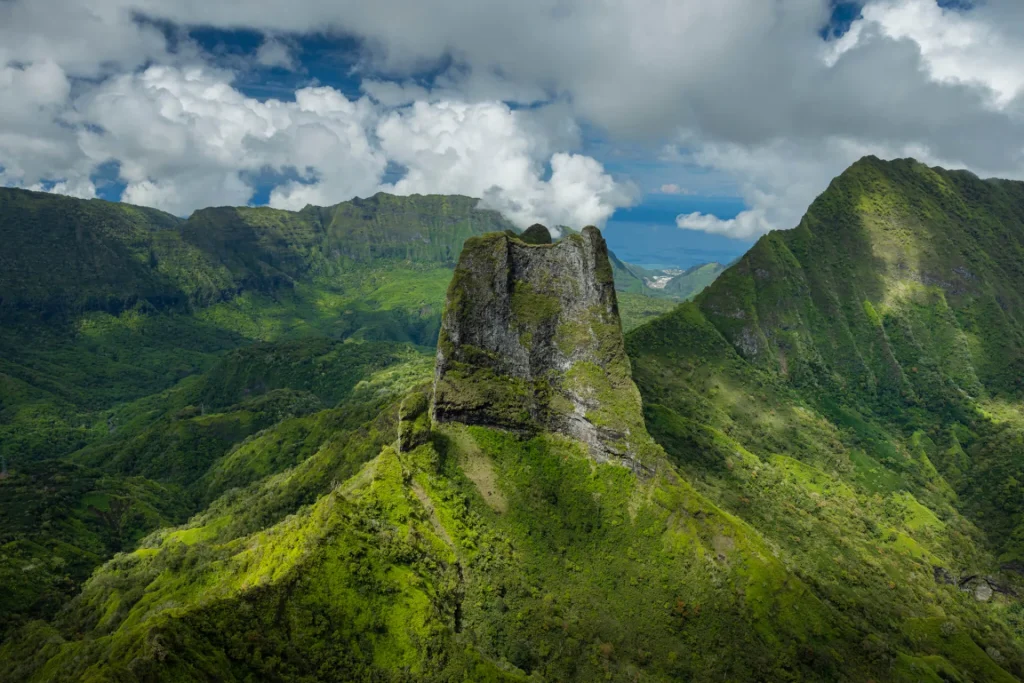
If you look at the table below, you’ll notice that the sun shines in The Island of Tahiti all year round. The average temperature is between 70° and 95°F, with the hottest months being from December to February. The temperatures in the southern archipelagos, the Austral and Gambier Islands, are much milder.
For more precise meteorological information, ivisit the weather.com website.
You'll also enjoy
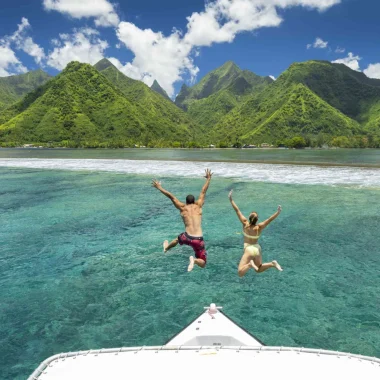
Where are The Islands of Tahiti ?
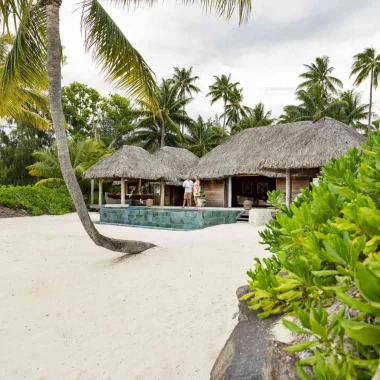
Accommodations in The Islands of Tahiti

Contact a certified travel agent Tahiti specialist
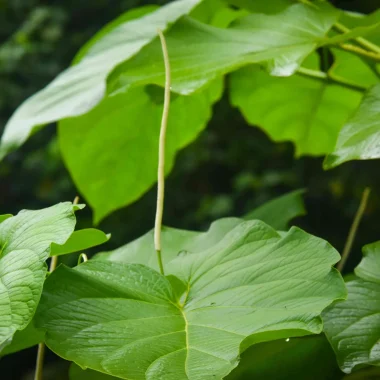
The Islands of Tahiti Brochures
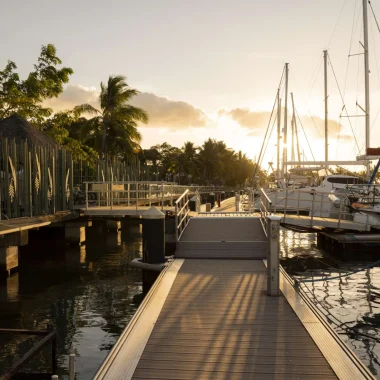
Getting from Island to Island

Getting Around
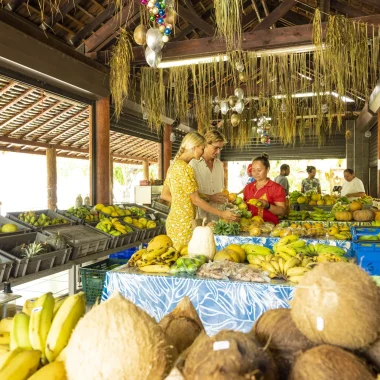
Exchange & Currency
Was this content helpful?
- 3 This content was useful to you
- This content was not useful to you
Thank you for taking the time to let us know that this content was useful to you. Your encouragement is important to us, and your feedback helps us improve.
Thank you for taking the time to let us know that this content was not useful to you. We apologize for the inconvenience.
Share this content
- Share on Facebook
- Partager sur X / Twitter
- Partager sur WhatsApp
- Share by email
Share your experience
#LoveTahiti
- Follow us on Facebook
- Follow us on Instagram
- Follow us on Youtube
- Follow us on Tiktok
- Follow us on Pinterest
If you live in one of these countries, please visit our dedicated websites.
The Best Time to Visit Tahiti, French Polynesia for Weather, Safety, & Tourism
The best times to visit Tahiti for ideal weather are
June 4th to September 2nd
based on average temperature and humidity from NOAA (the National Oceanic and Atmospheric Administration). Read below for more weather and travel details.
Tahiti Travel Guide
Temperature.
- Perceived Temperature
- Rain and snow
- Humidity and wind
- The busiest and least popular months
- Overall travel experience by time of year
Other Tahiti Travel Info
Weather in tahiti.
Average temperatures in Tahiti vary very little. Considering humidity, temperatures feel hot all year with a fair chance of precipitation about half of the year. The area is less temperate than some — in the 14th percentile for pleasant weather — compared to tourist destinations worldwide. Weeks with ideal weather are listed above . If you’re looking for the very warmest time to visit Tahiti, the hottest months are February, March, and then April. See average monthly temperatures below. The warmest time of year is generally late March where highs are regularly around 89.1°F (31.7°C) with temperatures rarely dropping below 76.4°F (24.7°C) at night.
Tahiti Temperatures (Fahrenheit)
Tahiti temperatures (celsius), “feels-like” temperatures.
The way we experience weather isn’t all about temperature. Higher temperatures affect us much more at higher humidity, and colder temperatures feel piercing with high winds. Our perceived temperatures factor in humidity and wind chill to better represent how hot or cold the day feels to a person.
Tahiti Perceived Temperature (F)
Tahiti perceived temperature (c), average tahiti temperatures by month.
Daily highs (averaged for the month) usually give the best indication of the weather. A significantly lower mean and low generally just means it gets colder at night.
Show Fahrenheit
Show celsius, precipitation (rain or snow).
If dry weather is what you’re after, the months with the lowest chance of significant precipitation in Tahiti are July, August, and then June. Note that we define “significant precipitation” as .1 inches or more in this section. The lowest chance of rain or snow occurs around late July. For example, on the week of July 23rd there are no days of precipitation on average. By contrast, it’s most likely to rain or snow in early to mid January with an average of 3 days of significant precipitation the week of January 8th.
Chance of Precipitation
The graph below shows the % chance of rainy and snowy days in Tahiti.
Snow on the Ground
The graph below shows the average snow on the ground in Tahiti (in).
Average Rain and Snow by Month
Show inches, show centimeters, humidity and wind.
Tahiti has some humid months, and above average humidity throughout the year. The least humid month is August (64.6% relative humidity), and the most humid month is January (68%).
Wind in Tahiti is usually calm . The windiest month is January, followed by December and August. January’s average wind speed of around 6.5 knots (7.5 MPH or 12 KPH) is considered “a light breeze.” Maximum sustained winds (the highest speed for the day lasting more than a few moments) are at their highest in mid January where average top sustained speeds reach 16.3 knots, which is considered a moderate breeze.
Relative Humidity (%)
The graph below shows the average % humidity by month in Tahiti.
The graph below shows wind speed (max and average) in knots.
Average Wind Speeds
Show wind speeds.
All wind speeds are in knots. 1 knot = 1.15 MPH or 1.85 KPH.
Show Relative Humidity by Month
Is it safe to travel to tahiti.
Our best data indicates this area is generally safe. As of Dec 04, 2023 there are no travel advisories or warnings for French Polynesia; exercise normal security precautions. Check this page for any recent changes or regions to avoid: Travel Advice and Advisories . This advisory was last updated on Oct 26, 2023.
The Busiest and Least Crowded Months
The busiest month for tourism in Tahiti, French Polynesia is January, followed by February and June. Prices for hotels and flights will be most expensive during these months, though you can save if you purchase well in advance. Tourists are unlikely to visit Tahiti in October. Those willing to visit at these times will likely find it the least expensive month.
Estimated Tourism by Month
Most popular months to visit, overall tahiti travel experience by season, fall (march through may).
Humidity and temperatures combine to make this season feel warm. Highs range from 89.1°F (31.7°C) and 86.8°F (30.4°C) with similar temperatures in the later months. Rain is somewhat common with 5 to 7 days of significant precipitation per month. Fall is fairly slow for tourism, which makes it a good time for those looking for deals.
Winter (June through August)
The middle-year months have very comfortable weather with high temperatures that are comfortable. These months see the least precipitation with 2 to 3 days of precipitation per month. June – August is the second busiest season for tourism in Tahiti, so lodging and other accommodations may cost slightly more.
Spring (September through November)
Spring daily highs range from 87.6°F (30.9°C) and 84.5°F (29.2°C), which will feel very nice given the humidity and wind. It rains or snows a significant amount: 4 to 6 days per month. Tourism is the slowest during these months due to the weather, so hotels may be affordably priced.
Summer (December through February)
Weather is perfect this time of year in Tahiti to be enjoyable for warm weather travelers. The average high during this season is between 88.7°F (31.5°C) and 87.4°F (30.8°C). On average, it rains or snows a great amount: 8 to 13 times per month. These times of year are the busiest with tourists.
Best Times to Travel › French Polynesia › Tahiti, French Polynesia
Similar Destinations
- Faaone, French Polynesia
- Mataiea, French Polynesia
- Afaahiti, French Polynesia
- Bradenton Beach, FL, US
- Vaira’o, French Polynesia
- Papara, French Polynesia
- Papenoo, French Polynesia
- Pueu, French Polynesia
- Pirae, French Polynesia
- Teahupoo, French Polynesia
Popular Destinations
- Paris, France
- Marrakech, Morocco
- Jerusalem, Israel
Tahiti Travel Guide

Courtesy of CampPhoto | Getty Images

Why Go To Tahiti
Miles of shoreline, dozens of resorts , French cuisine to die for – Tahiti has all the makings of a honeymoon destination . But beach bums often pass over Tahiti's sands in favor of Bora Bora 's ivory shores. Despite its idyllic reputation and accessibility, Tahiti is often more of a stopover point en route to romantic getaways on smaller islands. However, that doesn't mean Tahiti should be ignored.
Leafy forests sit beside sandy shores, while French crêpes are served alongside Tahitian poisson cru (raw fish). If there ever was a place that embodies the beautiful duality of the French Polynesian archipelago, it's Tahiti. Here, the quirky, often chaotic atmosphere of the island's capital, Papeete , rubs elbows with uncorrupted natural beauty.
In fact, Tahiti – the largest of French Polynesia's 118 islands – is often referred to as two separate islands despite them being joined by a tiny land bridge. Tahiti Nui is the larger, northwestern section where Papeete can be found. Tahiti Iti (the smaller, southeastern half) is less accessible, although many visitors make the trek here for the seclusion. Just note that spending a week on either part of Tahiti will cost you quite a chunk of change. Regardless, travelers agree that the warm waters, lush jungles and luxurious resorts are worth the splurge.
Find Flight and Hotel Deals
Navigate forward to interact with the calendar and select a date. Press the question mark key to get the keyboard shortcuts for changing dates.
Navigate backward to interact with the calendar and select a date. Press the question mark key to get the keyboard shortcuts for changing dates.
- # 3 in Best Places to Visit in Australia and The Pacific in 2023
- # 4 in Best Beach Honeymoons
- # 8 in Best Islands in the World for 2024
See All 7 Rankings
Best of Tahiti
Best hotels in tahiti.
- in Sofitel Moorea Ia Ora Beach Resort
- in InterContinental Resort Tahiti
- in Manava Suite Resort Tahiti

Best Things to Do in Tahiti
- # 1 in La Plage de Maui
- # 2 in Explore Papeete
- # 3 in Papenoo Beach
Popular Tours

Moorea 6-Hour Snorkeling and Lunch Shared Tour
(1204 reviews)
from $ 124.52

Grand Tour Quad 3h30 Quad excursion in Moorea (single or two-seater)
(306 reviews)
from $ 120.19

Grand Magic Combo Jetski 3h00 + Quad 3h30
(118 reviews)
from $ 225.01
Tahiti Travel Tips
Best months to visit.
The best time to visit Tahiti is between May and October. Although the temperatures are balmy year-round, Tahiti's winter season enjoys less humidity. Tahiti really only experiences two distinct seasons: Winter brings less rain and pleasant temperatures while the summertime – November through April – can be quite hot and humid (especially December), not to mention rainy. But regardless of when you travel, you can expect hotel rates to be high. A simple hotel room runs between $100 to $250 per night, and resorts can start anywhere from $400 per night and go much higher. Vacation rental stays, both private rooms and entire homes, typically cost a minimum of $100 to $200 per night.
Weather in Tahiti
Data sourced from the National Climatic Data Center
What You Need to Know
The languages French is the official language, but you may hear local languages, such as Tahitian. English is also widely spoken.
The food trucks The food truck craze has hit Tahiti. Catch the roulottes – or food trucks – with everything from Chinese fare to French crepes, lined up along Papeete's waterfront in the evenings.
The sharp sand Sandals or water shoes are a must at the beaches. These shorelines are speckled with jagged shells, along with waves that hide barbed coral.
How to Save Money in Tahiti
Head to the supermarket Restaurants are quite expensive, so save cash by purchasing breakfast and lunch items at the supermarket. Then, you can splurge on dinners.
Stay at a guesthouse Tahitian guesthouses, also referred to locally as pensions (pronounced pone-see-on), are typically family-operated accommodations that range from dormitory-style lodging to individual bungalows and villas. They often cost less than a hotel . Tahiti Tourisme offers a comprehensive list on its website .
Go for a cruise Taking a cruise that stops in Tahiti and other islands in French Polynesia can be more affordable than flying in and reserving accommodations on the island. Cruise lines like Princess Cruises and Oceania sail to this island paradise.
Bring your own snacks Food is costly in Tahiti. To save a little money, pack snacks from home instead of purchasing them on the island.
Culture & Customs
French is the official language of French Polynesia, though you'll find that many locals (especially those who work in the tourist industry) speak English. That said, it is more common to use the Tahitian greeting "La ora na," over the French "Bonjour."
Also, bear in mind that for most Tahitians, English is a second language. Be patient and courteous when conversing with locals. You may also hear bits and pieces of Tahitian, the local island language, but most residents will promptly switch to French or English when communicating with you.
The currency is the French Polynesia franc (XPF). The exchange rate fluctuates, so be sure to check it before you go . Tipping is not customary on the islands – gratuities are included in hotel and restaurant bills, but like anywhere else, a little extra for excellent service is always appreciated.
Tahiti is a safe place for tourists. Generally speaking, there are only a couple of dangers to watch out for: pickpockets in Papeete and moray eels in the coral reefs on scuba dives. Most visitors soon discover that Tahiti is warm and welcoming to foreigners. In fact, locals have a philosophy: " aita pea pea " (which translates to: "not to worry"), which results in a very laid-back and affable culture. Don't be surprised when strangers greet you on the street.
What to Eat
Surrounded by the South Pacific Ocean and blessed with ample sunshine and rain, Tahiti is an ideal spot to harvest seafood and grow fresh produce. Fish reigns supreme on menus in the restaurants in this French Polynesian island, with mahi mahi, grouper and tuna undoubtedly the most popular. You'll be remiss if you don't sample Tahiti's national dish, poisson cru , which is raw tuna marinated in coconut milk and lime juice, similar to a ceviche. When it comes to fruit, the island grows some of the tastiest pineapples, coconuts and bananas. Roulottes (food trucks) are also a staple in Tahiti, dishing out a variety of quick (and cheap) eats like pizza, crepes and burgers all packed with flavor.
Many of the island's top resorts house some of the best restaurants in Tahiti – they're also some of the most expensive. However, experts, visitors and locals suggest at least one meal at one of the upscale eateries; favorites include the overwater Le Lotus at InterContinental Tahiti Resort & Spa and French and Polynesian fusion restaurant Le Carré at the Tahiti la Ora Beach Resort. Downtown Papeete is home to some standout restaurants as well, according to recent travelers. They say those looking for a decadent French meal should look no further than Le Grillardin or Restaurant Le Sully.
Getting Around Tahiti
The best way to get around Tahiti is by taxi or rental car. If you're planning on doing a lot of traveling throughout the island, a rental car is a good option. A bike is an option, too. For journeys to other French Polynesian islands, you'll have to book passage on a boat or airplane. Most travelers arrive into Faa'a International Airport (PPT), which is an approximately 4-mile drive west of the capital city of Papeete . If a representative from your hotel isn't picking you up at the airport, you can hop into a taxi to your destination (though the short ride will likely be quite expensive). From the airport, you can also hop on flights to Bora Bora or nearby Moorea .
Entry & Exit Requirements
To visit French Polynesia, you'll need a U.S. passport valid for six months beyond the duration of your trip. If you're planning to stay in the country for more than 90 days, you'll also need to acquire a visa. For more information, visit the U.S. State Department's website .
La Plage de Maui dazzles with pearly white sand.
Explore More of Tahiti

Things To Do
Best hotels.

You might also like

# 1 in Best Beaches in the World for 2024

# 1 in Best Places to Visit in Australia and The Pacific in 2023

# 15 in Best Places to Visit in Australia and The Pacific in 2023
If you make a purchase from our site, we may earn a commission. This does not affect the quality or independence of our editorial content.
Recommended
The 28 Best Water Parks in the U.S. for 2024
Holly Johnson|Timothy J. Forster May 8, 2024

The 18 Best Napa Valley Wineries to Visit in 2024
Lyn Mettler|Sharael Kolberg April 23, 2024

The 25 Best Beaches on the East Coast for 2024
Timothy J. Forster|Sharael Kolberg April 19, 2024

The 50 Best Hotels in the USA 2024
Christina Maggitas February 6, 2024

The 32 Most Famous Landmarks in the World
Gwen Pratesi|Timothy J. Forster February 1, 2024

9 Top All-Inclusive Resorts in Florida for 2024
Gwen Pratesi|Amanda Norcross January 5, 2024

24 Top All-Inclusive Resorts in the U.S. for 2024
Erin Evans January 4, 2024

26 Top Adults-Only All-Inclusive Resorts for 2024
Zach Watson December 28, 2023

Solo Vacations: The 36 Best Places to Travel Alone in 2024
Lyn Mettler|Erin Vasta December 22, 2023

26 Cheap Beach Vacations for Travelers on a Budget
Kyle McCarthy|Sharael Kolberg December 4, 2023

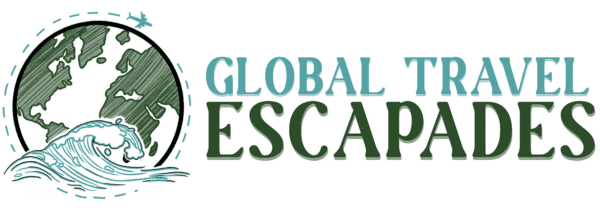
A Helpful Guide for the Best Time to Visit Tahiti in 2024
If you’re ready to plan your dream vacation to beautiful French Polynesia, you may be wondering when is the best time to visit Tahiti . As someone who loves traveling to French Polynesia, I can provide you with specific insight on what to expect depending on the time of year you go!
After all, the island paradise is in the southern hemisphere, so the weather situation may be different from what you’re used to if you’re coming from somewhere in the northern hemisphere! So, here’s what to know along with 12 specific recommendations for visiting!
Best Time to Visit Tahiti (2024)
Alright, I’ll cut to the chase, the absolute best to visit Tahiti is August or September! This is when the temperatures are most pleasant, and the days are still long.
Not to mention, there are the fewest rainy days in these months. So, you’ll be able to enjoy all that Tahiti has to offer without having to worry too much about it raining on your parade!

But, the best reason to visit Tahiti during this time of year is that you’ll be able to capitalize on the once-in-a-lifetime opportunity to swim with whales!
That’s right — from mid-July to mid-November , thousands of humpback whales migrate through the waters around French Polynesia. During this migration period, visitors and locals can swim alongside these majestic creatures and observe them up close!
Thus, if you have a bit of flexibility in your schedule, I highly recommend visiting Tahiti and anywhere in French Polynesia during August or September.
🐋 To learn more about swimming with whales in French Polynesia, you can head to this part of the post !
What If I Can’t Visit During August or September?
However, I know the fairy godmother of schedule-making isn’t always kind, so you may not be free to visit during this time of the year. If that’s you — don’t worry! You’ll still have an unforgettable trip to French Polynesia!
And to help you pick when the next best time to visit Tahiti, let’s take a closer look at the different seasons in French Polynesia!
Best Time to Visit Tahiti by Season
Similar to the tropical island of Guam , French Polynesia experiences two distinct weather seasons throughout the year: a rainy season and a dry season. This is due to the island’s proximity to the equator, which causes the amount of rain to vary more than the actual temperature changes. Below, I’ll explain what you can expect during each season as well as which season is better for visiting Tahiti.

Tahiti Dry Season
Tahiti’s dry season runs from May to October. The dry season is characterized by cooler temperatures with average low temperatures around the mid-60s °F and average highs in the mid to high 70s °F.
And as you likely gathered from the name, you can expect fewer rainy days. Usually, there are only 3 – 5 rain days per month, which not only means more sunny days but also less humidity! 😅
However, I think the biggest perk is that less rain and wind make for improved underwater visibility. Snorkeling is one of the most popular excursions available around Tahiti , and clear days make a whole world of difference in seeing the diverse underwater life up close!
✅ 🐠 Check out this awesome snorkeling tour around Tahiti!
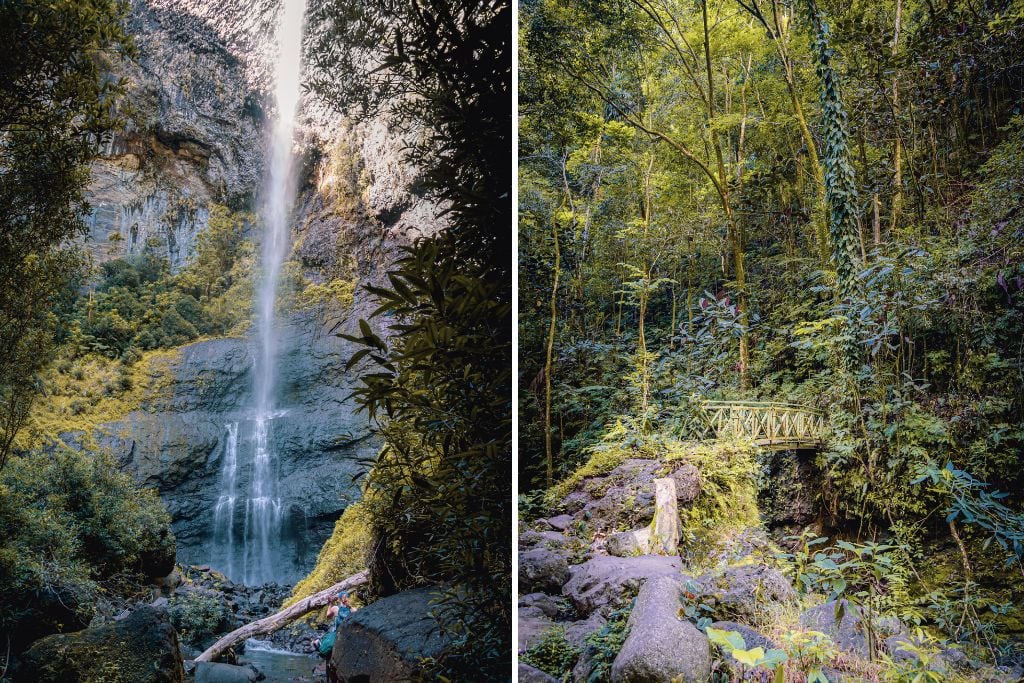
Moreover, if you’re keen on hiking around Tahiti , the dry season is a great time of year to do so. You won’t have to worry about the rivers flooding or trekking through lots of mud. Likewise, the dry season is a good time to visit if you’re looking to surf around Tahiti . The waves are pretty clean, and you can find breaks suitable for every level of experience.
Overall, if you can make it happen, I would highly recommend visiting Tahiti during the dry season. You’ll experience more favorable weather, see clear blue waters, and have better conditions for exploring!
Tahiti Rainy Season
On the other side, there’s Tahiti’s rainy season, or wet season, which lasts from November to April . During this period, Tahiti experiences anywhere from 6 to 10 days of rain each month.
Temperatures are also warmer this time of the year compared to the dry season. As mentioned previously, French Polynesia is located in the southern hemisphere. Therefore, when the United States and Europe are experiencing cold winter weather, Tahiti is in peak summer.
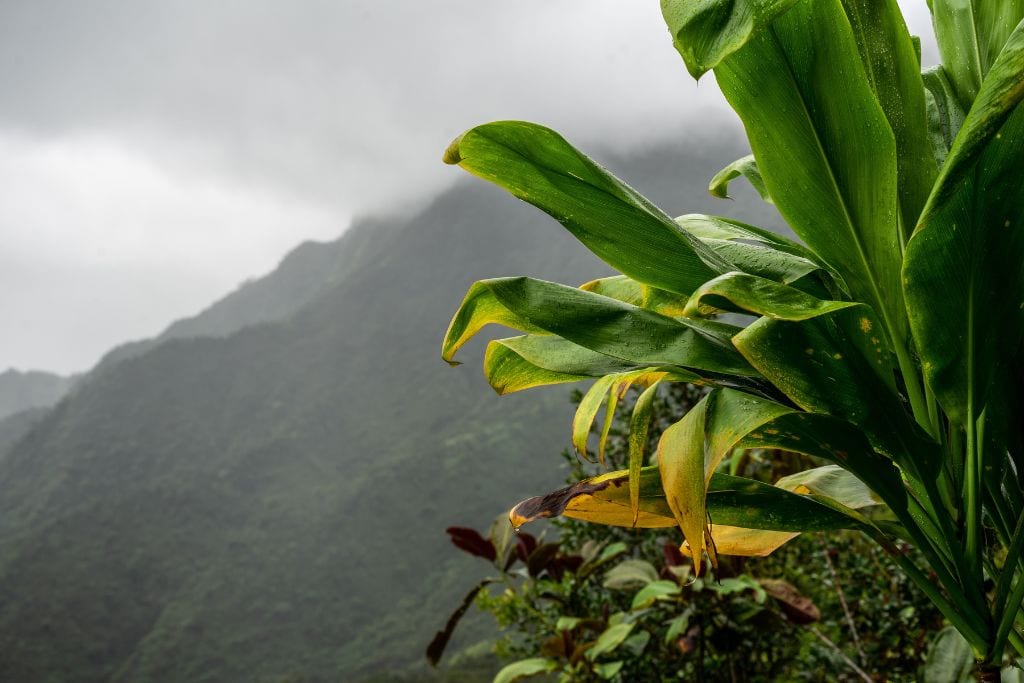
Around the islands, the average high temperatures are consistently in the 80s °F. Normally, temperatures in the 80°s aren’t that bad but add the high amount of humidity and it can be not so fun if you aren’t from San Diego or another place with lots of humidity.
The one thing I will say about visiting during the wet season is that the rainy days aren’t usually that bad. When I visited, the weather app would say there was an 80% chance of rain.
As you would expect, it rained. But, it would only rain for a little bit — as in half an hour to an hour. It would come and go throughout the day and rarely ever downpours the entire day.
So, if you’re visiting during the rainy season, you’ll probably experience a bit of rain in Tahiti. But, it’s not the end of the world! Just remember to bring an umbrella , waterproof jacket, or light raincoat with you!
✅☔️ Check out the compact umbrella I always carry with me when traveling!
Weather in Tahiti by Month
With its proximity to the equator, the temperature in French Polynesia stays relatively stable throughout the year. During the day, the average temperature in Tahiti ranges from 66° – 84°F (19 – 29°C), so it’s pretty warm without being too hot.
But, we know averages are just that — averages. For a better understanding of what to expect for your specific trip, here’s a breakdown of the weather in Tahiti by month.
Tahiti Weather January
January is the middle of the rainy season in Tahiti, so expect a lot of precipitation. With the excess rain, you can expect lots of cloudy days.
Temperatures are also pretty warm/hot since it’s also considered their summer season. Oftentimes, it’ll feel even warmer due to the humidity in the air.
And of course, with the hot ambient air temperatures comes warmer waters. Swimming in the ocean feels like you’re swimming through a hot tub at times.
- Average Temperature (high/low): 83°F / 70°F or 28°C / 21°C
- Average # of Rainy Days: at least 10 rainy days
- Recommendations: Bring lots of reef-safe sunscreen , sunglasses, a big hat, and a rain jacket!
🌊 PRO TIP: Oh! And you may want to consider bringing a rash guard if you plan on spending lots of time in the water. Even though the waters are very warm, it’s so easy to get sunburnt. Wearing a rash guard will not only provide some protection against harmful UV rays but also prevent unwanted sunburns!

Tahiti Weather February
February isn’t much better as it’s still peak rain season. You can expect rain practically every other day , if not more, but hey it adds to the adventure right!?
Temperatures are pretty much the same situation as in January. And again, with the warm ambient air, you can expect very humid days too.
So, if you don’t do well in these conditions, I wouldn’t recommend traveling to Tahiti during February. But, if it’s the only time you’re able to make your way to the islands, I’d say it’s still very much worth it!
- Average # of Rainy Days: 9 rainy days
- Recommendations: Make sure to book a hotel with air conditioning as opposed to an Airbnb or place on VRBO that doesn’t offer AC.
Tahiti Weather March
Of all the months, March is the hottest month of the year in Tahiti. And, unfortunately, temperatures often rise past the average high temperature.
That said, I wouldn’t say this is necessarily a bad thing or automatically deem March as the worst time to visit.
The reason is that March is when the number of rainy days starts to decrease. As such, you can expect a few more clear, sunny days and less humidity.
So if you’re a fan of hotter days or perhaps your spring break occurs in March, Tahiti is still worth visiting — at least I think so 🙂
- Average Temperature (high/low): 84°F / 71°F or 29°C / 22°C
- Average # of Rainy Days: 7 rainy days
- Recommendations: Bring adequate water with you everywhere you go. My friends and I usually stocked up on giant water bottles from Carrefour every two days.
Tahiti Weather April
April is the final month of the rainy season, so you can expect almost half as many rain days as January. But, I would still anticipate a rainy day or two during your stay.
Temperatures are slightly cooler than in March and resemble that of January and February. You can also count on lower humidity levels, which is a bonus.
But the best part about visiting in April is that it marks the start of the surf season in Tahiti. So, any fellow surfers, beginner or experienced, looking to catch some good waves will be in luck! That said, remember to always check local surf forecasts before heading out as conditions can change quickly.
- Average # of Rainy Days: 6 rainy days
- Recommendations: Even if you don’t surf, I highly recommend taking a taxi boat out to see the powerful Teahupo’o wave ! It’s one of the most famous surf breaks in the world and you often will see professional surfers out here!
✅ 🏄♀️ Check rates & availability for a boat tour of Teahupo’o
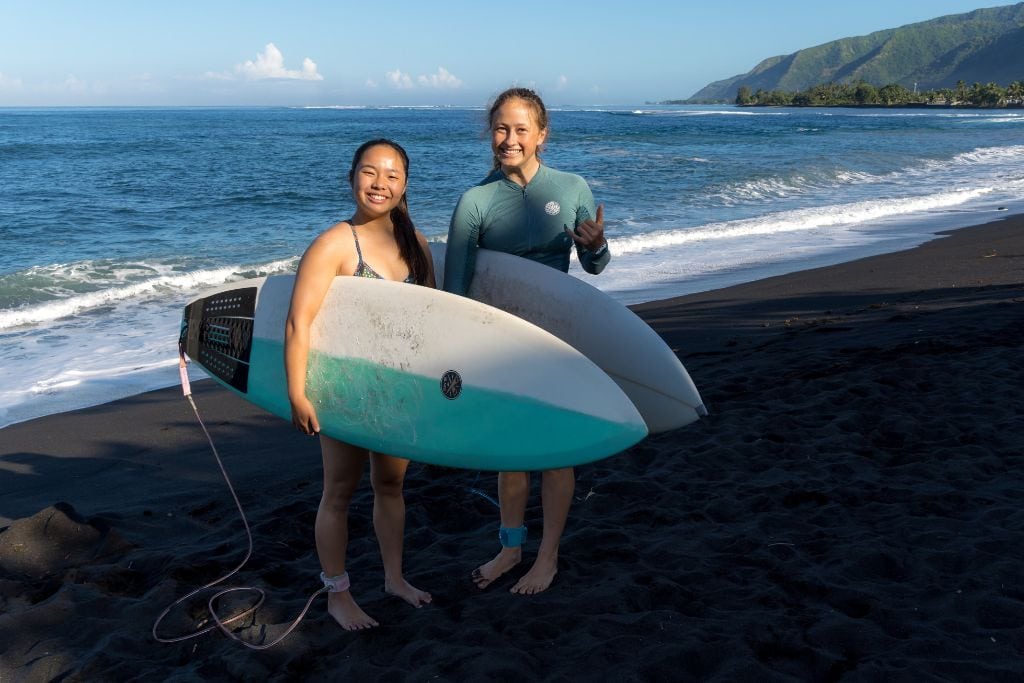
Tahiti Weather May
May is the start of the dry season in Tahiti so you can expect considerably less rain compared to the peak rainy season.
Temperatures also begin to dip a little… as in temperatures dip by a couple of degrees. But hey, anything helps in making it more comfortable!
These factors make May time of the year a good time to visit Tahiti if you want to avoid summer crowds from those living in the northern hemisphere.
- Average Temperature (high/low): 82°F / 69°F or 28°C / 21°C
- Average # of Rainy Days: 5 rainy days
- Recommendations: Begin looking for flights well in advance! My friends and I booked with StudentUniverse (see why I love this company ), which had amazing deals! I highly recommend checking this platform out, and you don’t need to be a student to create an account!
✅ ✈️ Sign up for StudentUniverse here to receive $20 off your first booking
Tahiti Weather June
During June, temperatures continue to drop, and humidity levels become much more bearable with the decrease in the rain.
Simultaneously, this is the start of the peak travel season for Tahiti and her islands as kids get out of school and families head out for vacation. But, it’s not just the good weather that gets people excited, it’s the surf conditions too!
June is the start of the winter season for Tahiti. This means surfers can expect excellent surf conditions on the island as a result of the strong winter swells from the Southern Ocean.
So, with all this considered, June is a great month to visit Tahiti. In fact, June is the month that my friends and I visited, and we loved it! The crowds weren’t too bad, and it was quite enjoyable.
- Average Temperature (high/low): 80°F / 67°F or 27°C / 19°C
- Average # of Rainy Days: 4 rainy days
- Recommendations: Book any fun excursions around the island, like this thrilling 4X4 tour , you want to do in advance. Also, know that your trip might be expensive since increased demand typically results in increased prices!
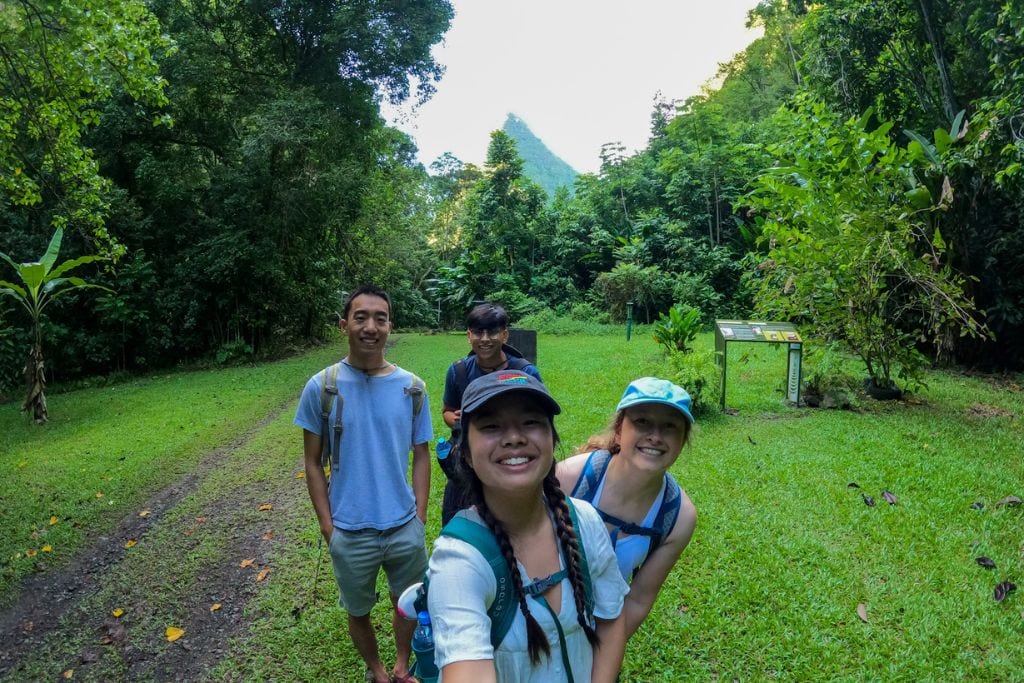
Tahiti Weather July
If the heat is not your friend and you’re more sensitive to hot and humid weather, July is a fantastic month to visit Tahiti. Temperatures continue to drop a tiny bit, which may not seem like much. But after visiting, I can confirm that any relief from the heat and humidity is always welcomed.
And again, with July being part of the driest period of the year, Tahiti has only a couple of rainy days. So you’ll be able to spend most, if not all, of your days exploring without fretting over whether it’ll rain or not.
- Average Temperature (high/low): 79°F / 66°F or 26°C / 19°C
- Average # of Rainy Days: 3 rainy days
- Recommendations: If you want to stay in a dreamy overwater bungalow on Tahiti, you can do so at the InterContinental Resort Tahiti . Just be sure to book as far out as you can because they are highly sought after and usually sell out.
Tahiti Weather August
August is considered the *coldest* month in Tahiti. If you’re like me, the words August and cold may seem odd together, but remember it’s Tahiti’s winter season!
Add lower humidity levels and long sunny days to the mix, and you’ve got the perfect recipe for a lovely vacation.
For this reason, August is a fabulous time to go snorkeling through the clear waters , soak up the sun on the stunning beaches, or chase after a waterfall or two!
And since I gotta look out for my fellow surfers, this is the time of year when you can see some monster waves! The iconic surf break, Teahupo’o, is known for generating perfect barrels this time of year.
During the 2022 season, Teahupoo had some of the biggest waves in a decade! These are called XXL days (see Youtube video) and the island will issue a code red. So if you’re a very experienced surfer looking to challenge yourself with huge swells, this is a great time to go!
- Average Temperature (high/low): 79°F / 65°F or 26°C / 18°C
- Recommendations: Even non-surfers can marvel at this force of nature by taking a taxi boat to the break ! When my friends and I were out there, we were joined by a little 3-year-old and her parents. The experience can only be described as otherworldly.
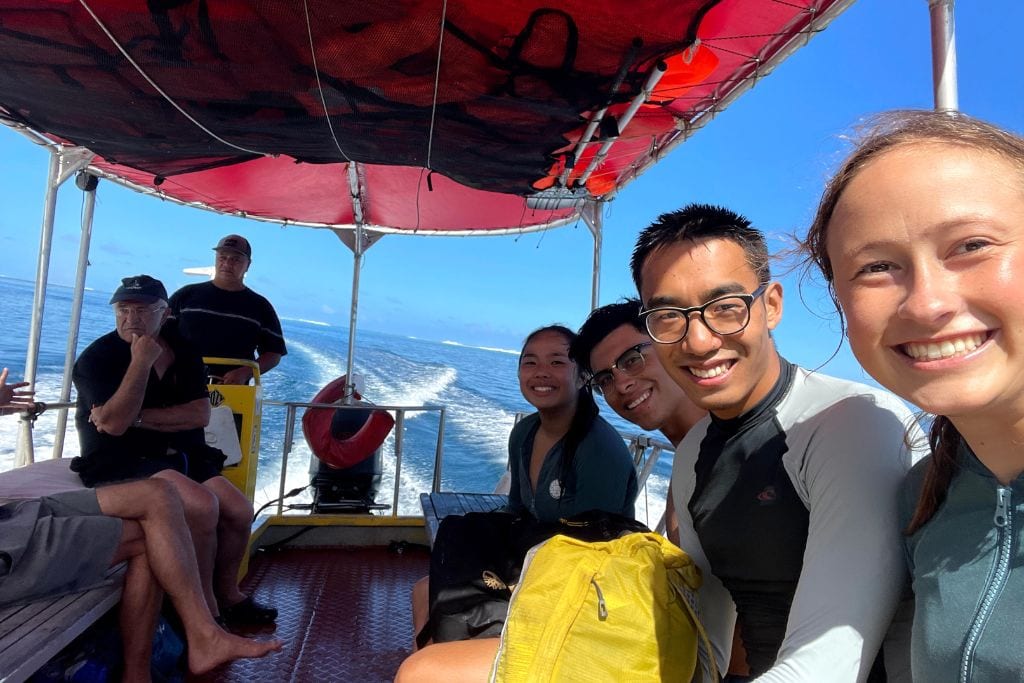
Tahiti Weather September
For those who have more flexible schedules, September is easily one of the best times to visit Tahiti.
It’s one of the driest months, and similar to August, there’s an abundance of sunny days, cool weather, and low humidity!
The difference between the two months is that most kids will be back in school. Thus, if you visit in September, you can enjoy the island without throngs of tourists.
Plus, prices for housing, excursions, and even flights tend to fall with a decrease in demand, which is Kristin-approved! 😅
But, the biggest perk of visiting during September is having the opportunity to swim alongside humpback whales ! Whale season technically lasts from mid-July to mid-November . However, I believe you have the best chances of seeing and swimming with them if you go during the middle of the season as opposed to the beginning or end of whale season.
- Recommendations: If you plan on swimming with these majestic giants , make your reservation as soon as you can! Spots are very limited, and it’s a once-in-a-lifetime experience you don’t want to miss out on!
✅ Check rates and availability for this highly-rated whale tour in Tahiti 🐋 Check rates and availability for this popular & affordable whale excursion in Moorea
Tahiti Weather October
October is the last month of the dry season in Tahiti, so you’ll start to see a little more rain. But, temperatures are still pretty pleasant with conditions similar to that of July, August, and September.
Not to mention, with 12 hours of daylight, you can bask in the long days filled with plenty of sunshine and outdoor adventures!
- Recommendations: If you have time in your schedule, I encourage you to explore Tahiti’s nearby sister island, Moorea! It’s super easy to visit on a day trip !
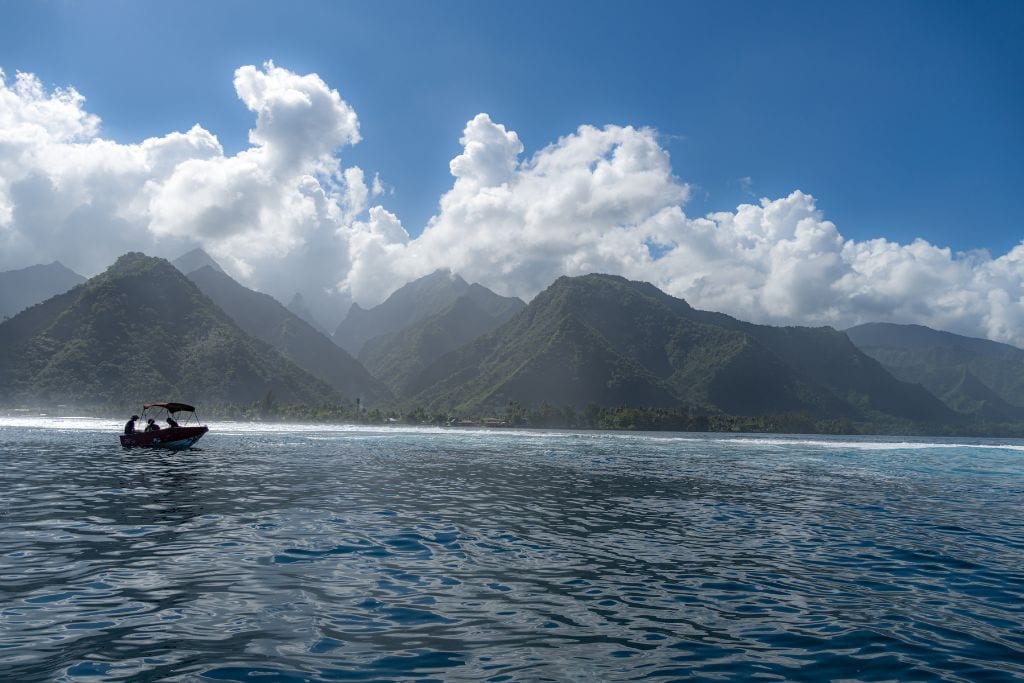
Tahiti Weather November
November is the start of the long summer season, so daytime temperatures usually climb to the high 80s. And unfortunately, you’re unlikely to find much reprieve at night.
In addition to this, November marks the beginning of the wet season. Thus, you can expect to see a significant increase in both rainfall and humidity.
So, if you’re looking for a dry and sunny vacation, November might not be the best month to visit Tahiti.
However, if you can get past the heat and rain, there are still plenty of activities to do on the island! For example, my friends and I thoroughly enjoyed wandering through the Museum of Tahiti and The Islands and exploring the Papeete Market.
- Average Temperature (high/low): 81°F / 69°F or 27°C / 21°C
- Recommendations: If you have limited time, check out this excellent and affordable tour of the island ! The guides are awesome and eliminate the stress of navigating the roads!
Tahiti Weather December
Just like January, December is one of the wettest months of the year, with the island often receiving more than 12 inches of rain.
In addition, you can expect temperatures to continue to rise from November since it becomes the peak summer season in French Polynesia. For these reasons, you may want to think twice about visiting during this time of the year if you can’t stand the heat and rain.
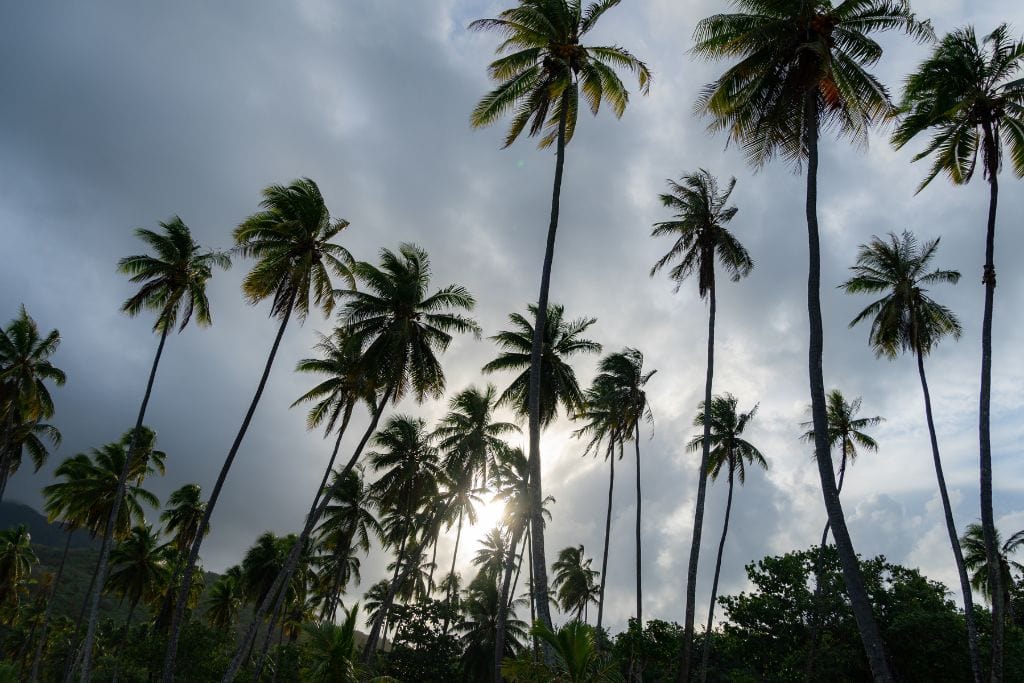
All this said, if you’re okay with lots of rain and looking to trade a white winter wonderland for sandy beaches, Tahiti is likely worth visiting. One of the silver linings is celebrating Christmas and New Year in Tahiti!
You can usually find some holiday celebrations happening around Tahiti. For instance, the markets will put up Christmas decorations and fireworks go off on New Year’s Eve. Plus, you’ll find parties happening around bars and restaurants – so it can be fun!
- Average Temperature (high/low): 82°F / 70°F or 28°C / 21°C
- Average # of Rainy Days: 10 rainy days
- Recommendations: Similar to January, make sure to bring a good umbrella and rain jacket with you everywhere you go!
What Is the Best Month to Visit Tahiti?
Considering everything mentioned above, I think the best month to visit Tahiti is September. Not only is this when the weather is at its best, but it’s the middle of whale season!
From mid-July to mid-November, humpback whales migrate from Antarctic waters to calve or give birth to their young. And while you should try to see them no matter what if you’re visiting during whale season… there are typically lower chances if you go at the beginning or end of the season (July or November). Thus, I recommend swimming with them in August, September, or October if you can!
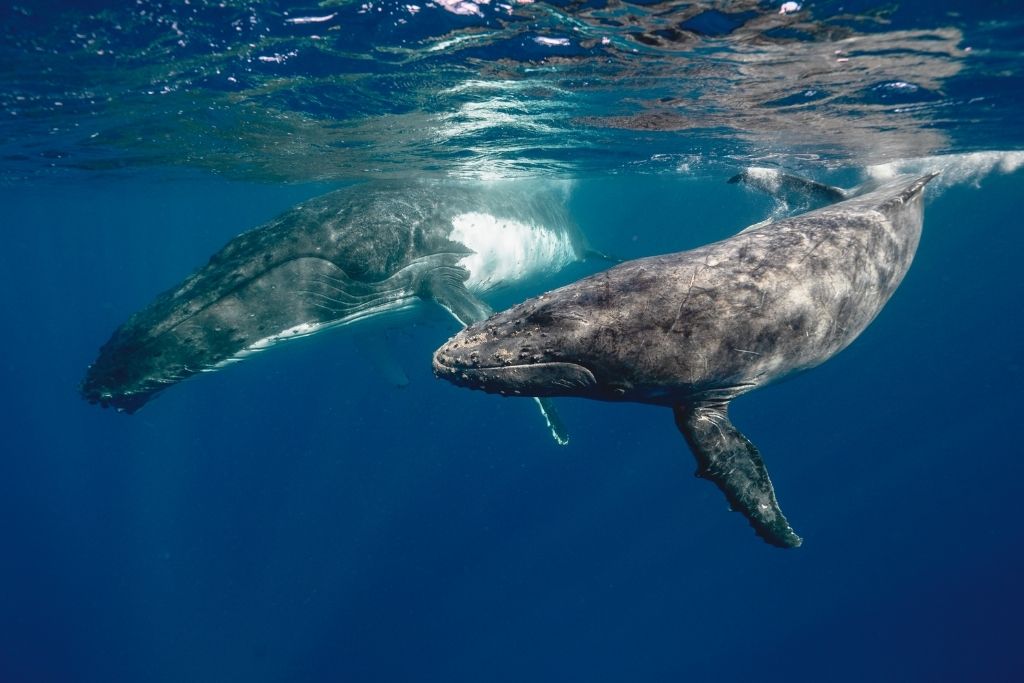
Swimming with Whales in French Polynesia
Furthermore, a fun fact is that French Polynesia is also one of the only places in the world where you can swim with whales respectfully in their natural habitat. The tour companies that head the whale watching and swimming excursions always make sure that the whales are not disturbed, and everything is done in as safe of a manner as possible. And while there’s technically no guarantee you’ll see whales, with them being wild creatures, these tour companies truly do offer you the best chance of spotting them. So, if you’re looking for the experience of a lifetime that will probably end up being the highlight of your trip, here are the two tours I highly recommend!
Cheapest Time to Visit Tahiti
If you’re traveling to French Polynesia on a budget , the cheapest time to visit Tahiti is during the wet season (November – April). This is because the weather is less favorable with the excess rain, so there are usually fewer tourists.
As you would expect, less tourist demand leads to lower costs on flights, hotels, and other accommodations.
However, if you want to know a specific month, I would argue that November is probably the cheapest month. Most people tend to go home to celebrate Thanksgiving, and the breaks aren’t usually long enough for a getaway to French Polynesia. Thus, I would expect the least amount of tourists to travel to French Polynesia in November.
That said, I believe that you can find some great deals during December and January as well. This is the peak rainy season in Tahiti. So, even though some people may visit to celebrate the holidays or retreat from the cold, hotels and tours still run sales to attract more visitors.
Worst Time to Visit Tahiti
Honestly, if you ask me, I don’t think there’s a ✨ worst ✨ time to visit Tahiti… A trip to a remote island, where you can unplug from the external pressures of life and just live in the moment sounds pretty dang good — ✨ anytime ✨.
But, if I had to pick, I would say that the worst time to visit Tahiti is March.
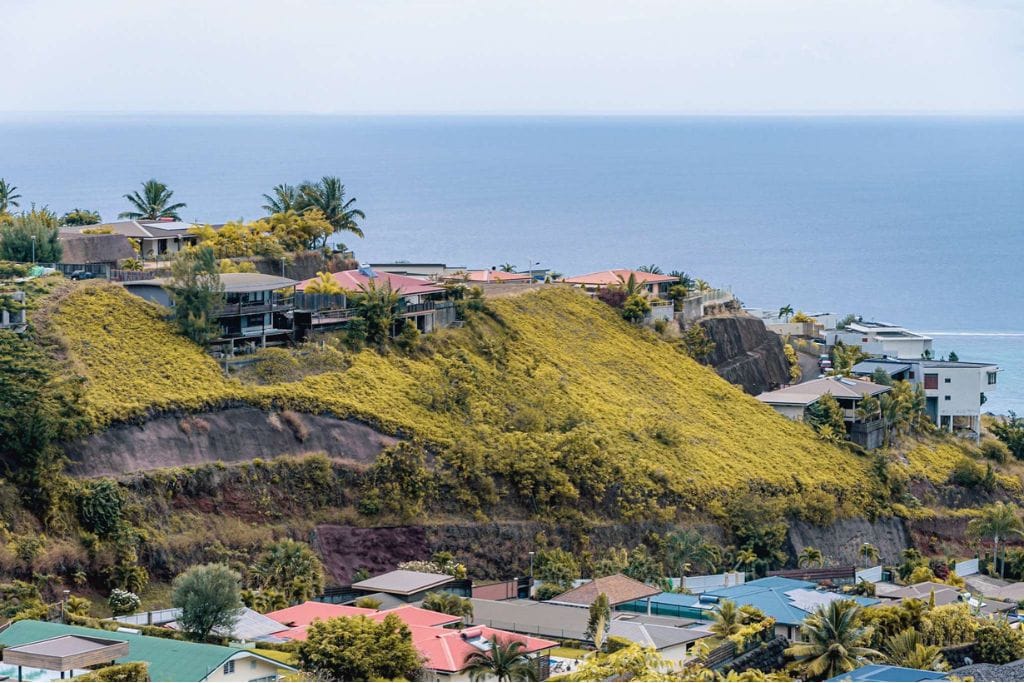
Although March isn’t the wettest time of the year, it’s the hottest time of the year. And, there’s still a fair bit of tropical showers, which equates to humidity.
As someone who once lived in San Diego and is used to 110°F summers, this isn’t a huge problem for me. But, I know these conditions can be a major deal-breaker for others. So, I’d say March is probably the least enticing.
Where to Stay in Tahiti
If you need recommendations on where to stay, here are a few places worth checking out!
Low-Cost Stays
- Fare D’hôtes Tutehau — A local homestay | ⭐️ 9.2 / 10
- Manaeva Lodge — Another stay with a local family | ⭐️ 9.5 / 10
Mid-Range Stays
- Te Moana Tahiti Resort — A beautiful waterfront resort | ⭐️ 8.2 / 10
- Vanira Lodge — The best housing located near Teahupo’o | ⭐️ 9.2 / 10
Fancy Stays
- This is where you’ll find the overwater bungalows
- Hilton Hotel Tahiti — The ultimate package in terms of amenities & service | ⭐️ 9.0 / 10
Best Time to Visit Tahiti: FAQ
The high season in Tahiti is June – August as this is summer break for anyone in the Northern Hemisphere.
There is an off-season in Tahiti. It’s pretty much anything outside of the months of June-August. But, if you want to avoid the heavy rainfall AND crowds, you should visit either in April – May or September – October!
The period where there’s the greatest risk of hurricanes forming in Tahiti is December – April. But, I wouldn’t be too worried as hurricanes rarely occur in French Polynesia. The last major hurricane or cyclone, as they call them in the southern hemisphere, occurred in 2010 . When they happen, the islands issue a red alert, all roads are closed, and everyone is instructed to find shelter.
If you are solely visiting Tahiti, I would recommend a good 5 days! This will give you lots of time to explore the island, embark on fun excursions, and even time to take the ferry to Moorea. However, if you want to do some immersive excursions in Moorea , Bora Bora, and/or other places, then I’d try to aim for at least 3 days on each island.
Tahiti is in the same time zone as Hawaii, which is GMT-10. So if you’re normally PST like me, Tahiti is 3 hours behind us.
The best way to get to Tahiti is to fly directly into the Fa’a’ā International Airport in Tahiti’s capital, Papeete! There are direct flights from LAX and SFO. From there, you can easily fly to the smaller French Polynesia islands if needed.
Wrap-Up: Best Time to Visit Tahiti (2024)
French Polynesia is a tropical paradise located in the central South Pacific Ocean. This string of islands near the equator is known for its year-round tropical climate that consists of warm temperatures, lots of sunshine, and plenty of rain! Depending on when you visit, rain in Tahiti will vary significantly. But, the overall best time to visit Tahiti is September. Not only will you be able to avoid the busy tourist season and have the least amount of rain to deal with but also you’ll have the amazing opportunity to swim alongside whales ! And, observing these ethereal creatures up close is one of the most magical experiences you can embark on! So, if you ask me, the best time to visit Tahiti and immerse yourself in the local culture of French Polynesia is September!

📸 Appreciation Note: You’ll notice that a few of the pictures in this post were taken by my friend good friend Sol! You can see more of his amazing photography here !
Tahiti Packing List
Get your free checklist for what to bring to tahiti 🌴.
Need some help packing for your vacation in Tahiti? Here’s my handy checklist for what to bring to Tahiti ! You’ll also receive weekly updates on what’s happening in the travel world!
I won’t send you spam. Unsubscribe at any time.

Save This Post for Later!
Kristin is the founder of Global Travel Escapades, a blog dedicated to helping travelers explore beautiful destinations and planning their wildest travel dreams. She has explored 30 countries and is on a mission to visit 50 by age 30. Along the way, she has lived in places like sunny San Diego and the vibrant French capital! Ultimately, Kristin hopes her passion for adventure, delicious food, and all things F1 & tennis inspires others to plan their next travel escapade!
Going Awesome Places
Detailed itineraries + travel guides
Best Time To Go To Tahiti
Last Updated October 27, 2022 William Tang
You are here: Home » Travel Guides » Best Time To Go To Tahiti
Tahiti and French Polynesia comprise a literal paradise on earth. Here you’ll find a rainbow of beaches – black, white, pink – edged by turquoise seas and backed by mountainous verdant interiors. That’s not to mention the diving, the culture, the hiking, or even the surfing. It’s enough to inspire anyone to take a trip without even thinking about it.
But before you do take a trip, it’s a good idea to figure out when exactly is the best time of year to visit French Polynesia for you. There’s weather to consider, as well as festivals, wildlife spotting opportunities and surf conditions. So with all that in mind, this article is here to break it all down into bitesize chunks to help you figure it all out.
Read more about French Polynesia
- French Polynesia Rangiroa Pensions – Where To Stay Guide
- Tahiti vs Bora Bora – What Are The Differences and Which Is Better
- The Islands of Tahiti Travel Guide – What You Need To Know for French Polynesia
Where to stay in Tahiti?
- For the best prices on accommodations and the most choices, Booking.com has been my go-to choice especially once you reach Genius tier and you can find an additional 10-15% off places to stay.
In This Article
Tahiti tourist travel seasons
Tahiti weather throughout the year, holidays and festivals in tahiti, frequently asked questions, best time to visit tahiti by season.

While you could simply opt to visit Tahiti going by the default “best time to visit” (i.e. the tourist high season), that might not be the best for everyone.
You may be in this part of the world to catch a glimpse of a humpback whale, or you may be here to catch a wave. Either way, you’ll want to figure out when it’s best to visit for you . So without further ado, let’s see when that might be…
The Rainy Season
The rainy season in Tahiti runs from November/December through to April , with December and January being the wettest months. The wet season may seem like it’s not the best time to visit French Polynesia, and therefore Tahiti, but it can be a great time of year for various reasons. Whale watching and getting to swim with hammerhead sharks, for example, can be ideal this time of year.
For one thing, the rainfall usually only arrives in short, sharp downpours, lasting for around a half hour. The weather patterns are fairly predictable, with rain showers occurring mainly towards the end of the day (sometimes the early morning). Storms never usually stick around for too long.
It’s usually sunny, even during the wet season. You’ll be able to watch large clouds rolling in from across the sea. It will then rain for a short period, and then the clouds will move on. It’s only sometimes that the overcast skies stay for longer and the sun doesn’t shine.
The dry season runs from April to November . This is what most people consider the best time to go to Tahiti. The temperature is usually milder than the wet season, and the humidity is less intense on the whole. This is when many countries’ summer vacation time falls, and therefore the natural time of year to make their way to French Polynesia.
In fact, June, July and August are winter in this part of the world (it is the southern hemisphere, after all). There’s less rainfall, and therefore better visibility for water sports such as diving and snorkeling .
Heading to Bora Bora?
Bora Bora doesn’t have to be expensive. Learn how you can save money on your dream vacation.

High Season
High season for traveling to Tahiti runs from May to October. The peak months, as we said before, are June, July and August. Across those three months French Polynesia sees its highest numbers of visitors.
What makes it the best time to visit French Polynesia, for many, is the ideal beach conditions. There are plenty of places to kick back on the sand across the archipelago, and you’ll want sunny days for that.
It’s also the time of year where there are a ton of fun cultural events to enjoy.
The downside of this perfect combination is that it’s also the busiest time to visit. Hotel prices are at their highest, as are flight costs. You may want to book in advance for any tours or excursions you plan on taking. For those who like their beaches deserted, this may not be the best time to go to Tahiti.
Shoulder Season
Either side of the high season, there’s the shoulder season. This portion of the year ( April and November ) is a mix of both wet and dry seasons as they merge into one other. Because it’s either at the start or the end of the high season, you may be able to get better value for money on your accommodation. Resorts tend to be less busy, and tourist sights see fewer crowds.
You may not think that visiting during the sticky summer months (that’s December to March ) is a good idea: the humidity is high, and it rains a lot. But as mentioned earlier, you can still get a good portion of the day with sunny weather before the rain starts.
Because of this, Tahiti is actually considered a year round destination, even if many people choose not to visit in low season. It’s perfect for some winter sunshine, so if you want the beach for yourself – and the possibility of cheaper room rates – this could be the best time to visit French Polynesia for you.
Diving and spotting marine wildlife this time of year is particularly good, even if it doesn’t have the same across the board visibility that the dry season has. Dolphin spotting and diving is done without any other tourists there, so you can have an almost personalized experience.
One spot we highly recommend for dolphin spotting is this shark, whale, dolphin, and stingray experience in Moorea .

Tahiti’s weather , and that of French Polynesia, is split into two halves of the year: wet and dry. However, it’s not quite as simple as that, and things do vary slightly on a month to month basis. Here is a breakdown of what to expect for each month.
Temperatures are high in January, peaking at around 85°F, with lows of 73°F. Being in the rainy season, and the wettest month, most days receive rain, with afternoon showers being a pretty common occurrence. Not exactly what we’d call the best time to go to Tahiti. The heat doesn’t really abate, day or night, so you’ll really be thankful for that AC.
February is another wet and humid month in French Polynesia. Temperatures are similar to that of January, with highs sitting around 86°F and lows being around 73°F. If you choose to visit this time of year, you can expect rain to affect your vacation on most days. However, the rain doesn’t usually last too long, and is concentrated mainly in the mid-afternoon.
The temperature peaks at 90°F and it’s super humid. However, the rain is starting to ease off – a little . That means you’ll have more time to explore the outdoors. Not only that, but the sea temperatures are great. It’s nice and warm, and feels like you’re swimming in a bath.
The weather in Tahiti in April has similar temperatures to March, and marks the end of the rainy season. As the month progresses, rainy days get steadily less common. In fact, there are half as many as December and January. It’s still hot though, and humid. Sea temperatures are at their peak. If you like lush, tropical countryside, then this could be the best time to visit French Polynesia: the rainfall from the previous months turns islands positively emerald-like.
The uncomfortable humidity that has drench Tahiti in wet season finally begins to drop. Rainfall starts to ease up, too. Towards the end of the month it continues to get drier, with only a few days of rain to be expected across May as a whole. It’s slightly cooler: temperatures range between 88°F and 70°F. For some, it’s the best time to go to Tahiti: cheaper accommodation, deals on flights, fewer tourists.
June is French Polynesia’s winter, the start of its dry season proper, and also the beginning of the archipelago’s busy tourist season. Rainfall is scarce and the islands are drenched in plenty of glorious sunlight. Temperatures swing between 86°F and 70°F. Prices are on the rise, however, for everything from accommodation to activities.
Things get even cooler (temperature-wise, anyway) in July. Lows are at 68°F; highs can stretch to 86°F. The nights are no longer overly warm, and rainfall shouldn’t cause any trouble to your beach days at all. Sea temperatures are pretty warm.
It’s probably the best time to visit French Polynesia – but everyone else thinks so, too, and it can get very busy in July.
The weather in Tahiti, and across French Polynesia, is dry and relatively cool in August. You’ll get highs of 86°F and lows of 68°F, with eight hours of glorious sunshine a day to soak up. This is still peak season, so visiting this time of year means paying for the privilege.
If you’re looking for fewer people but good weather (i.e. sunny days with no rain), then September is a good option. September sees the most hours of sunshine per day, which means more time spent adventuring outside – or just chilling on the beach, of course. September is Tahiti’s driest month, with only a couple of days usually slated for any rainfall.
Usually dry, but a changeable month, October is the start of French Polynesia’s transition into summer. Temperatures are rising again, hitting highs of 88°F (with lows of 70°F). Rainfall is also on the increase as October progresses, and you can see more days of rain. It’s better to travel at the start of October if you still want dry days and dry days only.
Temperatures continue to climb throughout November (average high is 88°F; low is 70°F). Rainfall is also on the rise. There’s much more of a chance that you’ll get a rainy day in French Polynesia when compared to October.
Rain is the order of the day in December. It’s one of the hottest and wettest months, and therefore not really the best time to visit French Polynesia – if you’re coming for the weather, that is. It’s humid and sticky, but if you want good deals on accommodation it’s a good time to spend the holidays. Note that it can get very busy around late December with people arriving to do just that, and to ring in the New Year, of course.

Aside from the weather, there are other reasons to visit Tahiti and French Polynesia as a whole – namely, the culture. There are plenty of festivities to experience across the islands throughout the year, offering an interesting insight into the traditions and daily life of the region.
Chinese New Year
Sometime in either January or February, the Chinese community of Tahiti celebrate Chinese New Year in style. Expect colorful parades, dancing, music and a whole lot of great food.
Ori Tahiti Festival
Takes place in April, and celebrates traditional Polynesian dance.
Heiva is a two-week-long series of festivities in July. Takes place across French Polynesia, each of the islands showcases their individual culture in an extravaganza of dance, music and food.
Tahiti Moorea Sailing Rendezvous
This three-day annual event is all about cultural exchange. Sailors from across the region take on the challenge of crossing the sea in traditional outrigger canoes between Tahiti and Moorea.
Matarai’i Raro
November. Also known as the Pleiades Festival , due to the appearance of the constellation in the night sky this time of year. It marks the arrival of spring and the return of the rainy season, and better fishing conditions.
Without a doubt, it’s December through April, when rain most affects the islands. This is the best time to visit French Polynesia on a budget – as long as you avoid the Christmas and New Year period!
While there’s a wet and dry season in Tahiti, there is also the possibility of cyclones (i.e. hurricanes) between November and March. They don’t always hit, but it’s something to consider, due to French Polynesia’s position on the South Pacific “cyclone belt.”
If you want to see whales, then you should know that the best time to visit French Polynesia is between July through November. This is when migrating humpback whales pass by, with the peak being September in Tahiti. If you want an encounter with crowds of hammerhead sharks, then visiting December through April is best. Masses of these strange sharks meet up on the prowl for eagle rays (a favored prey of theirs).
Surfing is a big deal in French Polynesia. If you’re here to catch some waves, then you should know that the best time of year varies island to island. On Tahiti that would be May to August, when surf breaks are at their peak on its southern and southwestern coasts; for beginner surfers, the north coast between October and March is better. Tahiti also plays host to the Tahiti Pro Teahupoo surf event every August.
June, July and August – due to the lack of rainy days.
Without a doubt, that would be June through August. This is time of many countries’ summer vacation period, and therefore when many families especially choose to jet off to French Polynesia.
What you should read next
- An Epic 2 Week Islands of Tahiti Itinerary | French Polynesia
- Islands of Tahiti Packing List – French Polynesia including Bora Bora, Rangiroa, and Fakarava
- The Islands of Tahiti Travel Guide – What You Need To Know for French Polynesia
- Best Time To Travel To Bora Bora: A Seasonal Guide
About William Tang
William Tang is the Chief of Awesome behind the award-winning Going Awesome Places which is focused on outdoor adventure, and experiential travel. His true passion lies in telling stories, inspiring photography and videos, and writing detailed itineraries and travel guides. He is a member of Travel Media Association of Canada (TMAC), Society of American Travel Writers (SATW), Adventure Travel Trade Association (ATTA), and Travel Massive. He has also been featured in publications such as Reader's Digest, Entrepreneur, Men's Journal, and Haute Living. Make sure to learn more about William Tang to find out his story and how Going Awesome Places started.
Leave a Reply Cancel reply
Your email address will not be published. Required fields are marked *
Save my name, email, and website in this browser for the next time I comment.
Find us on social media
The Best Time to Visit Tahiti
SD › Tahiti Best Time to Visit Updated: June 2, 2021 By Santorini Dave
- Where to Stay in Tahiti
What is the best time of year to visit Tahiti?
To avoid the peak crowds but still enjoy great weather, the months of May, June, September, and October are the ideal time to visit Tahiti. Not only are these months the best time to enjoy water sports and outdoors, but they also offer nice deals on hotels.
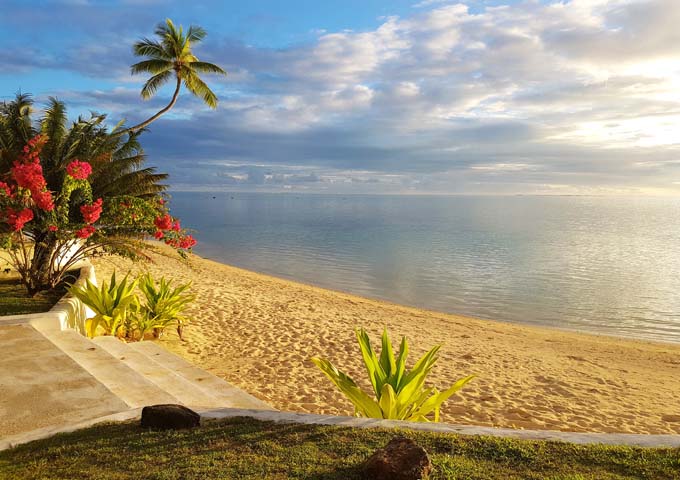
The best time to visit Tahiti is in May, June, September and October.
- Best Time to Visit Tahiti : May, June, September, and October.
- Best Time to Visit Tahiti for Good Weather : May to October.
- Best Time to Visit Tahiti for Sightseeing : May, June, September, and October.
- Best Time to Visit Tahiti for Honeymoons : May to October.
- Best Time for Diving & Snorkeling : April, May, June, September, and October.
- Best Time for Outdoor Activities : June to September.
- Best Time for Saving Money : Avoid the peak seasons (July, August, and the Christmas/New Year period) when the islands are bursting. Hotel rates increase and flights are sometimes overbooked, so plan ahead. Also, the local school holidays (especially in October) are busy times for inter-island flights.
- Best Time for Sightseeing : Like all tropical island regions in the South Pacific, there are 2 very important factors to consider when planning holidays. Tahiti is especially busy (and overpriced) during the major European vacation times of July and August, and the Christmas/New Year period from mid-December to mid-January. The second aspect is the wet season, which lasts from November to April. At this time, heavy rain is frequent, the humidity can be draining, and cyclones are possible (although very rare).
- Best Time for Diving & Snorkeling : Calm, clear waters are most likely between April and October, the driest months, but conditions do vary considerably because of local variations. And during July and August, trade winds bring relief onshore but can churn up the waves. During the wet season (November to April), rain and wind can also affect visibility, but this is less problematic in the shallow and mostly non-tidal lagoons that surround most of the atolls and islands.
- Best Time for Outdoor Activities : Not surprisingly, the weather affects the accessibility and enjoyment of all things outside. The wet season (November to April) brings heavy downpours, higher waves and stronger winds, and when it’s not raining, the humidity can be uncomfortable. Obviously, don’t go anywhere outdoors during any cyclonic activity. Hiking and surfing are optimal during the driest months of June to September, but remember: anywhere near the mountains will often be cold and wet throughout the year, and July and August can be surprisingly windy.
- Best Time for Beaches : During the dry season (May to October), daytime temperatures average around 25°C, becoming comparatively cooler later in the afternoon and during the evening. Water temperatures in the lagoons that surround almost all islands remain constantly inviting: from 23°C to 26°C. Swimming is sometimes more appealing in the wet season, if only to seek relief from the heat and humidity. Obviously, avoid any bad weather (particularly lightning), and never forget the sunscreen.
Tahiti Travel Seasons
- High Season (July, August, and mid-December to mid-January): This is the European holiday time, with the peak of the peak in August, when half of France seems to go away somewhere; and around the Christmas/New Year period. During these times, hotel rates will soar and some islands like Bora Bora, which has a dearth of accommodation anyway, are bursting. Always book way ahead, and remember that December and January is the height of the wet season, with cancelled flights not uncommon, and cyclones always possible (but very rare).
- Shoulder Season (May, June, September and October): These months are at the start and finish of the dry season, and exclude the peak holiday period (as explained above). The weather is very comfortable – mostly clear, mild and dry – and prices have yet to peak. Traveling around is easy, and numerous festivals rev up from May onwards.
- Low Season (November to mid-December, and mid-January to April): These periods are in the wet season, when rain is frequent, the humidity often unpleasant, and cyclones always possible, so be alert. Hotel rates drop considerably, and with so many empty rooms guests can negotiate. Finding seats on inter-island planes is rarely a problem – although flights can be cancelled due to bad weather or lack of passengers.
Tahiti Weather by Month
- Tahiti Weather in January : Being reasonably close to the equator, Tahiti is blessed with a tropical climate of warm and balmy days, with the heat often tempered by trade winds. The hot and rainy season peaks early in the year, with high temperatures (averaging 26°C in Pape’ete, but often nudging 31°C) and plenty of rain (about 315mm/12.5 inches) this month. When the rain stops and the sun is out, the humidity can force some visitors back inside. Cyclones in Tahiti are not as prevalent as its Pacific neighbours, but always possible from November to April, so check the local media, hotel announcements and official website .
- Tahiti Weather in February : The height of the wet season brings the greatest possible threat of cyclones. While many tropical depressions bypass the main tourist centres (and cyclones are very rare), they still bring peripheral winds and rains that make travel by plane and boat uncomfortable and sometimes, impossible. February sees a slight decrease in rainfall, but still enough to possibly affect travel plans.
- Tahiti Weather in March : Many of the most visited islands are mountainous, creating micro-climates along different coasts, while islands to the south can be considerably colder. But overall, rainfall has reduced dramatically in March to an average of 160mm – about half the amount from about 6 weeks earlier. The end of the wet season is nigh, signalling a substantial reduction in humidity, much to the relief of all, even the locals. Temperatures rise a little, often peaking at a year-high average of 31°C in some places.
- Tahiti Weather in April : Average rainfall is about the same as March, but the number of downpours starts to dwindle by the middle of the month, and humidity levels noticeably drop further. But don’t put away the umbrella and wet-weather gear just yet.
- Tahiti Weather in May : Official start of the dry and cooler season, sometimes called ‘winter’ by locals – and with it the chance of cyclones virtually disappears. The weather quickly becomes noticeably drier, with rainfall comparatively little until mid-October. Daytime temperatures remain stable, and reach about 30°C in some places, while night-time averages fall a couple of degrees to about 22°C.
- Tahiti Weather in June : Usually perfect weather, with heavy rain (hopefully) long gone, but perhaps more importantly, humidity is lower as it’s alleviated by increased trade winds. The seemingly endless dry and clear days coincide with the start of the busier tourist season. Nights are about 21°C on average, making it easier to sleep, and some locals start wearing jumpers and jackets after dark.
- Tahiti Weather in July : By now, some Tahitians even start complaining about the ‘cold weather’ (!) amid increased trade winds, which provide relief for many but are unwelcome by some (e.g. divers). But day after day, it’s pleasantly mild, with little or no rain. And it can even become comparatively chilly at night, with temperatures dropping to 20°C – and as low as 15°C in the Austral Islands in the far south; considerably colder than in any mountainous region. Packing a jumper or jacket is not as silly as it sounds anywhere in Tahiti.
- Tahiti Weather in August : The weather continues to be ideal, except the trade winds are at their strongest, sometimes making boat trips less pleasant, and masses have started arriving from Europe for their annual holidays. Daytime temperatures and rainfall are equally at their lowest for the year. Water temperatures are a little cooler, about 24°C, but the lagoons are still very swimmable.
- Tahiti Weather in September : Probably the optimal month to visit, with continuing dry and pleasant weather, and a significant reduction in hotel rates and tourist numbers. Stronger trade winds may linger, but are cooling rather than frustratingly blowy. Temperatures average 20-25°C during the day/night, and this month rivals August as the driest – almost 8 times less rainfall than December or January.
- Tahiti Weather in October : The last month for reliably mild weather. Although almost double the rain of September, it’s still half the precipitation of November. Average day and night temperatures start to rise by 1-2°C, and more noticeably, humidity levels increase, affecting the enjoyment of being outside for too long.
- Tahiti Weather in November : Official start of the wet season, also called the ‘summer’, which continues until late April. Average temperatures rise by another degree (Celsius), while the humidity becomes conspicuously more uncomfortable. Rainfall is double that of October and triple the amount from September. And cyclones are now possible (although very rare) anytime until April, so stay alert.
- Tahiti Weather in December : The wet season has well and truly started by now, with heavy downpours that could affect travel plans. Double the rain of November, exacerbated by high humidity. This month competes with January as the wettest, with over 300mm (12.4 inches), but rain is often immediately followed by extended bursts of sunshine. And tourist numbers increase dramatically during the Christmas/New Year period.
Tahiti Holidays, Events and Festivals
Tahiti events in january.
- New Year’s Day – a public holiday celebrated with gusto by everyone.
- Tere ‘A’ati (changeable, first or second week of January) – on Rurutu in the Austral Islands, with stone-lifting competitions, as well as traditional food, music, and dance.
- Tere Fa’ati (last Saturday in January) – traditionally-decorated trucks and buses take visitors to major sites around Tahiti Nui. Also, parades, music, dance, and food.
- Chinese New Year (changeable, January/February) – influential Chinese minority (and others) celebrate for a week or more with parades, fireworks, music, and arts. Mainly at the Chinese temple in central Pape’ete.
Tahiti Events in February
- Flower and Handicraft Festival (1st to 14th) – promoting indigenous flowers and traditional crafts from various communities across Pape’ete.
- Pacific International Documentary Film Festival (changeable, early February) – screenings and judging of short films from across the region. Mostly in French, but some in English. For a week in Pape’ete.
- Tahiti Guitar Festival (changeable, late February) – increasingly popular, with local and international acts. In Pape’ete for 2 days.
Tahiti Events in March
- Missionaries Day (5th) – also known as Gospel Day. Public holiday honouring the arrival of Protestantism over 220 years ago, with re-enactments and traditional dancing across the islands.
- International Women’s Day (8th) – marking the worldwide event with conferences and entertainment in Pape’ete.
- La Tahitienne (10th) – female-only sports carnival in Pape’ete linked with International Women’s Day just beforehand.
- Festival of ‘Uru (15th to 17th) – showcasing Polynesian food, particularly the revered ‘uru (breadfruit). In Pape’ete and a few villages around Tahiti Nui.
- Papara Pro Surf Festival (changeable, mid-March) – one of several competitions attracting diehards to the renowned reefs at Papara in southern Tahiti Nui.
- Tahiti-Moorea International Marathon (changeable, late March) – attracts some 2,000 runners, with fun activities before and after for all.
- Easter (changeable, March/April) – celebrated throughout the islands. Some facilities close for 4 days, while Good Friday and Easter Monday are public holidays. Easter Sunday is a great time to visit a church.
Tahiti Events in April
- Paddle Festival (7th) – paddleboard races, part of an international circuit. At Puna’auia on the west coast of Tahiti Nui.
- Jazz Festival (changeable, mid-April) – over a week in Pape’ete, a delight for enthusiasts with local and international acts.
Tahiti Events in May
- Labour Day (1st) – public holiday, with cultural shows, music, and dancing across the islands.
- Tahiti Pearl Regatta (7th to 13th) – largest sailing race in the Pacific. For all sorts of boats, from yachts to canoes, around Tahiti, Ra’iatea and Bora Bora islands.
- Victory Day (8th) – public holiday commemorating the end of WWII in Europe.
- Ascension Day (changeable) – public holiday 40 days after Easter Sunday.
- Whit Monday (changeable, May or June) – also known as Pentecost, a public holiday and religious event.
- Ta’iri Paumotu (changeable, mid-May) – festival in Pape’ete showcasing the unique guitar and ukulele styles of the Tuamotu Islands.
- La Ronde Tahitienne (changeable, late May) – international endurance bicycle race around Moorea Island.
- Tahiti International Golf Open (changeable, late May) – major event at the course in Papara in southern Tahiti Nui.
- Pareau Day (25th) – celebrating the history and beauty of the traditional pareau (like a sarong). Fun-filled activities throughout Pape’ete.
- Mother’s Day Fair (changeable, late May) – for about 1 week across the islands, showcasing indigenous arts and crafts as mothers are rightly revered.
- Flower Show (changeable, late May to mid-June) – displays of indigenous flowers, shrubs and plants. For 3 weeks at Faa’a (suburb of Pape’ete).
Tahiti Events in June
- Orange Festival (changeable, late June) – honours the popular fruit, with sports and music at Puna’auia, on the west coast of Tahiti Nui.
- Heiva Dances (changeable) – in the lead up to the major Heiva celebrations next month, dance schools around the islands practice and perform.
- Heiva Rima’i (from around mid-June for three/four weeks) – also linked to the Heiva celebrations next month, craft stalls in Pape’ete sell products from across Polynesia.
- Miss Tahiti (22nd) – honouring the beauty of Tahitian women, with pageants across the islands.
- Hivavaeve (29th) – also known as Internal Autonomy Day. Public holiday celebrating when French Polynesia was granted self-government (but not independence). Parades and concerts in all towns, but particularly flamboyant in Pape’ete.
Tahiti Events in July
- Heiva i Tahiti – everyone seems to go a little crazy during July. Expect lots of hip-swinging dancing, ukulele-playing, canoe racing and sporting carnivals across all islands. Especially appealing at Bora Bora.
- Marae Arahurahu Re-enactment (changeable) – along the west coast of Tahiti Nui. Historical re-enactments and traditional dancing.
- Tahiti Traditional Sports Championship (changeable, mid-July) – plenty of fun, with local sports, such as fruit-carrying, in Pape’ete.
- Bastille Day (14th) – public holiday celebrated across the islands with food, singing and fireworks. Pape’ete also hosts a military parade.
Tahiti Events in August
- Rautirare Festival (first weekend in August) – more water-sport competitions, including surfing, paddle-boarding and beach soccer. For several days at Mataiea in southern Tahiti Nui.
- Assumption (15th) – public holiday, with church services held throughout the islands.
- Super Aito Vaa (changeable, mid-August) – another popular and serious race featuring outrigger canoes. Starts and finishes at different places each year.
Tahiti Events in September
- Ra’iatea Gliss Festival (changeable, early September) – Ra’iatea Island comes alive with entertainment and water sports.
- Ukulele Festival (changeable, mid-September) – promotion and performances of this much-loved instrument across Tahiti Nui.
- Salon des Australes (changeable) – festival in Pape’ete showcasing artistry from the Austral Islands, renowned for baskets and hats made from pandanus leaves.
- Tahiti Nui Tour (changeable, mid-September) – major event on the international cycling calendar.
- Farereihaga (changeable, mid-September) – tourism festival at Rangiroa in the Tuamotu Archipelago, with cultural shows and competitions.
Tahiti Events in October
- Stone-Throwing Competitions (early October) – at various locations, mainly Maupiti and Bora Bora islands, honouring the ancient tradition of fishing using stones.
- International Graffiti Art Festival Ono’u (changeable, start of October) – discussions and displays of street art from across the Pacific. At Pape’ete for several days.
- Vaipahi Run (changeable, late October) – grueling cross-country race starting on the west coast of Tahiti Nui.
- Reva i Eimeo Nui (last Saturday in October) – truck tours of Moorea Island, with traditional food and wandering ukulele players.
Tahiti Events in November
- All Saints Day (1st) – public holiday honouring various venerated saints. Many locals visit graves of relatives.
- Armistice Day (11th) – commemorates the end of WWI.
- Lychee Run (changeable, early November) – challenging cross-country race at Tubuai (Austral Islands) celebrating Tahiti’s favourite fruit.
- Hawaiki Nui Canoe Races (changeable) – serious races around Hauhine, Ra’iatea and Bora Bora islands. Over 3 days, with lots of fun for all.
- French Polynesia Book Fair (changeable, mid-November) – all things literary, with speakers, launches and readings featuring writers from across the Pacific. In Pape’ete.
- Matari’i Ni’a (changeable, late November) – many traditional events across the islands as locals are grateful for the rain and hopeful of a plentiful harvest.
- International Tattoo Festival – tattoos are an integral part of Tahitian culture. Experts and enthusiasts flock to Pape’ete to admire the art of skin painting.
Tahiti Events in December
- Pineapple Festival (changeable) – on Moorea Island, with concerts, craft stalls and displays of local foods. Highlight is the making and eating of the Giant Pineapple Cake.
- Tuamotu Inter-Island Games (changeable, mid-December) – serious and fun events for over a week across the Tuamotu Islands, with traditional sports such as palm-tree climbing.
- Christmas Day (25th) – celebrated fervently. Also a public holiday, with most shops and restaurants closed for several days, and public transport almost non-existent.
- Boxing Day (26th) – Christmas celebrations continue, although not a public holiday.
- New Year’s Eve (31st) – commemorating the changing of years with parties across the islands and fireworks in Pape’ete.
About Santorini Dave

When is the best time to visit Bora Bora

Dec 12, 2023 • 6 min read

Bora Bora is one of the most blissful places on the planet – find the best time for your trip © Maridav / Shutterstock
With its turquoise lagoon, blonde beaches and lush mountain backdrop, Bora Bora is the epitome of a tropical paradise. Typically pictured with clear blue, sunny skies or fiery sunsets, this is the luxury island escape that many travelers dream of – and thanks to year-round warm temperatures, there's no such thing as a bad time to visit.
From snorkeling alongside rays and reef sharks to hikes around ancient ceremonial sites, spending time in Bora Bora is truly a balm to the soul. However, the photos of cloudless blue skies that you see on social media don't paint the full picture – this is the South Pacific and the island has a tropical rainy season from December to March.
But don't let a little rain put you off – visiting during the rainy season has its advantages too! Here's what you need to know about the best times to visit Bora Bora.
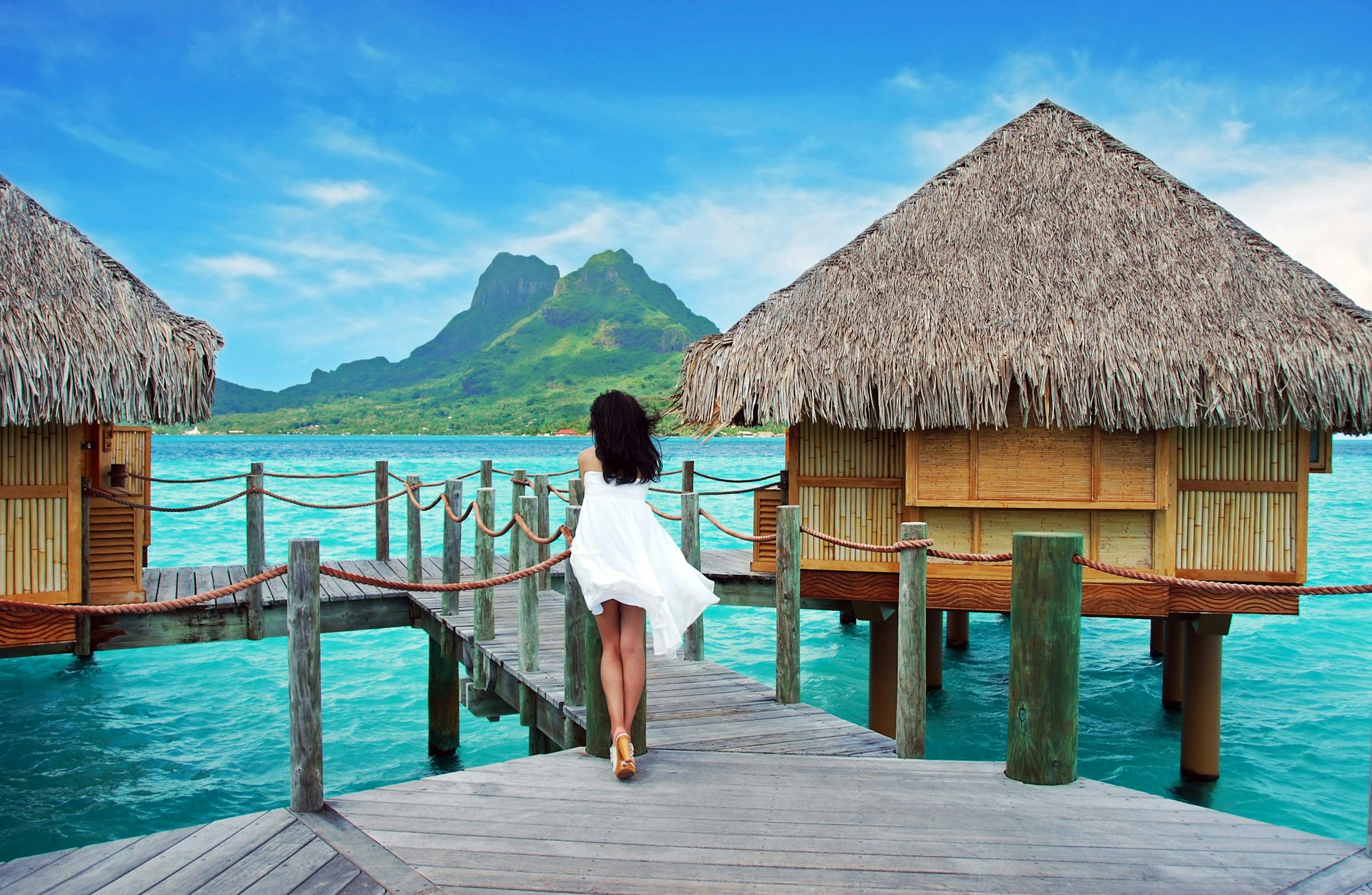
December to March is the best time to visit on a budget
As Bora Bora's dry season comes to an end, the days start to get cloudier and there's an increased chance of rain. The temperatures creep up a little higher and the humidity kicks in. This change in the weather marks the low season for tourism, but this can be advantageous to travelers who have a limited budget and don't mind some clouds in the sky. Cyclones (hurricanes) are rare but they can blow through at this time of year.
During the rainy season, many of the island’s top resorts drop their rates as demand falls. This makes a plush stay at an overwater bungalow resort, such as the luxurious Four Seasons Bora Bora , much more affordable. Another advantage to the low season is the lack of crowds; most visitors crave those iconic blue skies and you can end up with an entire beach to yourself when the weather is more unpredictable.
December is the most humid month in Bora Bora but the cloudy skies don't put a dampener on Christmas. Enthusiastic celebrations happen across the island as locals throw themselves into the holiday spirit; tourists are made to feel very welcome at local events. Visitor numbers are at their lowest in January but if you've decided to snap up a hotel deal, make time to experience the Taurua Varua festival – one of the most important religious occasions in the islands that's celebrated with traditional singing.
February sees less rain than January, though this month has the highest chance of a cyclone. As French Polynesia lies off the main cyclone belt, these are quite rare but the chance is still there (the last major cyclone was in 2010). Humidity is high, which can be uncomfortable during the day, but it also brings some of the most incredible sunsets you’ll ever see. Again, tourism is slow during this month so prices tend to be lower at resorts.
As March rolls in, the rain decreases further, though you'll likely still experience daily showers and high humidity. Tourists are still scarce but March marks the beginning of event season, with competitions to find Bora Bora's best orero (guardian of spoken history).
April and November give the best combination of weather and prices
The months of April and November fall between the wet and dry seasons, offering some of the advantages of both. During these months, you'll see fewer crowds and you can find some generous deals from resorts, but the weather still brings plenty of sunshine.
There will be some rain and humidity, though the rain showers tend to pass quite quickly. April brings the start of the main scuba diving season as the absence of strong winds makes for calm, clear waters – perfect for spotting sharks, manta rays, barracudas and more out in the deep blue. This visibility also occurs in November, which is why it's also a popular time for underwater adventures. The Hawaiki nui va’a is a wonderfully fun and hectic time of canoe races around the island and islets. Join the locals and cheer on your favorite towards victory!
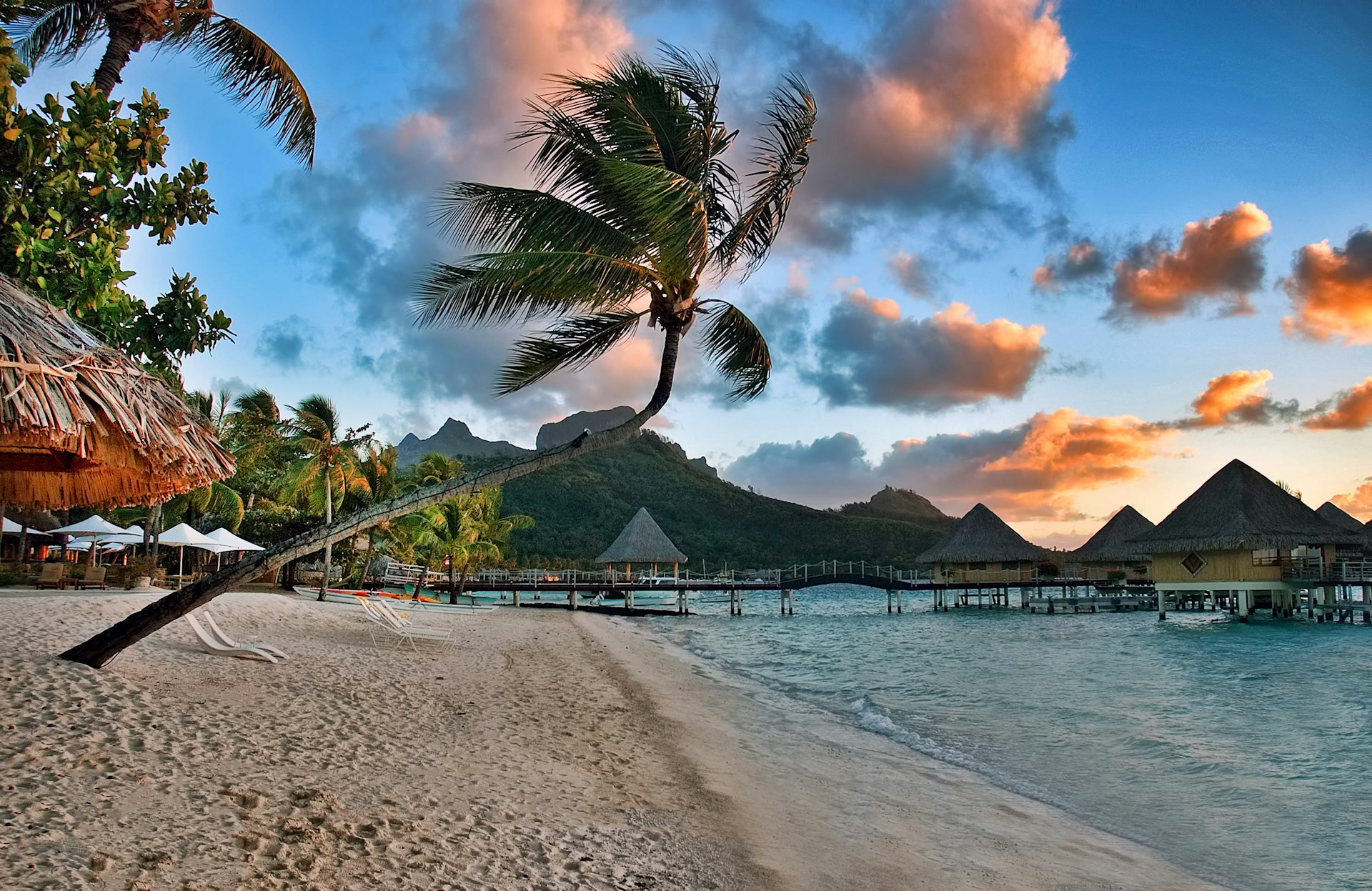
May to October is the best time for blue skies and sunshine
The dry season in Bora Bora takes place over the southern hemisphere winter months (May to October) on the island. The dry months see low levels of rainfall, so you can be confident that you will have clear blue skies with plenty of sunshine for much of your stay. Temperatures during the winter are also less intense than in the summer months, with daytime highs around 28°C (82°F ).
This ideal weather for basking in the sun makes the dry season the most popular time to visit Bora Bora. Unfortunately, this means higher prices at resorts and bigger crowds across the island. If this is your dream time to visit, start looking at flights well in advance as seats get snapped up quickly.
Though the high season kicks off in May, the main crowds haven't arrived yet. Water conditions continue to be ideal for scuba diving and the Tahiti Pearl Regatta sailing race draws teams from across the globe. Come June you’ll notice a drop in temperatures at night and the humidity decreases too, making this a perfect month to visit. It's also when school holidays start in North America and Europe, bringing vacationing families to the resorts. The wind tends to pick up in June, creating ideal conditions for sailing and kiteboarding, but decreasing the visibility for scuba diving.
Bora Bora's biggest cultural festival, Heive I Bora Bora, takes place in July, making this one of the best times to visit the island. Expect plenty of carnivals, singing, boat racing and all-round revelry across the island. August tends to be the busiest month and is when most European visitors head to the island. The trade winds make the heat less intense and long hours of sunshine make for blissful times on the beach .
Things start to quiet down a bit in September as it’s back-to-school season for many families visiting from the northern hemisphere. This also marks the height of humpback whale season in Bora Bora (which runs from mid-July to the end of October). This is the best time to see mothers and their calves in the waters surrounding the island; you can’t swim with them here as you can in Mo’orea , but there are plenty of excellent whale-watching tours.
October marks the end of the high season. Towards the end of the month, you’ll notice more humidity and rain but there's still a lot of sunshine to enjoy. Local school holidays during this month bring families to the beaches and scuba divers return to the water as it tends to be calm, meaning great visibility.
This article was first published Nov 17, 2021 and updated Dec 12, 2023.
Explore related stories
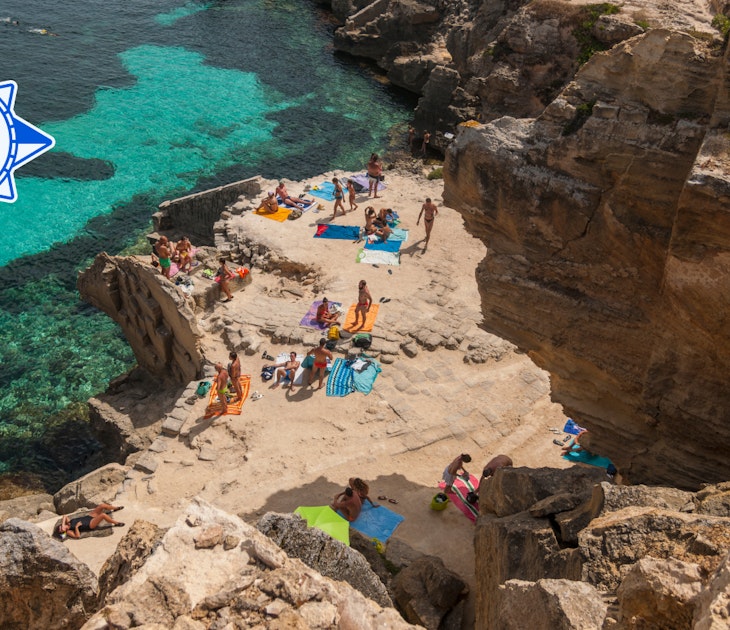
Tips & Advice
Apr 15, 2024 • 10 min read
From chilling on the beaches of Bora Bora to eating shellfish in Cape Cod, USA, here are the best places to visit in June.

Jan 17, 2024 • 8 min read
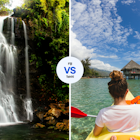
Jun 28, 2023 • 6 min read

Oct 26, 2022 • 4 min read

Mar 28, 2022 • 3 min read

Jan 18, 2022 • 6 min read
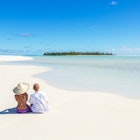
Jan 5, 2022 • 5 min read

Nov 23, 2021 • 7 min read

Oct 28, 2019 • 19 min read

Jan 29, 2024 • 11 min read
The Best Time to Cruise Tahiti, Bora Bora and French Polynesia
When to go, tahiti, bora bora, and french polynesia weather .

May (Shoulder Season)
June - august (high season) .

September and October (Shoulder Season)
November to april (low season), want to go, south pacific, south pacific travel guide.
- All South Pacific Trips
- All South Pacific Videos
- All South Pacific Travel Stories
- Papua New Guinea Overview
- Fiji Overview
- Marquesas Islands Overview
- Tahiti Overview
- The Solomon Islands Overview
- When to Visit the South Pacific
- Easter Island
Favorite South Pacific All Trips
- Cook Islands & Society Islands
- Hawaiian Seascapes
- Marquesas, Tuamotus & Society Islands
Top South Pacific Travel Destinations
- Auckland Islands
- Campbell Island
- Cook Islands
- Enderby Island
- Invercargill
- Macquarie Island
- Milford Sound
- Mitchell Falls
- New Zealand
- Papua New Guinea
South Pacific Trips by Departure Date
- 2024 South Pacific trips (61)
- 2025 South Pacific trips (71)
- 2026 South Pacific trips (13)
- July 2024 (15)
- August 2024 (17)
- September 2024 (15)
- November 2024 (21)
- December 2024 (21)
- January 2025 (25)
- February 2025 (17)
- July 2025 (15)
- December 2025 (17)
Top Experiences in South Pacific
- South Pacific Cruises (102)
- South Pacific Beaches (30)
- South Pacific Cultural (26)
- South Pacific Wildlife & Safari Exploration (23)
- South Pacific Luxury (12)
- South Pacific Active (8)
- South Pacific Trekking (4)
- South Pacific Land Tours (3)
- South Pacific Most Popular (3)
- South Pacific Scheduled Group Tour (3)
South Pacific Trips by Duration
- 5 day trips (3)
- 7 day trips (4)
- 8 day trips (6)
- 9 day trips (3)
- 10 day trips (7)
- 11 day trips (18)
- 12 day trips (11)
- 13 day trips (5)
- 14 day trips (5)
- 15 day trips (12)
- 16 day trips (5)
- 17 day trips (7)
- 25 day trips (4)
South Pacific Trips by Activity
- South Pacific small ship cruises (94)
- South Pacific wildlife viewing (77)
- South Pacific snorkeling (44)
- South Pacific village visits (31)
- South Pacific kayaking (29)
- South Pacific scuba diving (20)
- South Pacific archaeological site visits (17)
- South Pacific hiking (16)
- South Pacific whale watching (15)
- South Pacific spa relaxation (14)
- South Pacific wine tasting (7)
- South Pacific helicopter tours (7)
- South Pacific stand up paddle boarding (6)
- South Pacific adventure options (5)
- South Pacific land & sea exploration (5)
- South Pacific small ship sailing (5)
- South Pacific rainforest exploration (3)
- South Pacific photography seminars (3)
Why Travel With Adventure Life
Recognized by.


Best Time to Visit Tahiti

Climate Overview

Beach Vacation in February

Best Time to Visit Tahiti: Overview
Climate chart tahiti.
Source of Data: German Weather Service (Offenbach) and Wikipedia
Climate Table Tahiti
Temperatures, precipitation, sunshine in papeete (tahiti), popular activities, current weather and forecast.
French Polynesia: Regions
Best time to travel for the regions.
Papeete: May , June , July , August , September , and October
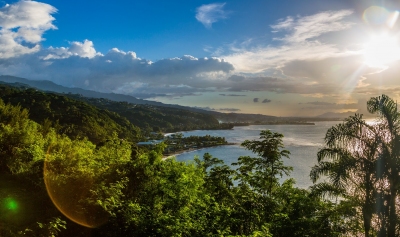
Distances to Tahiti
Where’s tahiti, continent: oceania, share your experience and win.
Head Over Tahiti
Destinations in the vicinity ….
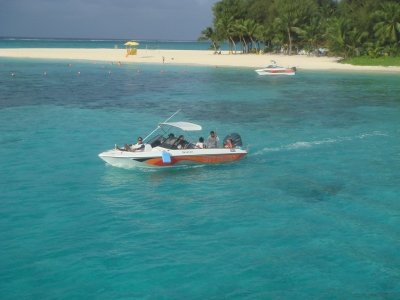
- Imprint / Privacy
- Image Sources
The Best Time To Visit Tahiti – Enjoy the Good Weather!

- Latest Posts

- KLM vs Delta: Is KLM a Good Airline? - January 26, 2022
- The Best Time To Visit Brazil – Seasons, Events, Activities! - January 23, 2022
- The Best Time to Visit Fiji: All About Fiji Travel Seasons! - January 22, 2022
Tahiti is one among the five high Islands that form French Polynesia, a tropical paradise lying partially between Los Angeles and Australia. The other four islands are Raiatea, Bora Bora, Huahine and, Moorea. Aside from these, there are three isles on Polynesia namely; Fakarava, Manihi and Rangiroa.
Flying to this region from the United States will take you about eight hours though they seem like they are planets away because of their beautiful beaches, blue water, and lush vegetation. There are surely many reasons why you will want to visit Tahiti, which is referred to as the queen of other Islands of Polynesia.

Looking for sports, concerts, or music festivals? Find your perfect holiday or city break and save now at Expedia.com
Tahiti is an island lying in the South Pacific and has a reputation for its magnificent waterfalls, popular overwater houses, delicious seafood, and beautiful beaches. It is just a few kilometers from Moorea which has a reputation for shark sightings and stingrays. The best spot for honeymoon couples, Bora Bora is also just minutes away from these two.

In Tahiti, you are sure to relish the tropical climate as the sun shines for about 3,000 hours a year. This is one of the highest sunshine per year in the world but it does not stop the weather being cool in some moments.
The Pacific winds often blow over this region thereby cooling it all through the year. Similar to the lagoon waters, the ambient temperature averages at 78°F/25°C meanwhile, the temperature down south in the archipelagos (the Gambier Islands and the Austral Islands) is cooler.
The typical seasons you find in your immediate environment is different from that in Tahiti as you will find the temperatures climbing close to the high mid-80. The lows could be around 70 degrees throughout the year. This doesn’t stop the region from having rainfalls as other regions.
So, if you’re visiting the Island, any time of the year is ideal for tourism, although it depends on your choice and the kind of experience you’re after. However, you would want to visit Tahiti in the dry weather when you can have clear water for diving but at the same time, you might not want to arrive when there are large crowds.
With the location of Tahiti in the center of the Pacific Ocean and having countries like America, China, Australia and Brazil surrounding it, you are sure to find numerous visitors there during the holiday period. Hence, you might want to time your trip carefully so that you won’t have many headaches when you arive.
Best time to visit Tahiti: Weather considerations
In every month of the year at Tahiti, you could find similar weather temperature except when it is raining. The rainfall at Tahiti could not be a good idea for tourists though some activities in this period could be exciting too. However, you should endeavor to come along with an umbrella if this period is ideal for you.
There is a tendency of the humidity being high throughout the year at Tahiti as January kicks off a moment of discomfort due to the weather. However, this ends in March but only with a little difference as all the months are similar.
At all times of the year, you are sure to find winds in the region especially in the afternoons when they are higher. For this reason, you get some coolness as the winds are really pleasant and cool.
You will find the bars and restaurants in the South Pacific normally at the exterior of their buildings or outdoors. They normally have shades of palm or fabric so that the people do not have complaints due to the humid weather.
When in such restaurants at noon, the wind blows calmly and you do not feel much of the humid weather. Additionally, the managers of the bungalows normally install their houses with air conditioners so that you could have a wonderful stay.
Best time to Visit Tahiti to enjoy good Weather

Almost year-round in Tahiti, the weather is mostly warm and the temperatures hardly drop lower than 70 degrees F especially during winter. In summer, the temperature climbs to about the mid-90s but due to the wind blowing throughout the whole island, you won’t experience the heat as in other parts of the world.
The storm in the rainy season lasts for about half an hour and you will green and lush vegetation everywhere. Flowers also blossom and fill the air with their lovely fragrance and the water is warm; perfect for scuba diving and snorkeling.
From May to October, their region is dry and it is a great time to fly in too. The weather is at about 68 degrees F in the early morning and 82 degrees in the daytime. In November, the rain starts till April and you will find the weather at temperatures ranging between 72 and 86 degrees.
Most activities at Tahiti begin from November till March and you can catch a view of the picturesque equinox that appears in late March. It is a period when beautiful sky colors from the moon and sun reflect in the water.
Tahiti’s Tourist Seasons
There is no actual season in Tahiti you can refer to as rainy season as you will see in several tropical spots. In May, the dry season begins to end in October, and in July and August, you are sure to find the weather. The summer season at Tahiti which is also known as the humid period lasts from November to April and the dry season is a period when tourism is at its highest.
Hence, if you wish to relish good weather and abundant availability of rooms, then you should come in, May, June, September, and October.
- High Season (July, August, and mid-December to mid-January): In this period, Europe is on holiday. It is a time when nearly half the French take vacations and you are sure to have high hotel rates.
July and August are the busiest months in French Polynesia because the kids on the island are on holiday. The Heiva Nui festival also takes place in July and you will find tons of tourists in the region. Traditionally, the French take their vacation in August and they land in mass at the island in this season.
Some popular days fall in this period like; Bastille Day, Christmas, Pentecost Monday, Missionary Day, Good Friday, Labor Day, Easter Monday, and Ascension Thursday. On these days, you wouldn’t be surprised to find government offices and shops closing just to honor these days.
So if you are traveling then, be sure to book in advance so that you do not fall into the long waiting or flight cancellation group.
- Shoulder Season (May, June, September, and October): This is the duration from the beginning of the dry season to its end. The peak holiday is not in this period and you will find the weather very comforting and clear. You can also easily go around and join in the several festivals that begin in May.
- Low Season (November to mid-December, and mid-January to April): In this period, the rain comes frequently and you will find the humidity very nasty. There are also possible hurricanes and the hotels’ rates are inexpensive. You can easily get a flight although the weather and passenger count could cause regular flight cancellations.
Best Time to visit Tahiti for Sightseeing

When making plans for a vacation in Tahiti, there are two very important factors you ought to consider. The first should be your expenditure which you could experience at a high rate in July and August. The Christmas/New Year period which lasts from mid-December to mid-January is also a time you would get higher rates.
The weather is the second factor and the wet season isn’t a good time to travel. It lasts from November to April and there is frequent rainfall, humidity at its top and possible tornadoes too.
Best Time for Diving, Scuba diving & Snorkeling
The driest months of the year at Tahiti are April and October when you find the waters clear and calm. This is a great time to have underwater activities due to the warmth of the ocean. When coming, you are also sure of getting the rooms at lower rates and have good weather.
Best Time for Outdoor Activities
Having outdoor activities could be frustrating sometimes at Tahiti as in the wet season, there are heavy rain downpours and when there is no rain, you find humidity very discomforting. However, you could relish the dry season from June to September for activities like surfing and hiking.
You should also note that there is a considerable amount in the mountains all year round while July and August have sufficient wind. So, you might need your jacket or coat when going to the region in these periods.
Best time to visit Tahiti for off-season deals: November to May
If you arrive at Tahiti in November, you can find the rooms at quite cheaper rates. This hotel deals last till sometime in May, though you might meet some traffic in December. This period is more humid but you have your fresh sea breezes close enough to cool you off. This period is not usually sufficient for tourists who wish to have adequate sunbaths as the region is mostly covered by clouds that look beautiful at sunset.
Best time to Visit Tahiti For events
Most of the popular events of Tahiti are scheduled during their peak tourist season and one such mega-events is Heiva which is commonly held in June/July. Also, there is the Billabong Pro in August and the International Golf Championship in September.
Even though June, July, and August are frequently taken as the best time to visit Tahiti, it’s essential you also know that this is an equal period with the largest crowds on the island characterized by an inflow of tourists and holidaymakers.
Because Tahiti has good weather all through the year, you can decide to plan your visit during the off-season to benefit from a bit reduced price of hotels and resorts. This season is equally quieter and with the reduced crowds.
All-year-round events in the Island attract visitors and tourists with interests in flowers, ukuleles, boat races, and festive costumes. For instance, if you are after grand events and festivals, you can visit Tahiti in July to be part of the celebration of the month-long Heiva holiday and French Bastille Day celebrations, with fresh local cuisine, dance competitions, crafts, sporting events and live music.
The great Billabong pro surfing competition normally occurs at the end of August. Chinese New Year is also celebrated with parades and festivals.
January Events
- New Year’s Day
- Tere ‘A’ati (This takes place during the first or second week of January)
- Tere Fa’ati (Events occur during the last Saturday of January).
- Chinese New Year (January/February)
February events

- Flower and Handicraft Festival (1st to 14th)
- Pacific International Documentary Film Festival (occur in early February)
- Tahiti Guitar Festival (Occur in late February)
March events
- Missionaries Day (5th March).
- International Women’s Day (8th March)
- La Tahitienne (10th March)
- Festival of ‘Uru (15th to 17th of March)
- Papara Pro Surf Festival (middle of March).
- Tahiti-Moorea International Marathon (late March).
- Easter (Between March/April)
April events
- Paddle Festival (7th April) – paddleboard races which are part of an international circuit.
- Jazz Festival (middle of April) A festival that draws lovers of Jaz music and showcases both local and international acts.
- Labour Day (1st May).
- Tahiti Pearl Regatta (7th to 13th May) –The biggest sailing race in the Pacific.
- Victory Day (8th May) – public holiday celebrating the end of WWII in Europe.
- Ascension Day
- Whit Monday or the Pentecost (May or June)
- Ta’iri Paumotu (middle of May)
- La Ronde Tahitienne (late May)
- Tahiti International Golf Open (late May)
- Pareau Day (25th May)
- Mother’s Day Fair (late May).
- Flower Show (late May to the middle of June)
June events
- Orange Festival -late June
- Heiva Dances
- Heiva Rima’i (starting from the middle of June and lasts for three/four weeks)
- Miss Tahiti (22nd June) – A celebration of the beauty of Tahitian women.
- Hivavaeve (29th June) – Equally referred to as Internal Autonomy Day celebrated with Parades and concerts in all towns. The celebration is especially flamboyant in Pape’ete.
July events
- Heiva I Tahiti
- Marae Arahurahu Re-enactment
- Tahiti Traditional Sports Championship (middle of July)
- Bastille Day (14 th July)
August events
- Rautirare Festival (first weekend in August)
- Assumption (15th)
- Super Aito Vaa (middle of August)
September events
- Ra’iatea Gliss Festival (early September)
- Ukulele Festival (middle of September)
- Salon des Australes (alterable dates).
- Tahiti Nui Tour (middle of September)
- Farereihaga (middle of September) tourism festival at Rangiroa
October events
- Stone-Throwing Competitions (Beginning of October)
- International Graffiti Art Festival Ono’u (Beginning of October)
- Vaipahi Run (late October)
- Reva I Eimeo Nui (last Saturday in October)
November events
- All Saints Day (1st Week of October)
- Armistice Day (11th October)
- Lychee Run -early November– a challenging cross-country race
- Hawaiki Nui Canoe Races
- French Polynesia Book Fair –middle of-November.
- Matari’i Ni’a -late November
- International Tattoo Festival
December events
- Pineapple Festival – a celebration with craft stalls and displays of local foods with a highlight of Giant Pineapple Cake.
- Tuamotu Inter-Island Games (alterable, middle of December)
- Christmas Day (25th December)
- Boxing Day (26th December)
- New Year’s Eve (31st December)
Best time to visit Tahiti to enjoy the beach

Tahiti’s dry season runs through May to October with average daytime temperatures of roughly 25 degrees Celsius. The afternoon and evenings are normally cooler. Planning your visit to Tahiti around this time despite the warm temperature and the high humidity will make you enjoy the cooler crystal clear waters around the Islands.
Besides, the crowds have dwindled and you’ll not have to queue up to engage in some of the activities on the Island like diving, surfing, boating, exploration of dolphins and fishing in the deep sea. The temperature of the lagoons that cover nearly every part of the islands is equally attractive with the range of roughly 23 degrees Celsius to 26 degrees Celsius.
Sometimes, you’ll equally appreciate swimming during the rainy season. It could serve as a relief from the heat and high humidity. However, if you plan to swim at this time, be cautious of swimming under any bad weather especially lightning. Remember to always make your sunscreen a companion.
Best Time to visit Tahiti for Saving Money
If you’re are planning to visit Tahiti for your vacation during the bargain season, stay away from the peak seasons which falls around July, August, and during the Christmas/New Year period when there are a lot of crowds in the islands.
These times are characterized by high hotel rates and airfares are occasionally fully booked. The best thing you can do if you’re traveling at this time is to plan. The local school holidays in October are equally a busy and costlier time to visit especially due to inter-island flights.
November-December-January
November through January in Tahiti is characterized by fewer crowds because this period falls within the wet season. If you don’t mind the rain and humidity, these months are great for saving money because airfares cost considerably lower. You can get up to a 50 percent discount compared to the price you pay during the peak season. prices. A lot of hotels, also, are comparatively cheaper per night during the wet season.
It is easier to book for your trip within this time than any other time of the year. You’ll always get a place to stay even when you make a last-minute booking unlike when you book during the peak seasons.
February-March-April
Starting from February-March-April, the prices start to gradually go up as the peak season approaches. However, even this time, prices are still many hundred dollars lower than what you pay if you visit during the peak of the dry season. The cost of hotels and accommodations equally increases roughly twenty-five percent from January to April.
You can still make your flight and hotel bookings fairly easy at this time as rooms and air tickets are not sold out yet.
May-June-July
May through July comes with lovely weather and as you’d expect, high prices. By mid-July, the costs of things are at their peak. Even when you make your bookings well in advance, hotel rates, airfares, and other things will cost far more than what you get at other times of the year.
If you need to visit the Tahiti islands within this time, be on the lookout for flash sales and make your bookings when the prices are very low. It could be within the middle of the week, during the month-end, or near to the shoulder months.
Not only does peak season guarantee big prices, but it also guarantees big crowds. Tahiti sees some of its highest numbers of tourists on the islands during these months, especially because it is officially summer vacation time for much of the world. Accommodations will fill up rapidly as the season approaches, so book well in advance.
August-September-October

The cost of visiting and staying in Tahiti will still be on the high side within these months because they are still closer to the peak travel season on the Island. To get the cheapest rate, plan your visit far away from the peak season.
Consider traveling around the middle of September and later, when the crowd is less and schools have resumed and many parents have gone back to their works. The price s at this time can be significantly lower but for you to be certain, you should constantly check the flights and hotel prices to know when the rates are down.
So. the later you book into September and October, the cheaper and easier it will become. However, no matter what time you book in the dry season, booking is not easy but it mostly depends on what you’re booking and where.
You may find out that most rooms in some hotels are completely even in October. The airfares may not also fall as much as you’d want them to. Keep an eye on the prices of airfares and accommodations and be the first to catch up on the opportunity.
FAQ’s About Tahiti
Tahiti’s humid season falls around November to April. While the Island may occasionally experience heavy storms, they are not Hurricanes. There is rarely a history of Hurricanes in Tahiti or anywhere in the South Pacific.
The wet season, also known as the humid season begins in November and culminates in March. And with it, the weather is a bit muggy, characterized by high humidity and the Island frequently experiences heavy downpours. You may equally experience tropic downpours at these times.
Tahiti is a popular posh honey destination regarded as a Jewel in the crown of French Polynesia. Tahiti is one of the luxurious tropical islands written in kiddies’ adventure novels, a Mutiny on the Bounty-style Eden of coconuts, pearls, and bikinis. Tahiti is located in the Windward group of Island Society.
Tahiti is a safe place for tourists. Generally speaking, there are only a couple of dangers to watch out for: pickpockets in Pape’ete and moray eels in the coral reefs on scuba dives. Most visitors soon discover that Tahiti is warm and welcoming to foreigners.
Best Time to Visit Tahiti – Conclusion
There’s no bad time and no one good time to visit Tahiti. The Island features balmy weather throughout the year. No matter when you choose to visit the Island, you have some amazing sights, aromas, and experiences in your favor. The best time to visit the Island is potentially in the winter with lower humidity and more tolerable temperature.
To experience the best Tahiti temperature, plan your trip from May to October but make your reservations way in advance. If you’re visiting to experience Tahiti’s events and cultural festival, July is your best time to visit. The best time to visit Tahiti for surfing is between August and September when there are tournaments.
Skip November to March if you don’t want to deal with a potential hurricane or weather-related issues which could lead to cancelation of flights. And if you want to visit during the quietest time with the least crowd, plan your visit in September or November.
Overall, the best time to visit Tahiti for pleasant weather, affordable rates, and fewer crowds is during the shoulder season which falls around May or November.

Quick & Easy Way To Book a Hotel. Best Price Guaranteed! Find the Lowest Room Rates with One Easy Search. Book & Save Today.
Recommended Reads:
- Where to Stay in Maui: Ideas For Places To Stay In Maui!
- The Best Time to Visit Fiji: All About Fiji Travel Seasons!
- The Best Time to Travel to Aruba – All You Need to Know!
- Work With Me
Home » Blog » How To Plan A Trip To Tahiti: Ultimate Tahiti Travel Guide
How To Plan A Trip To Tahiti: Ultimate Tahiti Travel Guide
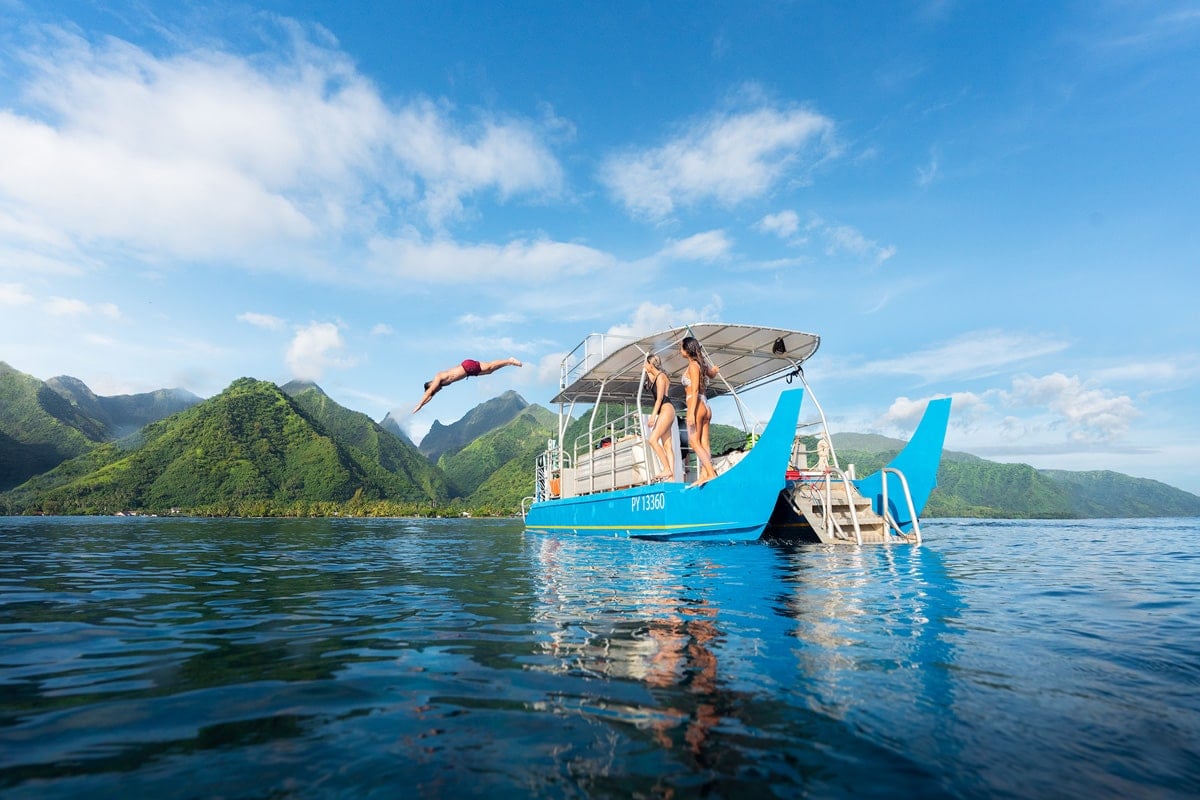
We’ve all seen the photos of Tahiti while scrolling through social media. Impossibly blue water, palm trees lining deserted beaches, and lush mountains that reach far down to the ocean below. Well, all of it is real, and the photos might not even being truly doing the Island of Tahiti justice!
I have visited French Polynesia twice now, and both times I felt like I was constantly having to pick my jaw up from the ground. The beauty is hard to beat, and there are just SO many fun things to keep you busy during your time on the islands. Or, just put on your favorite bathing suit and relax by the beach, I won’t judge.
In this blog post, I’m sharing everything I have learned about planning a trip to the Islands of Tahiti . Including how to get there, tips for choosing where to stay, what to pack, and more. Planning a trip to Tahiti can be a little logistically confusing at first. So let’s clear that up and have you begin your trip of a lifetime!
Disclaimer: This blog post is in partnership with Tahiti Tourisme and Air Tahiti Nui . As always, all opinions are my own . This article also features some affiliate links, which means I get a small commission if you make a purchase (at no extra cost to you). Learn more about my affiliate policy here . Thank you for the support!
How To Plan a Trip To Tahiti
There are a few things you need to know when planning a trip to Tahiti. Firstly, people often don’t realize that Tahiti is just one of over 100 islands in a region of the South Pacific that make up the country of French Polynesia . Technically, French Polynesia (sometimes also known as “The Islands of Tahiti”) is a collectivity of France, although it does have its own branches of government. You will find that I use the terms Tahiti , Islands of Tahiti , and French Polynesia interchangeably throughout this blog post.
Secondly, the national currency of French Polynesia is the Pacific Franc, also known as CFP Franc or XPF. Although US dollars are accepted in some of the more western establishments, it is important to carry local currency for smaller vendors and tour operators where US currency may not be accepted.
Finally, tipping is not standard practice in French Polynesia like it is in the United States. Yes, you are free to tip if you feel someone has given you exceptional service, but they will not be expecting it.
Now that we have covered the basics, let’s jump into some more specific information about planning your trip to Tahiti!
How To Get To Tahiti
The best way to get to Tahiti from the mainland of the United States is taking a non-stop flight from Los Angeles or San Francisco. From Los Angeles it will take you less than 8 hours to fly there with Air Tahiti Nui . This is the option my husband and myself chose for our most recent trip, and it was a great experience all-round.
We have flown Air Tahiti Nui’s premium economy and business class and these were two of the most comfortable flights I’ve ever taken! I’m sure many of you out there are like me and despise airplane food, but the food with Air Tahiti Nui was actually great, and the customer service was top-notch. Another good thing about flying with Air Tahiti Nui is getting access to a lounge at both LAX and also at Faa’a International Airport in Tahiti.
Alternatively, you can also fly non-stop from San Francisco, which will take a little over 8 hours. These flights are operated by French Bee and United Airlines. Keep in mind that Tahiti can also be accessed via cruise ship , either arriving from international seas or departing from within the country itself.
One thing to note is that many people think you can just fly to Bora Bora and the other French Polynesian islands directly from mainland USA. This is incorrect, as all flights from the United States must first pass through Faa’a International Airport on the island of Tahiti before continuing on to other islands.
TRAVELING TO TAHITI DURING THE PANDEMIC
As of May 1st 2021 , the following entry and stay protocols are in place for travel to the Islands of Tahiti. More information can be found via the Tahiti Tourisme website and this fact sheet . Note that this information is relevant to US travelers, as currently, only people who have been in the US for 30 consecutive days prior to departure can enter Tahiti for tourism purposes.
Vaccinated travelers
- Receive your COVID-19 vaccine dose(s). If you have a two-dose vaccine then you won’t need to wait to travel, though the Johnson and Johnson vaccine requires you to wait two weeks after to travel (at the time of writing, please research this prior to planning your trip) .
- Complete an online ETIS form* before departure, including an upload of your vaccination certificate and your itinerary details. Once completed a receipt with an ETIS number will be issued by email. Print this and bring it to the airport.
- Obtain a negative RT-PCR COVID-19 test within three days of your international flight to Tahiti (any RT-PCR test listed on this FDA site is allowed). Print your negative results and bring them to the airport. If the result is not obtained in due time, a certificate of completion of the RT-PCR test must be presented to the airline company, together with a negative result to an antigen test performed on the day of boarding. Any antigen test listed on this FDA site is acceptable for the same-day test in the event the RT-PCR test result was not received. Self-tests are not accepted.
- Upon arrival in Tahiti, you will receive an antigenic test at the airport. On day 4 after your arrival, you will be required to take a self-administered virological test (you can give this to hotel reception). Total costs for both tests will be 5 000XPF for vaccinated travelers (about $50 USD).
travelers With Proven Immunity
- Obtain a Serology Test that proves positive for COVID-19 antibodies between 30-15 days prior to departure.
- Complete an online ETIS form* before departure, including an upload of your serology test, immunity justification (proof of positive PCR test dated between 15 days and 6 months prior to departure date, or a doctor’s note), and your itinerary details. Once completed a receipt with an ETIS number will be issued by email. Print this and bring it to the airport.
- Upon arrival in Tahiti, you will receive an antigenic test at the airport. On day 4 after your arrival, you will be required to take a self-administered virological test (you can give this to hotel reception). Total costs for both tests will be 5 000XPF for immunized travelers (about $50 USD).
Other Travelers
- Complete an online ETIS form* before departure, including an upload of your itinerary details. Once completed a receipt with an ETIS number will be issued by email. Print this and bring it to the airport.
- Upon arrival in Tahiti, you will receive an antigenic test and will be required to quarantine for 10 days , no matter what your test results are. Travelers under 6 years old will are not subject to quarantine. Children over 6 years of age who are unvaccinated, not immune, or tested positive to COVID-19 are subject to quarantine which will be imposed on the entire family. Testing is at your own expense and will cost 12 000XPF.
*Note that to travel to Tahiti you will need to have travel insurance . If you do not have travel insurance, you will have to tick a box on the ETIS form that says you personally assume all expenses related to cost of care including hospitalization, confinement, or repatriation, should the visitor fall ill during their stay.
usa Testing Requirements
On return to the USA , you will need to show a negative COVID-19 test as per a CDC order on January 26, 2021. The order states that all air passengers arriving to the US from a foreign country are required to get tested no more than 3 days before their flight departs. Documents showing a negative result will need to be shown to airlines before boarding a flight to the USA. Antigenic tests will also be available at Faa’a International Airport each day that there is a flight (3 pm – 7 pm).
Where To Stay in Tahiti
When deciding where to stay in French Polynesia, most people will think of those beautiful overwater bungalows that are all over your favorite travel influencer’s social media pages. Yes, these places are absolutely magical, but they make up just a small fraction of accommodations across all of the islands!
You will find that each island has its own character . Bora Bora for example is known for its many luxury options such as the overwater bungalows, while more remote islands such as the Marquesas Islands will have more local style guesthouses. There is something for everybody in French Polynesia, and in my opinion, the best way to truly experience it is to stay in a variety of different places.
Tahiti Resorts
Resorts are the most common way for international travelers to experience French Polynesia. French Polynesian resorts usually have everything a visitor would need including restaurants, tour options, a pool, shuttles to/from the airport, etc. In fact, a great place to look for a resort is TripAdvisor as you will be able to see reviews, prices, availability, etc.
Some of my favorite resorts across the Islands of Tahiti are:
- Conrad Bora Bora Nui
- Le Taha’a Island Resort & Spa
- Four Seasons Bora Bora
- InterContinental Bora Bora Resort
- Bora-Bora Pearl Beach Resort & Spa
Tahiti Vacation Rentals
A vacation rental will immerse you more in the local culture and allow you to have a more homestyle experience. These often aren’t decked out with all the extra amenities of a resort (e.g. restaurants, tours), so you will have to head out to find your own food and activities. Typically you will also find vacation rentals on Airbnb or similar sites.
Tahiti Guesthouses
Staying at a Tahitian Guesthouse is a unique experience . Often this entails staying at a local’s home/property that they have set up specifically to host guests. Think of it kind of like an Airbnb, but with a local there to make your stay as enjoyable as possible. At a guesthouse, the host will often cook your meals for you (so good!), show you around their local area, and teach you about Tahitian culture. You can also find guesthouse stays on sites like Airbnb, or via the Tahiti Tourism website here .
WHEN IS THE BEST TIME OF YEAR TO VISIT TAHITI?
French Polynesia has a tropical climate , with warm temperatures year-round and a short “wet season”. The hottest months are December-March, with an average high of 83 ° Fahrenheit (28 ° Celcius). These warmer months also get more rain on average than other months, especially December and January. Excluding the Christmas and New Year period, this is typically a great time to visit for smaller crowds.
The “coldest” months on the Islands of Tahiti are June-August, which average a high of 79 ° Fahrenheit (26 ° Celcius). These months are usually the safest bet for optimal weather, as they have the lowest amount of rainy days per month. This also happens to be the high season for tourism, so expect more crowds and higher prices during this time.
The shoulder seasons of April-May and September-November will give you a middle-ground between the warm and cool months. In my opinion, these months are a great time to visit because there will be fewer crowds, a high chance of beautiful weather, and booking accommodation/tours won’t be as challenging as the high months.
With all that said, French Polynesia is an amazing year-round destination . I’ve been twice, once in December and once in May, and we had plenty of sun on both trips. I also didn’t really notice the few degrees difference in temperature. We did have more rain in December for sure, but it never held us back and didn’t affect our activities too much. We even went out for a nice swim in the middle of a rainstorm one day and had a blast!
WHAT TO BRING TO TAHITI
I have an in-depth packing guide for Tahiti that I recommend you checking out. It also includes a free printable packing checklist that will make life a lot easier as you prepare for your trip. Below are some items I would highly recommend you pack:
- Swimsuits + rashguard
- Towel/sarong
- Sandals + water shoes
- Reef-safe sunscreen *
- Sun hat + sunglasses
- Lightweight clothing
- Water bottle
- Waterproof bag
- Walking shoes
- Camera equipment
- Travel first aid kit
- Snorkel gear (if your accommodation doesn’t supply)
* Using reef-safe sunscreen is so important when swimming in the waters of French Polynesia. Do not use sunscreens containing oxybenzone and octinoxate as these are proven to cause coral bleaching. You can also choose to leave a positive imprint during your visit by joining the Coral Gardener program where you can actually adopt your own coral and place it back into its environment. You receive a certificate with your adopted coral’s GPS location and your chosen name (also makes for a great gift!)
Recommended camera equipment
I’ve had a lot of questions about what camera equipment is required to get beautiful photos in Tahiti, including underwater captures ! I know most people these days typically take the majority of photos and videos on their phones. I am personally the same, though I do also take photos on my professional cameras for work. If you are looking to take fun photos and videos for travel memories then I would highly recommend investing in the AxisGo Underwater Phone Housing . I used it non-stop on my most recent Tahiti trip and was so impressed with what it allowed me to capture!
AxisGo Underwater Phone Housing
AquaTech Camera Underwater Housing
If you’re more of a professional photographer then you may want to consider purchasing an AquaTech Camera Underwater Housing . I have used their housings for years now and love the quality they allow you to capture. Click here for a full list of my camera gear .
WHAT IS THE CURRENCY IN TAHITI?
As mentioned earlier, the national currency of French Polynesia is the Pacific Franc, also known as CFP Franc or XPF. Although US dollars are accepted in some establishments, it is important to carry local currency for smaller vendors and tour operators where US currency may not be accepted. Most places accept credit cards, but again, having cash is important for small vendors like market stalls.
HOW TO VISIT DIFFERENT ISLANDS IN TAHITI
All flights out of the United States will fly into the Faa’a International Airport on the island of Tahiti before continuing on to other islands. From here, you will typically board a smaller domestic plane for your journey onwards. Try to get a window seat for these flights, because the views of the coral reefs and mountains below can be jaw-dropping!
It’s easy to fly to Bora Bora and other Society Islands (the island chain Tahiti is a part of) as there are multiple flights from Tahiti each day. More remote islands such as the Marquesas Islands only have one flight per day. Another popular island, Mo’orea, is right next to Tahiti and is usually accessed via a ferry which runs many times each day not far from Faa’a airport.
Air Tahiti offers domestic flights within French Polynesia to 47 of the islands. Keep in mind that they offer Air Tahiti Passes that allow you to travel to multiple islands in one trip for a packaged price.
Interested in traveling to Mo’orea, Raiatea, or Taha’a? Check out my blog post featuring our trip itinerary .
HOW TO PLAN FUN ACTIVITIES IN TAHITI
French Polynesia’s diverse mix of ocean and mountain landscapes provide a wide array of outdoor recreation opportunities. The coral reefs surrounding many of the islands keep the rough ocean waves away from the mainland. This means there are often huge areas of water that have crystal clear and calm water. In contrast, the mountains feature lush forests, waterfalls, and unique views of the islands you won’t see from sea level.
The best way to explore French Polynesia is with a local guide . They know all the best spots. And will often get you to some amazing places you will have never heard of. There are so many different activities to do in French Polynesia. And most resorts will have partnerships with tour operators who will be able to pick you up directly from the resort. Just ask reception about your options and they’ll run you through everything. Tahitian guesthouse hosts will often have similar arrangements with local tour guides as well. Alternatively, if you’d like to do some research and choose your tour operator yourself, TripAdvisor or a Google search will give you plenty of information.
Some of my favorite activities in French Polynesia include:
- Local food tours
- Sunset boat cruise
There are many more activities I personally have not done, but French Polynesia is famous for. These include:
- Scuba diving
I also recommend attending a Polynesian cultural show during your visit to the Islands of Tahiti. I have attended quite a few of these and each time I am blown away by the beautiful music, dancing, and storytelling.
HOW TO PLAN A HONEYMOON IN TAHITI
The Islands of Tahiti are the perfect destination for a honeymoon ! There’s just something so romantic about being by the ocean, walking barefoot on the sand, and enjoying beautiful Polynesian culture together. Most people think of Bora Bora when they picture a honeymoon in French Polynesia, and I would say that it’s a great choice. But keep in mind that many of the other islands also make for romantic honeymoon destinations. In my opinion, visiting 2-3 islands in one trip is often the best way to get a feel for the country and try out a range of activities. Honeymooners should check out my guide to the Ultimate Romantic Couples Getaway to Bora Bora .
IS TAHITI SAFE?
French Polynesia is one of the safest places you can travel, and the French Polynesian people might be the most friendly I have ever had the pleasure of interacting with. The highest potential for danger in French Polynesia would be with whatever activities you choose to do while there. Obviously, any interaction with the ocean comes with some risk, but as long as you don’t put yourself in situations you aren’t comfortable with, you will be fine. The tour guides are also great at making sure guests have an amazing time without putting them in danger.
Final Thoughts on traveling to Tahiti
The Islands of Tahiti will always hold a special place in my heart and I hope to visit many more times in the future. Leave a comment below if you have visited and share your favorite memory!
PIN for later planning
Related guides.
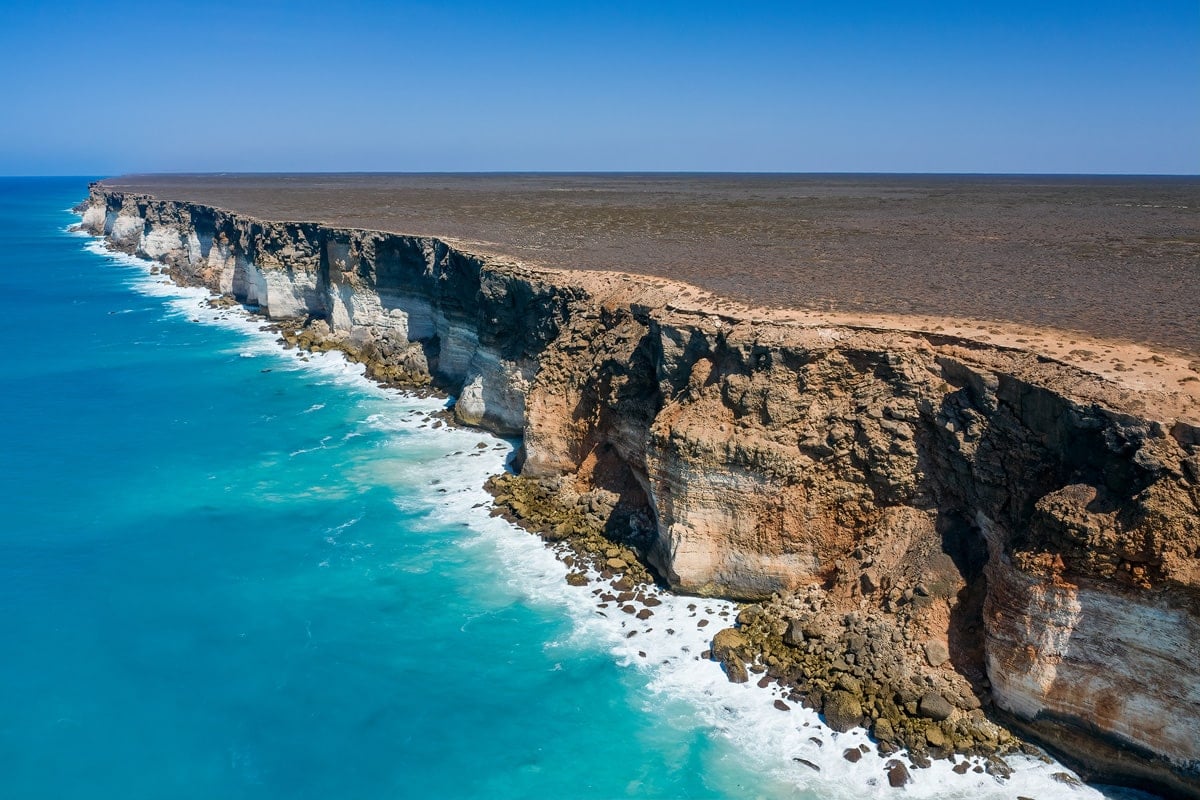
10 Incredible South Australia Road Trips
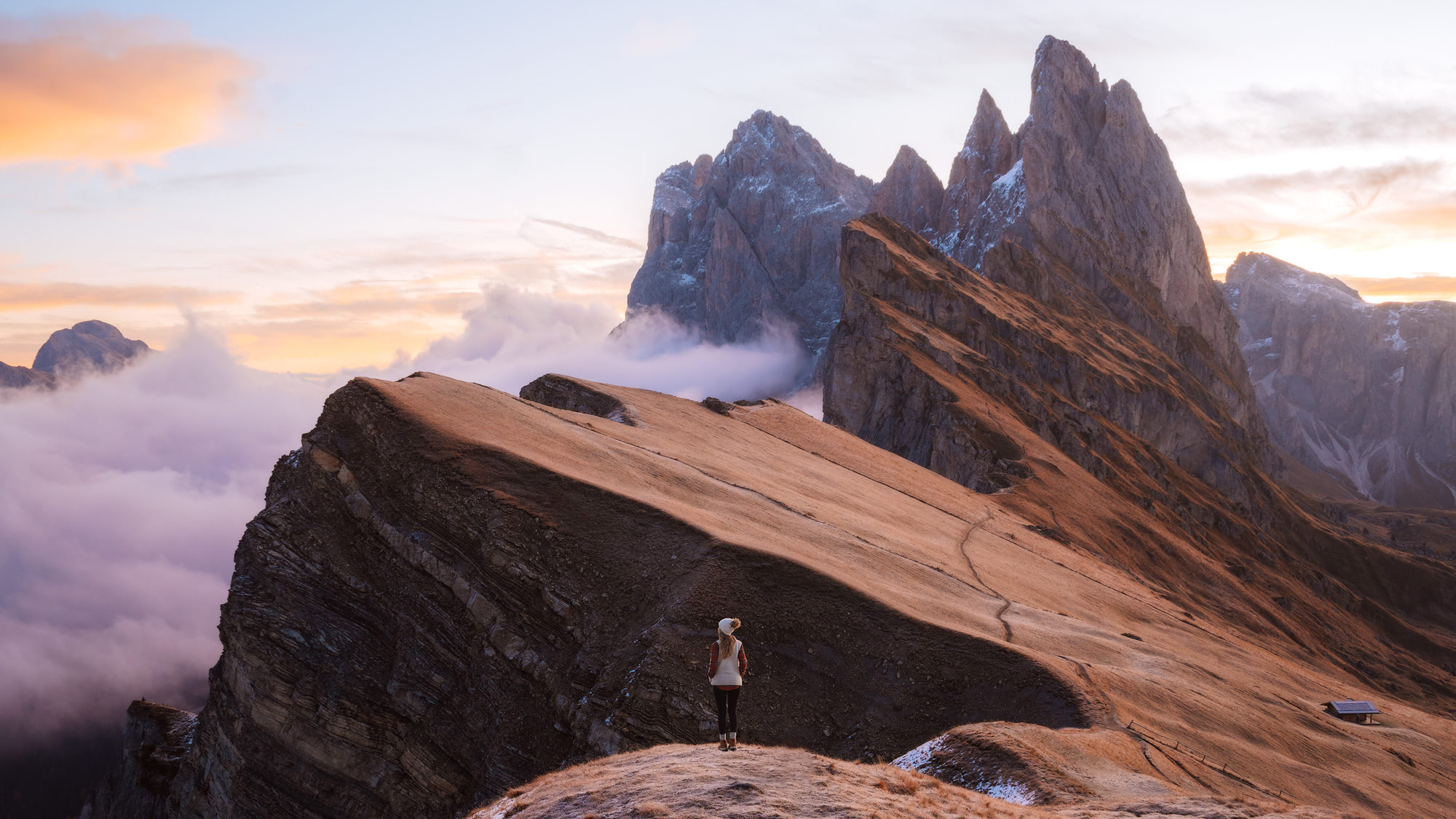
2019 Reflections and 2020 Intentions
Join our mailing list for exclusive resources, events, and more.
Thank you for subscribing!
Hi Renee! This guide is stunning!! Would you recommend stopping in Papeete for 3 days on the way back to Seattle from New Zealand? We are trying to decide if that would be enough time to enjoy the best parts of Tahiti, or if we should book a separate trip to Tahiti and visit Bora Bora and other islands! Thanks!
Wow, first of all your article is very complete and interesting. But if I wanted to leave a comment, it’s to say that your photos are just gorgeous. Simply awesome!
This is a great guide! What do you think is the cost to go for a couple? Maybe in the medium to high range?
Leave a Reply Cancel reply
Your email address will not be published. Required fields are marked *
This site uses Akismet to reduce spam. Learn how your comment data is processed .
Follow Along on Instagram
Best Time to Visit Tahiti
Customers rate Zicasso's travel referral service 5 on a scale of 1 to 5 based on 1541 reviews on Trustpilot
We match you with top tour companies that specialize in the trip you want, whether it's a customized private tour or a group tour.
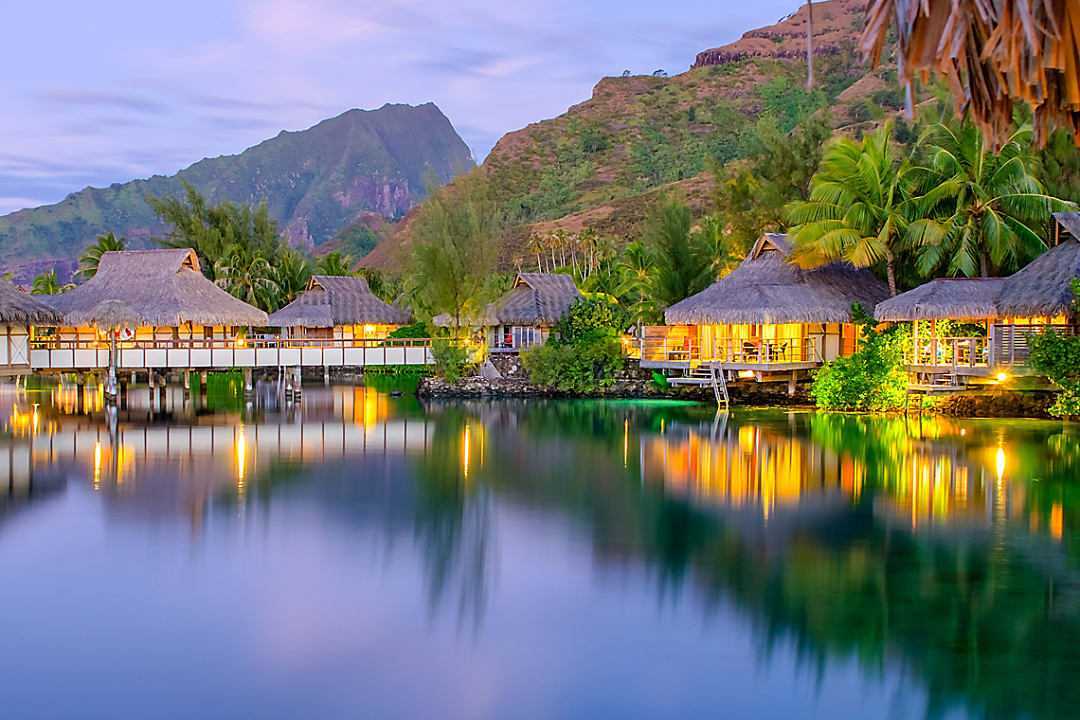
Tahiti Island
The best time to visit Tahiti is between May and October, the island’s dry season, when the weather is perfect for enjoying the beach and there is little rain.
Your ideal vacation dates will change depending on your travel preferences and expectations, but the dry season remains the best time to visit Tahiti for great weather and to escape the crowds. During these months travelers can enjoy the sun-washed beaches, crystal-clear seas, and illustrious atolls of the island and French Polynesia.
We share everything you need to know about the best time to visit Tahiti, depending on your preferred travel goals, who you will be with, and what you can expect from the French Polynesian island.
Best Time for Great Weather
Best time for families with children, best time to avoid the crowds, best time for couples or honeymooners, book for the best time in tahiti.

Tahiti on a sunny day
Best Months: May | June | July | August | September | October
The dry season months of May through October are the best time to visit Tahiti on vacation if you wish to enjoy great weather. During this time average temperatures range from the upper-60s to the mid-80s Fahrenheit.
These conditions are perfectly suited for beach getaways in the French Polynesian region and seaside experiences in Tahiti. You can stroll along the sun-kissed shores and look out across the sapphire sea without a single cloud in the sky as you soak up the tropical charms of Tahiti’s breathtaking beaches.
Expert Tips for Discerning Travelers

Tahiti is the perfect place for a tropical family vacation and the best time to visit the island for families with children is in the dry season of May to October.
The reason this time is particularly appealing to families with children is that there is less humidity than in the wet season. In saying so, outdoor adventures across the island and water sports on its spectacular beaches are comfortable for children of all ages.
By visiting during the fringe months of this season you can avoid crowds that typically gather between July and August.

Best Months: May | June | September | October
The best time to avoid the crowds on a vacation to Tahiti is during the months of May, June, September, and October. These fall within the popular dry season, but lie on the cusp of the peak travel season of July and August.
When traveling during these months adventurers can find quieter beaches to swim in the gorgeous seas, partake in thrilling island activities that are usually overrun with tourists, and enjoy the benefit of great accommodation and tour deals, as the Tahiti tourism industry looks to attract visitors.

Any time within the dry season of May through October will be the perfect time to visit Tahiti for couples or honeymooners. During this season the weather is superb and the sunshine will invite you to explore the island’s best beaches and hidden coves.
If you travel during the months of May, June, September, and October you will be treated to experiences without major crowds. During these months couples can embrace the pleasure of Tahiti when the sparkling shores are quiet, the island activities are free of overwhelming crowds, and the glamorous resorts offer incredible honeymoon specials.
Learn more: Best Tahiti Honeymoon Packages
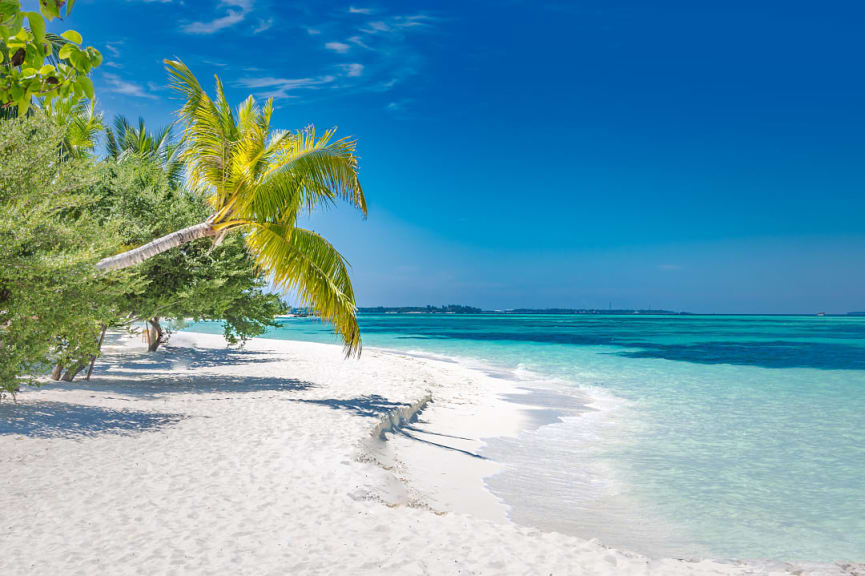
The best time to visit Tahiti on vacation is during the dry season months of May through October, when the weather is perfect for exploring the golden beaches, you can escape the immense crowds, and accommodations and tours offer reasonable packages and deals.
If you wish to spend your vacation on the sunbathed beaches of Tahiti, then check out our sample itineraries on our Tahiti Vacations or chat with a Tahiti travel specialist to learn more. Feel free to learn more about planning your custom trip by calling us at 1-888-265-9707 to speak with a Travel Care Specialist about your tropical getaway to Tahiti.
Life-Enriching Travel Designed Just for You
Trips curated by the world’s top destination experts
Concierge-level service leading up to and during your trip
Unique, exclusive experiences and insider access
Help Me Plan My Trip
Get Top Travel Specialists to Help Plan Your Trip


8 Reasons Why July Is the Best Time To Visit Bora Bora
B ora Bora is a part of a group of islands in French Polynesia, located in the South Pacific. The collection of islands is closest to Tahiti and Hawaii and has a reputation that rivals the two neighboring tropical paradises. Bora Bora is one of 118 islands in French Polynesia, famous for its vibrant culture and beauty. It is well known for its clear turquoise waters and other captivating natural attractions. It has even been the filming location for many movies , which showcase its breathtaking beauty. In July, travelers get to enjoy immersive cultural experiences, pleasant weather, fun activities , and luxurious accommodations . Learn more about why July is the best time to visit Bora Bora compared to other times of the year.
Average Temperature This Time of Year
- 70-80 Degrees F
Weather
Since much of the tourism appeal of the island comes from sunny skies and water, it would be wise for travelers to visit when they can fully experience the best of Bora Bora. July is also a time when Bora Bora experiences the least amount of rain. This month is during the dry season so travelers should not be rained on during outdoor island activities. There is an average precipitation of a little over two inches in July, significantly less than the wet season which often sees 12 inches of rain during months like January.
Travel Tip :
- The weather of Bora Bora is pretty consistent. Travelers can expect a little wind in July, but it keeps the island’s humidity down. If your vacation hairstyle is not wind-friendly, be sure to bring a sun hat or outfit-matching scarf.
Hiking Mount Otemanu
Mount Otemanu is the remnants of an ancient volcano that sits above a lagoon. The mountain reaches 2,385 feet and is a beautiful sight to see. This majestic peak is one of the most famous attractions of Bora Bora. Hiking Otemanu is peaceful since the terrain is not too difficult, but travelers should hire a guide for a smooth adventure. While the hike is not difficult, technically people do not even scale the peak. They simply climb up the “shoulders” of the mountain. Bora Bora’s Mount Otemanu can be seen from an array of vantage points for travelers that may not prefer hiking it. Some of the other popular ways to experience Mount Otemanu include catamaran trips, helicopter rides and boat tours. The most immersive experience for travelers is hiking the mountain. This is especially enjoyable in July when the weather is very pleasant.
- A sunset hike at Mount Otemanu may be the perfect way to kick off a romantic evening for couples visiting Bora Bora during their honeymoon.
Underwater Aquatic Activities
Bora Bora is popular for its crystal-clear waters, making it a great place to enjoy aquatic activities. The turquoise waters also make it easier to see the native marine animals that visitors may be lucky to get a glimpse of. Some marine species that travelers may see in Bora Bora’s waters include sea turtles, clownfish, manta rays, angelfish, various sharks, and parrotfish. There is also an extensive coral reef system that surrounds Bora Bora. The Coral Gardens, which are the northern tip of Bora Bora, are where many tours take place. Underwater visibility is high in Bora Bora so visitors will not have a hard time finding things to do in the island’s calm waters. Popular activities include snorkeling, scuba jetting, diving, and underwater scootering.
- Travelers should be accompanied by a guide in areas with significantly shallow waters if they are engaging in aquatic activities since there is likely to be coral. A great way to capture aquatic adventures is by purchasing an underwater camera before setting out on the water.
Cultural Events
While there are sure to be many events occurring on the island in July for visitors, there is one that travelers should take note of. The Heiva Festival is the annual festival that is celebrated in Bora Bora. The Heiva Festival, which dates back to 1881, is an annual festival of song and dance and translates from Tahitian to “the celebration of life.” It is a huge event throughout French Polynesia. In Bora Bora, the festival is celebrated from mid-June until mid-August. July is technically the peak of all the festivities and the best time to visit Bora Bora to experience Polynesian culture. Travelers can interact with locals as they prepare to build carnival stalls with woven palm frond walls decorated with flowers and leaves. At the festival, there is a full show that exhibits Polynesian culture. There are competitive dance performances, Himene (traditional songs), baraque (pop-up restaurants), and traditional sports.
- Travelers who want to thoroughly enjoy the Heiva Festival in Bora Bora should stay on the mainland to save on transportation costs to islets and have easier access to festivities.
Whale Watching
Enthusiasts who appreciate the giants of the ocean will make unforgettable memories in Bora Bora. The best time to see whales in Bora Bora starts in July so travelers have a great chance of encountering the intelligent marine animals. French Polynesia is a sanctuary for whales as they migrate north for warmer water. They do this so that they can give birth after a year of pregnancy in Antarctica. Marine sightings in July are likely since whales swim closer to shore during this time. Travelers may be able to have an intimate encounter with the gentle creatures if they take a boat tour. Humpback whales are the most commonly seen whales around this time.
- Travelers going on a whale-watching tour in Bora Bora should ensure that they book with a touring company registered with the Environment Department. These tour companies, like Bora Ocean Adventures, are equipped with technology like hydrophones which safely locate the whales.
Overwater Bungalows
Overwater bungalows originated in French Polynesia. They are cultural fixtures that promote natural ventilation and sustainability, so it is only natural that they are still popular. However, many of the overwater bungalows in Bora Bora standing today are luxury accommodations. Many full-service luxury resorts have overwater bungalows throughout Bora Bora. These spacious villas have ideal views of surrounding mountains and marine life due to their perched positions. Many of the villas have opportunities for snorkeling right next to them. Higher-end overwater bungalows have their own pools, nearby spas, hot tubs, and glass viewing panels on the floor.
- St. Regis Bora Bora Resort is a popular choice since they have the largest overwater bungalows in French Polynesia.
World Class Beaches
The white sand beaches of Bora Bora are super photogenic. Travelers visiting in July should be sure to visit the beach, even if they stay in an overwater bungalow. Beaches in Bora Bora are world-famous and are the perfect setting for watersports or simply lounging. The water temperatures of Bora Bora’s beach water typically stay between the mid-70s and mid-80s. These temperatures mean that travelers are guaranteed comfortable water conditions. Travelers who do not swim or prefer to stay dry can enjoy the beach by taking a stroll or reading an intriguing book by the water.
- Matira Beach is one of Bora Bora’s most popular beaches due to its scenic views and amenities. There are resorts, restaurants, and shops surrounding Matira Beach and it is the largest public beach in Bora Bora.
ATV Tours of Mont Popoti
One of the most popular land excursions in Bora Bora is an ATV tour of Mont Popoti. Mont Popoti is a mountain with a 360-degree view of Bora Bora. Popoti has much better terrain for rugged exploration, so travelers who enjoy exhilarating experiences should try an ATV tour. The tours typically take around four hours and start early in the day. Travelers can discover paths, view sacred mountains, search for caves, and enjoy the stunning views of Mont Popoti. This excursion is popular for groups since at least two people typically ride each ATV. Water, juice, and a boat transfer from the mainland are usually included in ATV tour bookings.
- Travelers discovering their inner explorer with an ATV tour in Bora Bora should wear closed-toe shoes and sunscreen, and ensure they have their driver’s license to enjoy this activity.
Bora Bora in July offers some of the best of French Polynesia’s natural beauty, local culture, and top activities and attractions. Travelers should not hesitate to book their place to sit back and relax in Bora Bora during the summer, a tropical paradise that travelers will surely enjoy.


IMAGES
VIDEO
COMMENTS
The best time to visit Tahiti is between June and September — the best part of the dry season with milder temperatures, lower humidity, and moderate prices on the luxe resorts and hotels on the island. Opt to visit between November and February for the cheapest prices on flights and hotels — as little as $174/night on average with flights ...
The best time to visit Tahiti is between May and October. Although the temperatures are balmy year-round, Tahiti's winter season enjoys less humidity. Tahiti really only experiences two distinct ...
As such, tourist density becomes quite heavy during July. This will be the priciest, most busy month to visit. It is best advised to avoid this month if you can. Especially if you're planning a special event of any kind or are looking for a quiet vacation. Average Temperature (high/low): 82.9F/69.4F.
During the high season, or winter, temperatures range from 70-82 degrees Fahrenheit, while in the low season, summer, temperatures vary from 70-85 degrees Fahrenheit. December and January average 12 inches of rain a month, however, Tahiti receives more hours of sun than Hawaii during the comparable humid season.
Winter in Tahiti is from June through September, and this is one of the best time frames to book a trip. August usually gets the least rainy days, making it one of the most enjoyable months to visit. The winter months can be the most comfortable in Tahiti because you won't have to deal with the humidity.
What is the best time to visit Tahiti? The Queen Island of French Polynesia can be visited at any time of the year. Its tropical climate guarantees warm temperatures between 25 and 32°C and the water temperature remains constant. Tahiti has a dry season and a wet season. Depending on the period, the price of a trip to Tahiti may decrease or ...
First timers: On their virgin visit to French Polynesia, travelers typically stay for seven to 10 days and stick with a circuit of three islands: Tahiti, where you may have to stay overnight upon arrival or prior to departure, depending on flight times; Moorea, a lush, emerald-hued island located just a short flight or ferry ride away from Papeete; and Bora Bora, the crowning glory of the ...
The Islands of Tahiti have a very pleasant tropical climate all year round, with constant temperatures and lots of sunshine. There are only two seasons, and both of them are the best time to visit - it all depends on you. A tropical climate. Every day is summer in The Islands of Tahiti! There are actually two seasons, dry and rainy.
Tahiti has a tropical climate with high temperatures and humidity year-round, but the weather can vary depending on the time of year. The dry season, which runs from May to October, is generally considered the best time to visit Tahiti, as it is cooler and less humid, and there is less rain. During this time, the average temperature ranges from ...
The best times to visit Tahiti for ideal weather are. June 4th to September 2nd. ... Weather is perfect this time of year in Tahiti to be enjoyable for warm weather travelers. The average high during this season is between 88.7°F (31.5°C) and 87.4°F (30.8°C). On average, it rains or snows a great amount: 8 to 13 times per month. ...
The best time to visit Tahiti is between May and October. Although the temperatures are balmy year-round, Tahiti's winter season enjoys less humidity. Tahiti really only experiences two distinct ...
Tahiti, known for its pristine beaches and idyllic weather, is a dream destination for many. However, timing your visit can greatly enhance your experience. This article delves into the best time to visit Tahiti, focusing on ideal weather conditions and avoiding the crowds, particularly for those planning a romantic getaway to Bora Bora.
Tahiti. French Polynesia, Australia & Pacific. What Tahiti lacks in wide white-sand beaches, it makes up for in waterfall-laden, shadowy mountains, unpretentiously beautiful black-sand beaches, sheltered blue lagoons and a distinctly Polynesian, modern buzz. This is the heart of the islands, where the cultures from all the archipelagos are ...
These factors make May time of the year a good time to visit Tahiti if you want to avoid summer crowds from those living in the northern hemisphere. Average Temperature (high/low): 82°F / 69°F or 28°C / 21°C. Average # of Rainy Days: 5 rainy days. Recommendations: Begin looking for flights well in advance!
It's slightly cooler: temperatures range between 88°F and 70°F. For some, it's the best time to go to Tahiti: cheaper accommodation, deals on flights, fewer tourists. June. June is French Polynesia's winter, the start of its dry season proper, and also the beginning of the archipelago's busy tourist season.
Best Time to Visit Tahiti for Honeymoons: May to October. Best Time for Diving & Snorkeling: April, May, June, September, and October. Best Time for Outdoor Activities: June to September. Best Time for Saving Money: Avoid the peak seasons (July, August, and the Christmas/New Year period) when the islands are bursting.
December to March is the best time to visit on a budget. As Bora Bora's dry season comes to an end, the days start to get cloudier and there's an increased chance of rain. The temperatures creep up a little higher and the humidity kicks in. This change in the weather marks the low season for tourism, but this can be advantageous to travelers ...
The dry season between May and October is the best time to cruise Tahiti, Bora Bora, and French Polynesia. While there is no shortage of blue skies and sunshine throughout the year; there are more festivals, less humidity, and greater availability of cruise dates during these times. For those looking for fewer crowds, the shoulder months of May ...
Warmest month: February (81.5 °F) Coldest month: July (76.1 °F) The maximum water temperature in Papeete is 82.4 °F. You can take a bath at these temperatures. Months with water temperature of at least 70 °F (adequate for beach vacation): all months.
Best time of year to visit Tahiti. Balm, dry, and less humid period between May and October is considered to be the best time to visit Tahiti. Austral winter is known as a peak tourist season and lures travellers from all over the world to catch pearl harvest season, watch sharks, and do some diving and surfing.
Best time to visit Tahiti to enjoy the beach. Tahiti's dry season runs through May to October with average daytime temperatures of roughly 25 degrees Celsius. The afternoon and evenings are normally cooler. Planning your visit to Tahiti around this time despite the warm temperature and the high humidity will make you enjoy the cooler crystal ...
Once completed a receipt with an ETIS number will be issued by email. Print this and bring it to the airport. Obtain a negative RT-PCR COVID-19 test within three days of your international flight to Tahiti (any RT-PCR test listed on this FDA site is allowed). Print your negative results and bring them to the airport.
The best time to visit Tahiti is between May and October, the island's dry season, when the weather is perfect for enjoying the beach and there is little rain. Your ideal vacation dates will change depending on your travel preferences and expectations, but the dry season remains the best time to visit Tahiti for great weather and to escape ...
The collection of islands is closest to Tahiti and Hawaii and has a reputation that rivals the two neighboring tropical paradises. Bora Bora is one of 118 islands in French Polynesia, famous for ...
Hilton Tahiti and InterContinental Tahiti both have rooms from around $375 per night at press time—roughly a third lower than the typical rate for that time of year, and comparable to rates at ...